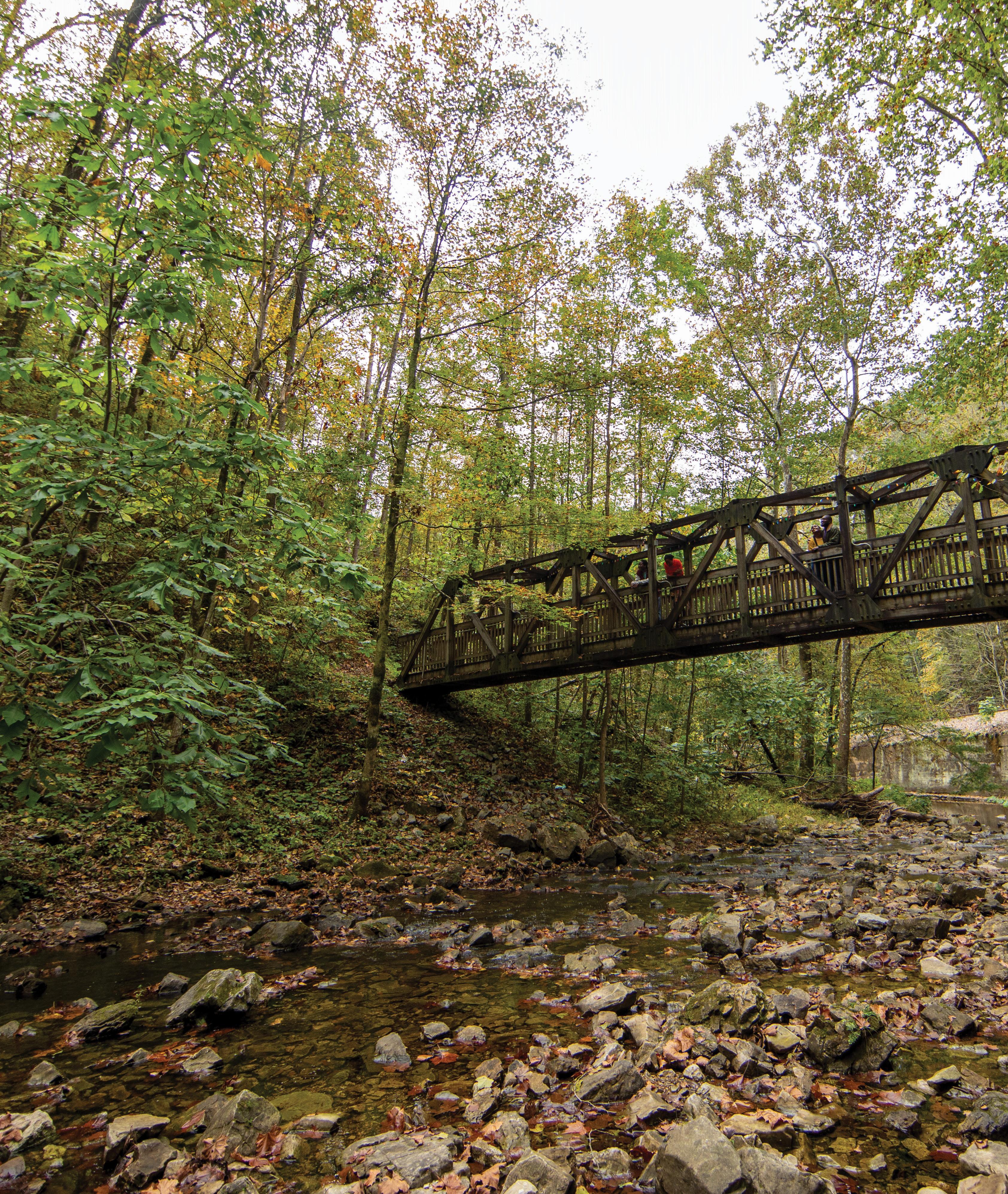










































PRESIDENT BLAKE DEMASO blake@blueridgeoutdoors.com
EDITOR IN CHIEF JEDD FERRIS jedd@blueridgeoutdoors.com
PUBLISHER LEAH WOODY leah@blueridgeoutdoors.com
ASSOCIATE PUBLISHER KATIE HARTWELL katie@blueridgeoutdoors.com
CREATIVE DIRECTOR MELISSA KENNELLY m.kennelly@blueridgeoutdoors.com
EDITORIAL & PRODUCTION
SENIOR EDITOR WILL HARLAN will@blueridgeoutdoors.com
GEAR EDITOR DOUG SCHNITZSPAHN doug@elevationoutdoors.com
DESIGNER/ART MANAGER REBECCA CENCEWIZKI art@blueridgeoutdoors.com
CONTRIBUTORS
DAVE STALLARD
GRAHAM AVERILL
ERIC J. WALLACE
COPY EDITORS
JULIA GREEN, ROBERT MCGEE
ADVERTISING & BUSINESS
ACCOUNT EXECUTIVE BUCK BRICE buck@blueridgeoutdoors.com
7
Meet the author of a new book encouraging others to embrace darkness.
The Art Loeb Trail is a hiker’s dream in western North Carolina.
Enough with the personal growth.
Hit the trails with this great new hiking gear.
66
Fresh tunes from American Aquarium and Amythyst Kiah.

ACCOUNT EXECUTIVE HANNAH COOPER hannah@blueridgeoutdoors.com
ADVERTISING CONTENT COORDINATOR AMANDA LIVERETTE amanda@blueridgeoutdoors.com
BUSINESS MANAGER MELISSA GESSLER melissa@blueridgeoutdoors.com
DIGITAL MEDIA
ONLINE DIRECTOR CRAIG SNODGRASS webdir@blueridgeoutdoors.com
CREATIVE CONTENT MANAGER SHANNON MCGOWAN shannon@blueridgeoutdoors.com
CIRCULATION INQUIRIES circulation@blueridgeoutdoors.com
ADVERTISING INQUIRIES advertise@blueridgeoutdoors.com
PUBLISHING 977 SEMINOLE TR PMB294 CHARLOTTESVILLE, VIRGINIA 22901
ASHEVILLE, NORTH CAROLINA
LAUREN STEPP MARY BETH SKYLIS MIKE BEZEMEK GOT A STORY IDEA OR COMMENT? submit@blueridgeoutdoors.com
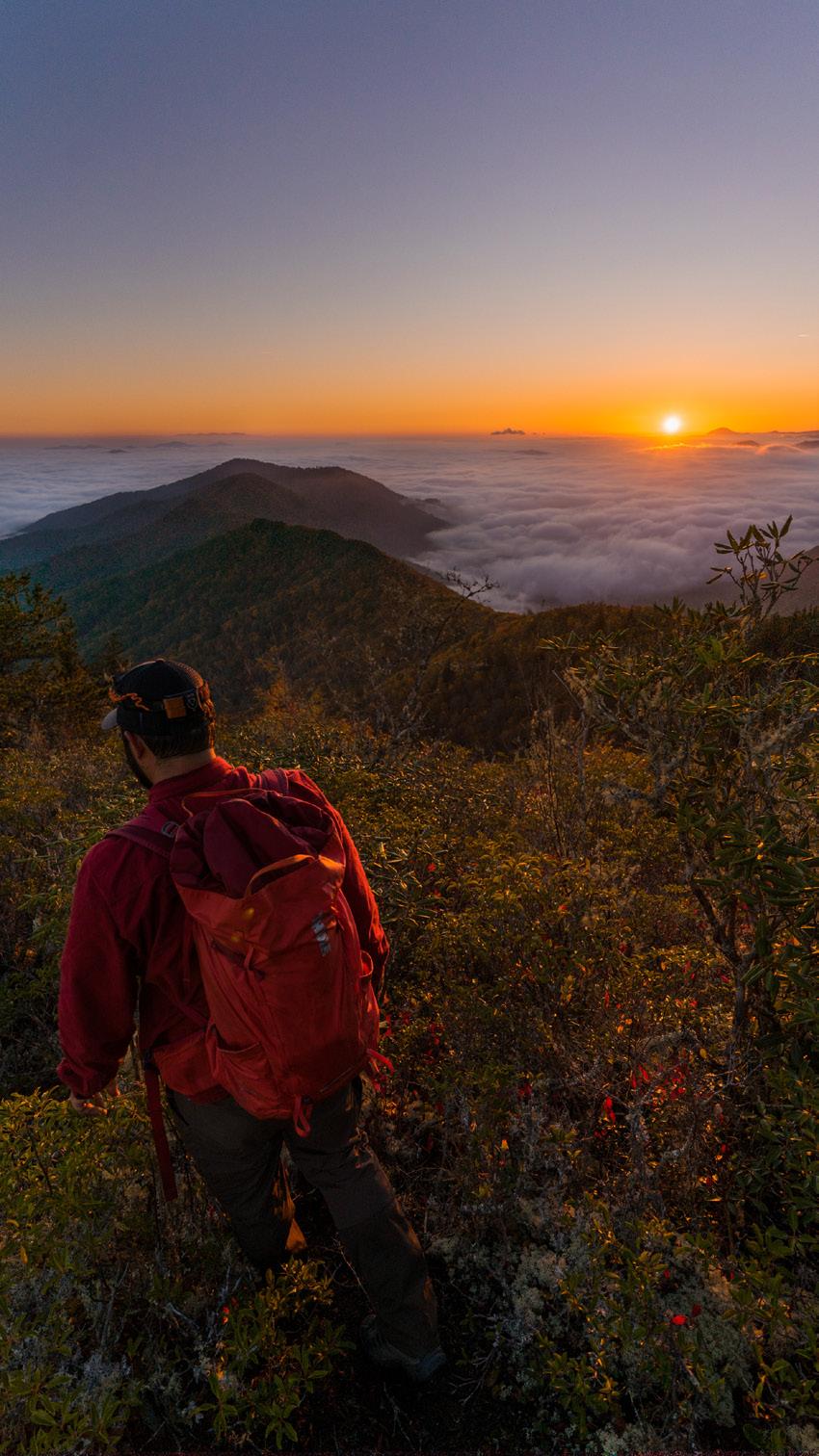
Wilderness medicine experts offer backcountry safety tips.
Our fall itineraries explore prime Appalachian Trail section hikes with comfortable amenities nearby.
Extensive efforts are underway to add highway wildlife crossings near the Smokies.
Following her thru-hike, a Black woman from North Carolina wants to make the Appalachian Trail a welcome space for all.
49 | SUMMITING OLD
This Shenandoah classic is always worth revisiting.
58
Weird ways to start a campfire.
We are the Southern Environmental Law Center, one of the nation’s most powerful defenders of the environment, rooted right here in the South. As lawyers, policy and issue experts, and community advocates and partners, we take on the toughest challenges to protect our air, water, land, wildlife and the people who live here. Together, we can solve the most complex environmental challenges right here in the South.

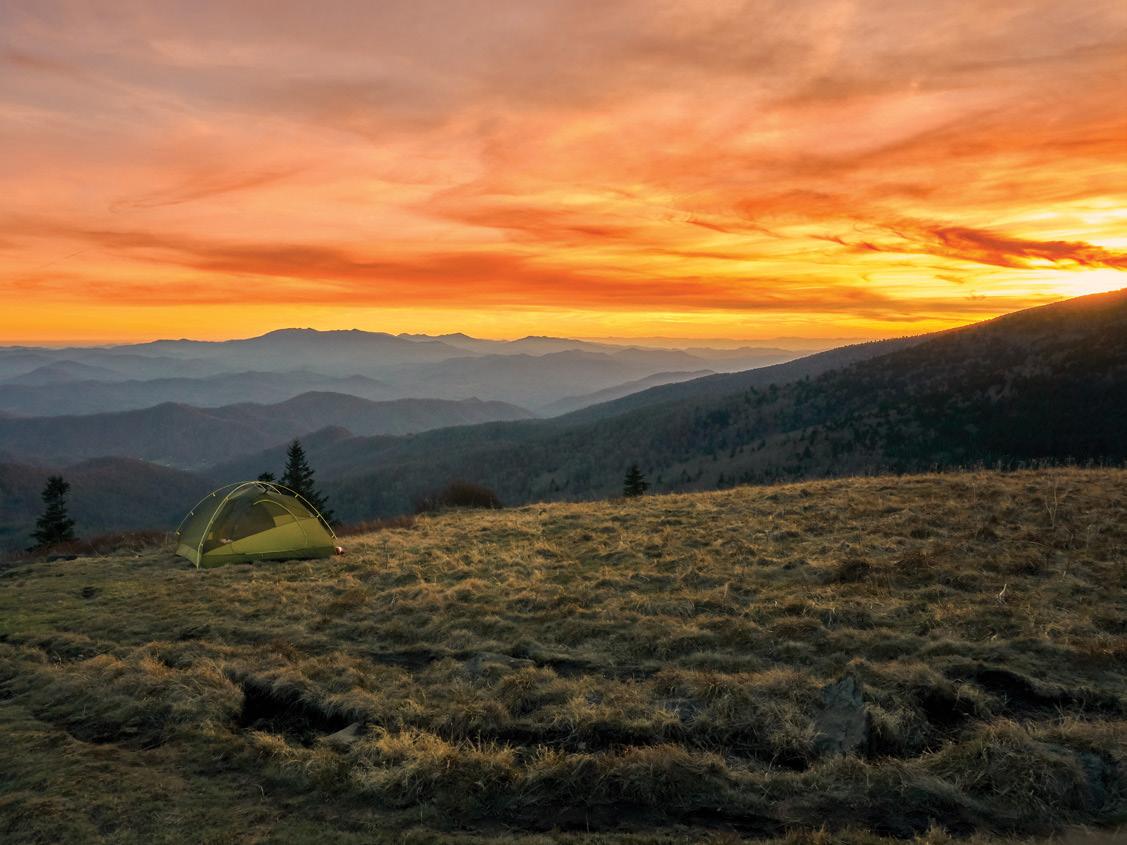


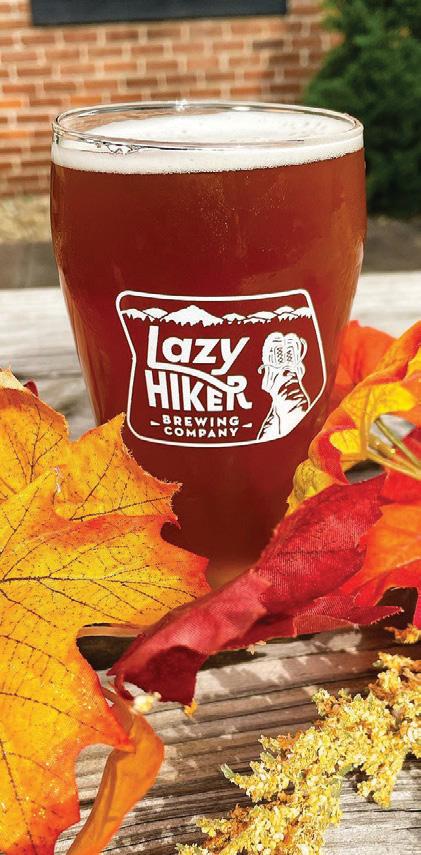
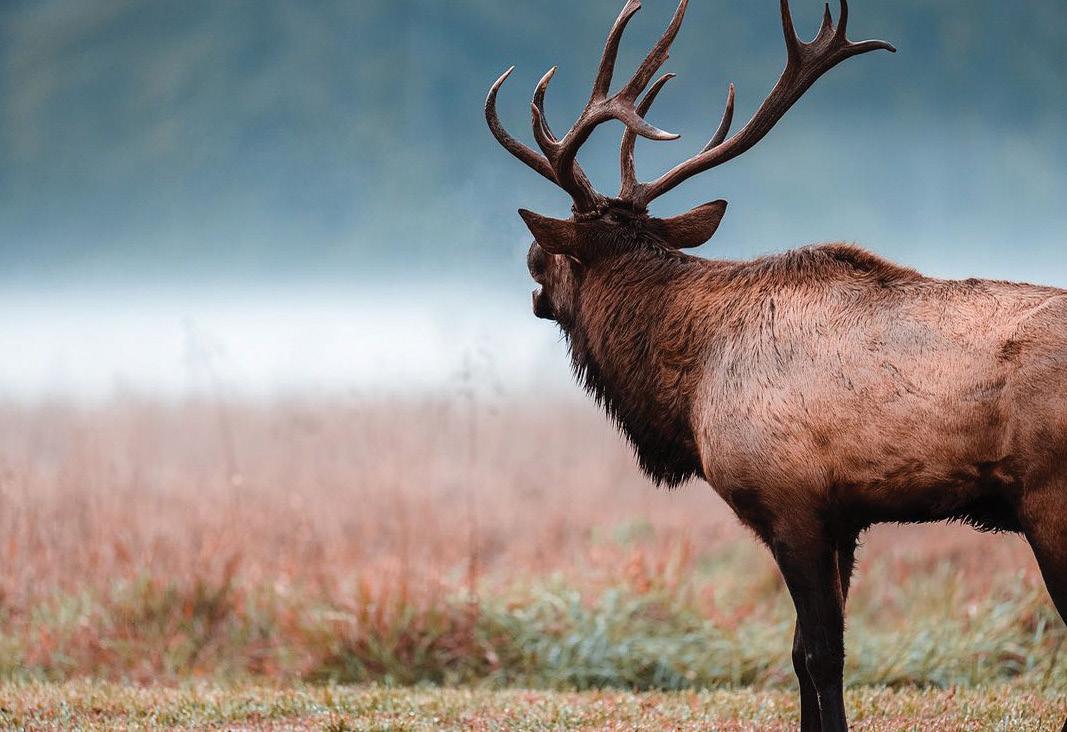
Jackson County, NC

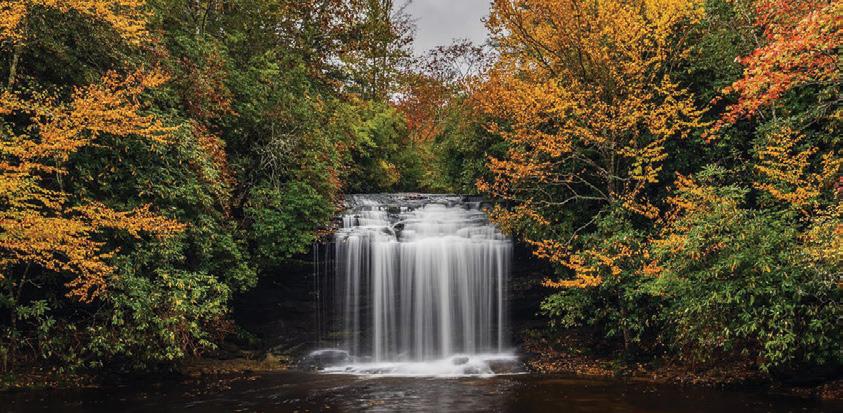
With dozens of hiking and biking trails, two national park sites, and Western NC’s official Fly Fishing Trail, Jackson County is our go-to destination when we’re craving adventure. When we go mid-week, there’s fewer crowds, so we’re able to soak up even more mountain magic. Whether we’re hiking the highest vertical cliffs in the eastern U.S. on Whiteside Mountain, standing in awe of the Shadow of the Bear, or taking in the rich fall hues while we dine alfresco, there’s always something exciting to sink our boots into.


BY KIM DINAN
NORTH CAROLINA NATIVE LEIGH
Ann Henion wasn’t expecting to fall in love with the darkness when she set out on a quest to find an elusive Appalachian firefly species. But that foray into the nighttime wilderness dawned a new realization for Henion: she needed a reconciliation with darkness.
Henion’s new book, Night Magic: Adventures Among Glowworms, Moon Gardens, and Other Marvels of the Dark, which came out in September, chronicles her attempt to re-center darkness by spending time with some of the diverse and aweinspiring life-forms that are nurtured by it. We spoke with Henion about what she learned by setting aside her fear of darkness and embracing the creatures and experiences that rule the night.

BRO: Your journey began with a quest to find an Appalachian firefly species. How did that experience lead you to learn about other creatures of the night?
LAH: I set out looking for the synchronous fireflies as a sign of hope in dark times, but I ended
up realizing that I needed a reconciliation with actual darkness. It was restorative to wander in darkness without even a flashlight.
I wrote a story about my experience with the fireflies and after the story came out, I was moved by how many readers reached out to let me know that it had inspired them to start turning off their porch lights more often. I was honored that my story led to actual action that reduced artificial light pollution.
It made me think about how we have the technology to make positive changes, yet we don’t always choose to utilize it. How do we change our habits? What makes people care? I’ve come to think that curiosity plays a large role. We’ve been told so many times to fight the dying of light that it’s almost countercultural to suggest that when we don’t turn the lights out, we miss out.
BRO: There are nighttime marvels around the world. Why did you choose to study creatures in Appalachia?
LAH: I chose to focus on Appalachia, specifically, because though darkness is a global connector, biodiversity is unique to place. This is my home region, my most beloved region.
I think it’s harder to find awe at home than it is in far-flung places where nothing can be taken for granted. But night makes everything new. It makes the familiar strange. In some ways, this book is a love letter to the region I love most on Earth, and—even though I live in an especially bio-rich place—I wanted to tell a story that would encourage people to look at their own most beloved places in a new way.
BRO: What was your favorite nighttime marvel?
LAH: I don’t know that I could
choose a favorite night marvel, but I will say that one of the greatest surprises and joys of this project was seeking something in other parts of Appalachia and ultimately discovering that whatever species I was looking for was also living in my very own neighborhood.
I was probably most surprised to discover Appalachia’s glowworm population, most famously concentrated in Alabama’s Dismals Canyon, but apparently present in patches all over southern Appalachia.
I’d previously only known about the famous glowworms of New Zealand. Realizing that you’ve been yearning to travel around the world to see something that lives in your hometown is a special sort of humbling.
BRO: Light pollution is a growing problem in the Southeast. Can you explain a bit about what we lose when we lose darkness?
LAH: When we lose darkness, we lose sleep, we lose health, we lose functional ecosystems, we lose species that depend on natural night for their own biological cycles and celestial navigation. But, after working on this book, I’ve come to understand that we’re also losing parts of ourselves that might not seem, at first, to be remotely related.
I’d never considered, for instance, that because I’ve spent most of my life under the influence of artificial light that I wasn’t familiar
with the full powers of my night vision. I’d never appreciated that my sense of smell was, like sleep and other bodily functions, influenced by circadian rhythm. And I certainly never imagined that spending time in the dark might have contributed to the development of human culture, or that blue light is potentially altering my mood and the way I interact with other people on a regular basis.
Electricity has been around for basically a split-second in the arc of human history. It’s easy to forget that. Knowing darkness has helped me become acquainted with parts of my human self that are getting drowned out in an over-lit world. We’re grappling with all kinds of things as a species, including the rise of AI. But we’re not robots; we’re animals, and we need the dark just like the myriad of other species living around us.
BRO: What’s one thing you want people to know about the magic of the nighttime?
LAH: I think reclaiming natural darkness is a way of reclaiming the natural world as enchanted. A lot of the experiences that people refer to as magical—the blinking of a firefly lantern and the twinkling of a star—require darkness. But pretty much every storyline in our culture suggests that darkness is something that we should avoid. I think that’s something that, at this point in history, we really need to reconsider.

Darkness is so often presented as a void, but night holds and fosters so much life. I hope this book will remind people that, though night has faded due to light pollution, it still exists. I try to focus not so much on what light pollution takes away but, rather, on what darkness stands to offer. When we turn down the lights, we can experience nighttime anew.


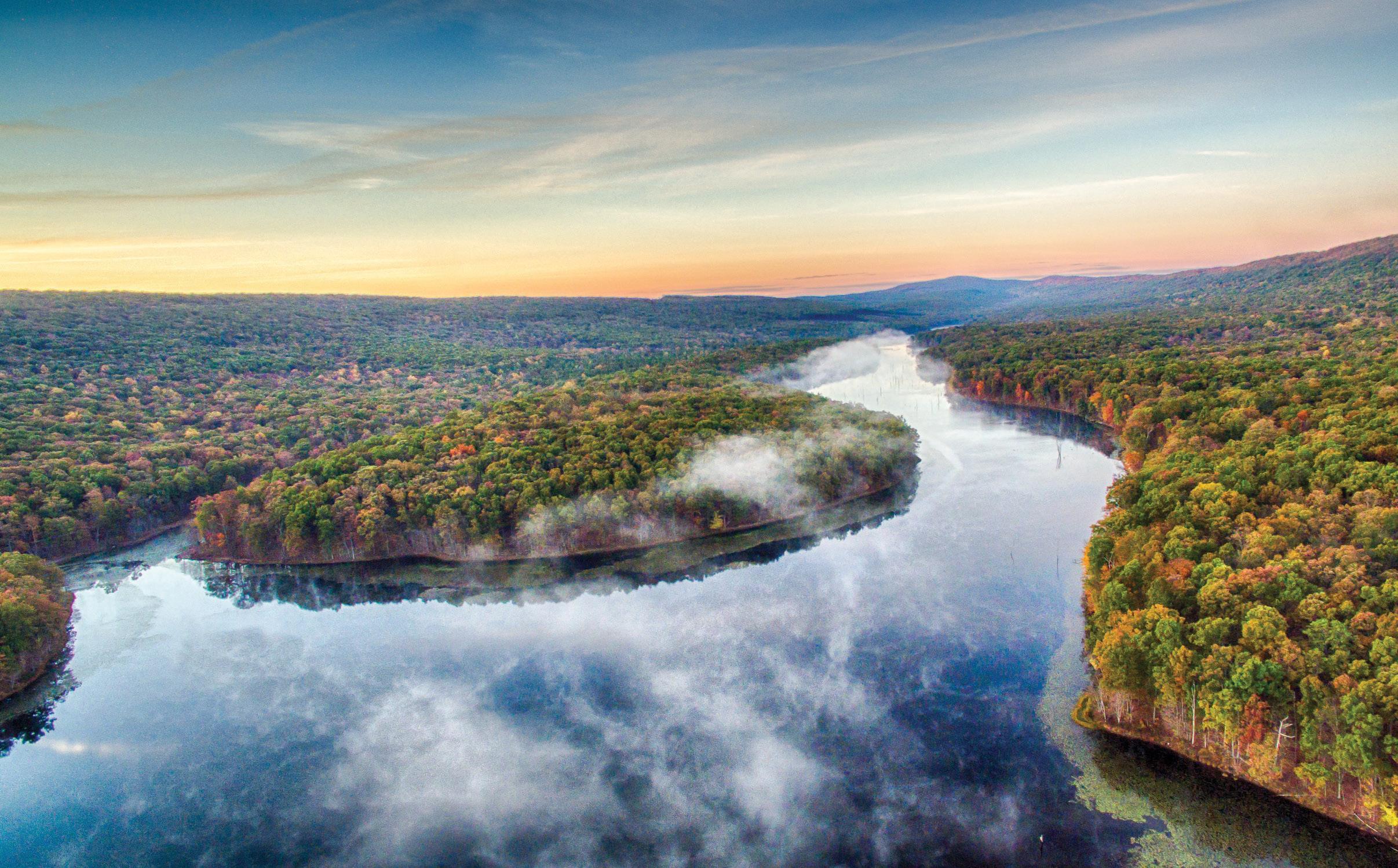
Miles of hiking, biking, and water trails are waiting to be explored in Berkeley County, West Virginia. Two Audubon Society managed preserves are the perfect locations for bird watchers to spend the day. Serene fishing spots, championship golf, and world-class geocaching make for the perfect adventure vacation.
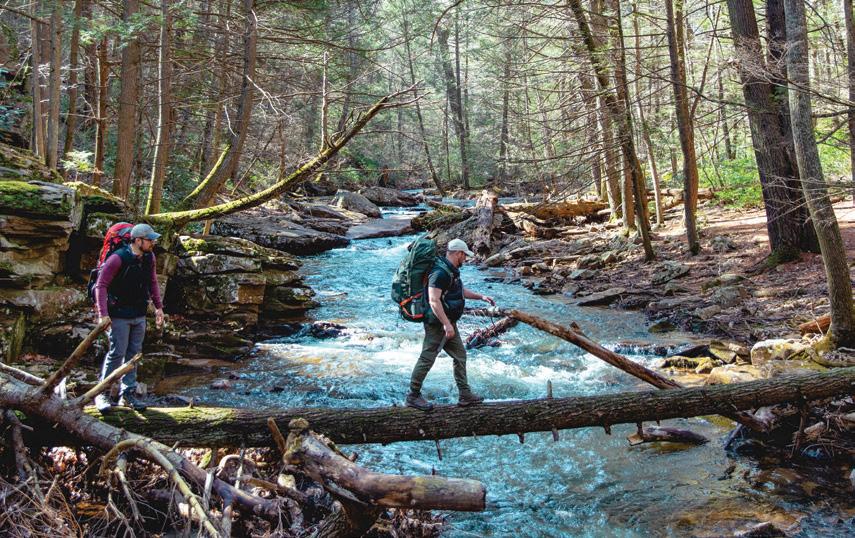




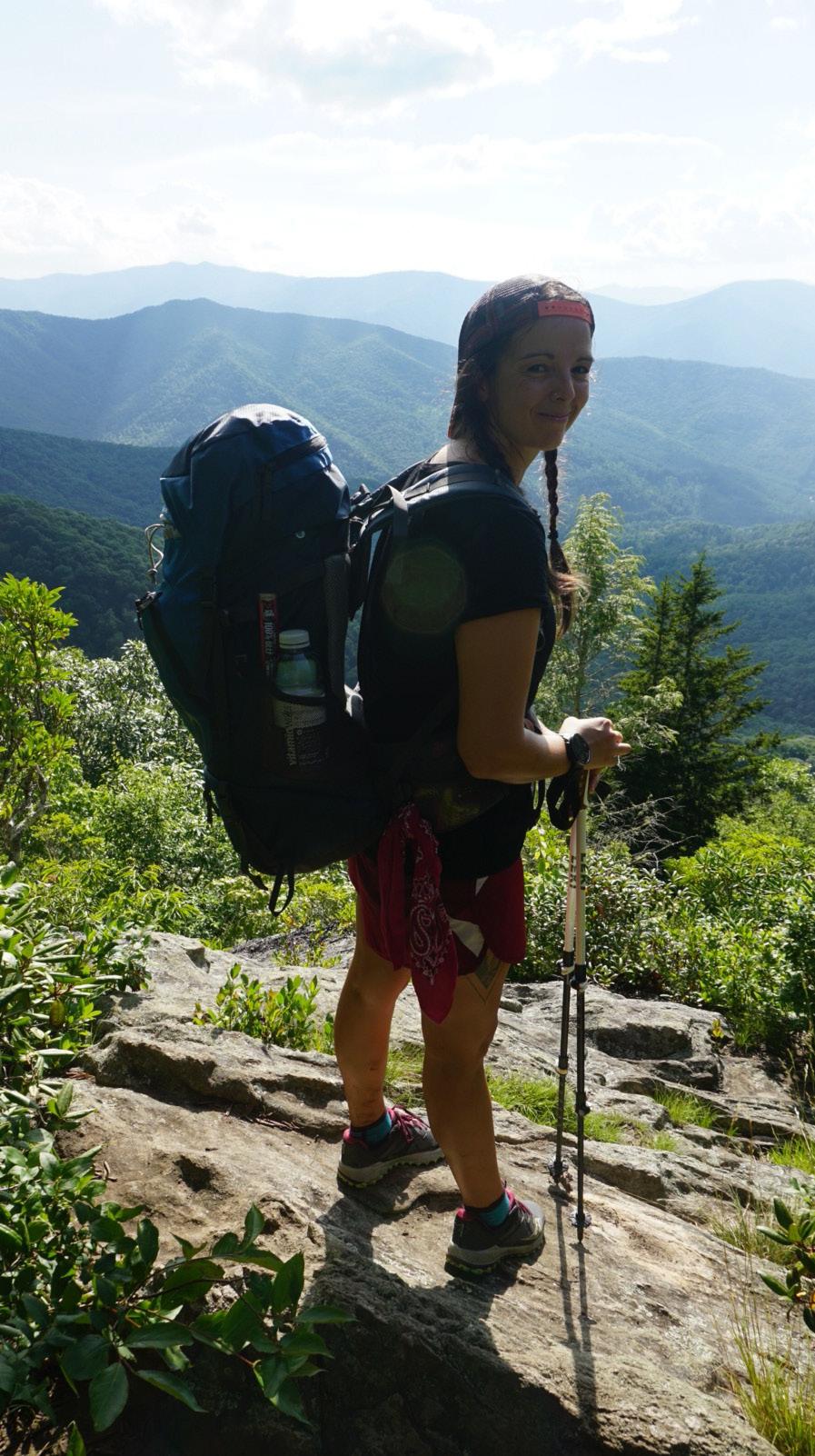
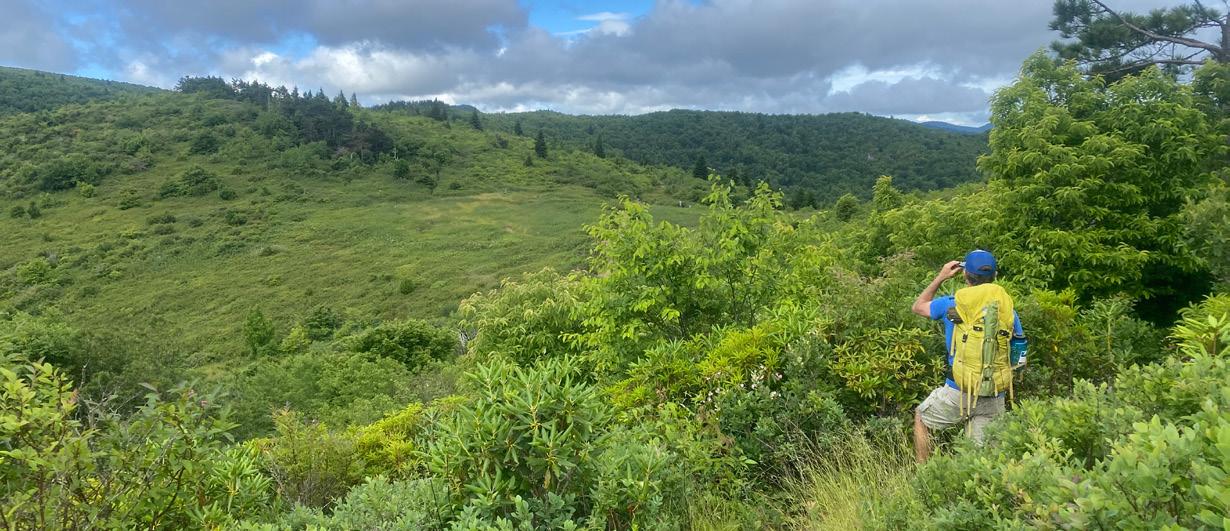

BY MARY BETH SKYLIS
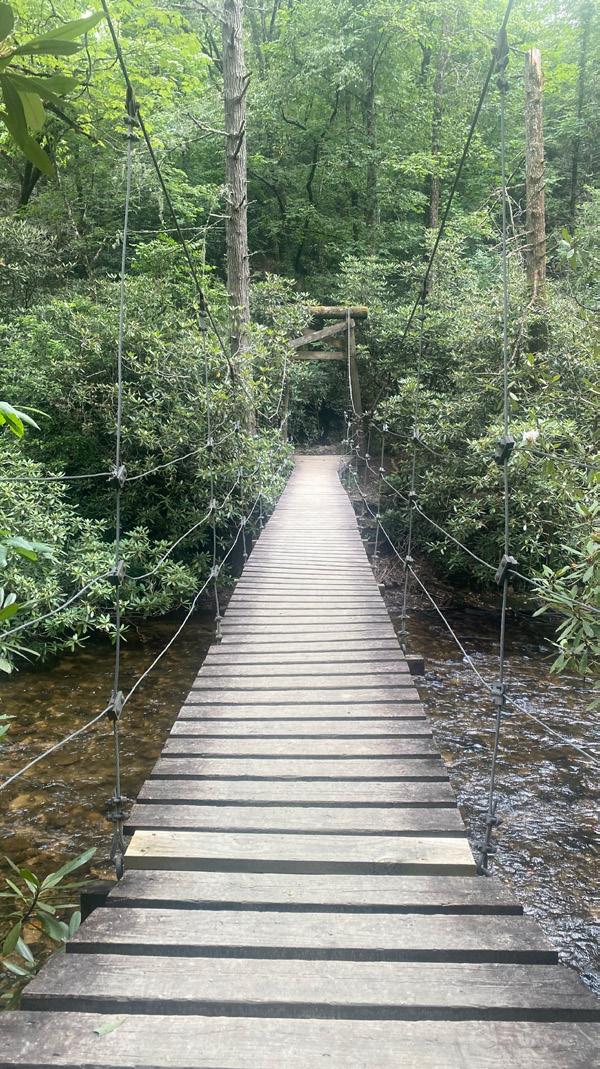
BLUE RIDGE BACKPACKERS LOVE the Art Loeb Trail for the 360-degree views of the surrounding mountains seen while hiking this 30.1-mile route that moves through some of the best terrain in Pisgah National Forest. But the stunning sights in this western North Carolina favorite are well earned. The trail’s south-tonorth route gains about 8,000 feet in elevation, while the north-to-south route requires about 7,300 feet of climbing. Along the way, hikers cross four different 6,000-foot peaks, including Black Balsam Knob, which is known for both its rocky terrain and beautiful vistas. Here’s a quick guide to hiking the Art Loeb Trail.
The Art Loeb Trail is a point-topoint hike, which means that you can either bring two cars or set up a shuttle to hike the entire trail. The latter option can be arranged with local outfitters like Pura Vida Adventures (pvadventures.com), which also offers guided day hikes and backpacking trips on the trail. Those who choose to bring their own vehicles usually leave one at the southern end of the trail, at the Davidson River Campground (1
Davidson River Circle, Pisgah Forest, N.C.). The second car goes to the Daniel Boone Boy Scout Camp (3647 Little East Fork Road, Canton, N.C.). Keep in mind that parking regulations often change in the area. Hikers can typically find a spot along the Little East Fork Road, south of the Boy Scout Camp.
The Art Loeb Trail is generally best hiked from spring to fall. The rocky, uneven trail and steep conditions make it a challenging route for even intermediate and advanced hikers. Backpackers typically take anywhere from two to five days to tackle the whole trail.
The trail is divided into four segments that are commonly used by locals for recreational day use. Section two covers Black Balsam Knob and is generally considered to be the most challenging segment, traveling 7.2 miles over steep and rocky terrain. Most of section three is above 6,000 feet, giving hikers amazing views along the way.
Water Sources on the Art Loeb
Depending on the time of the
season when you’re hiking, there are usually about half a dozen water sources along the Art Loeb Trail. The most accessible sources are located at the Butter Gap and Deep Gap Shelters, although the Deep Gap Shelter’s water source is located down a short side trail.
During the spring and early summer, hikers can find streams running both north and south of campsites near Black Balsam where they can collect and filter water. Many have luck at Gloucester Gap (where a stream is located about 250 yards off of the dirt road). Shining Rock Gap also features a water source that’s located a short walk down a set of steps.
Camping is fairly easy to find along the Art Loeb Trail, but it does get busy or even fill up during the summer. None of the campsites along the trail require reservations, instead operating on a first-comefirst-serve basis. Many hikers choose to camp at or around Butter Gap and Deep Gap Shelters due to the easy access to water. There are also a handful of dry campsites located north of Black Balsam, and a number
of fairly developed campsites along the trail. Pisgah National Forest’s dispersed camping guidelines apply in this region.
Cell phone service is unpredictable and often unavailable along the trail. For this reason, it’s important to download regional maps before setting out, and consider carrying paper maps for the journey. While most of the trail is easy to follow, there are a few places where trail intersections make it possible to get off-route.
The trail is dog-friendly, but pets must be kept on leash, and keep in mind that bears frequent the area. For this reason, when camping along the Art Loeb, bear canisters are required. Several local outfitters offer bear canisters for both purchase and rent, including French Broad Outfitters (canisters run $9 per day) and Blue Ridge Hiking Co. (where they cost $25 for the first day and $5 for consecutive days). The Forest Service also offers a first-come-firstserve canister borrowing program that is valid for up to seven days at a time.
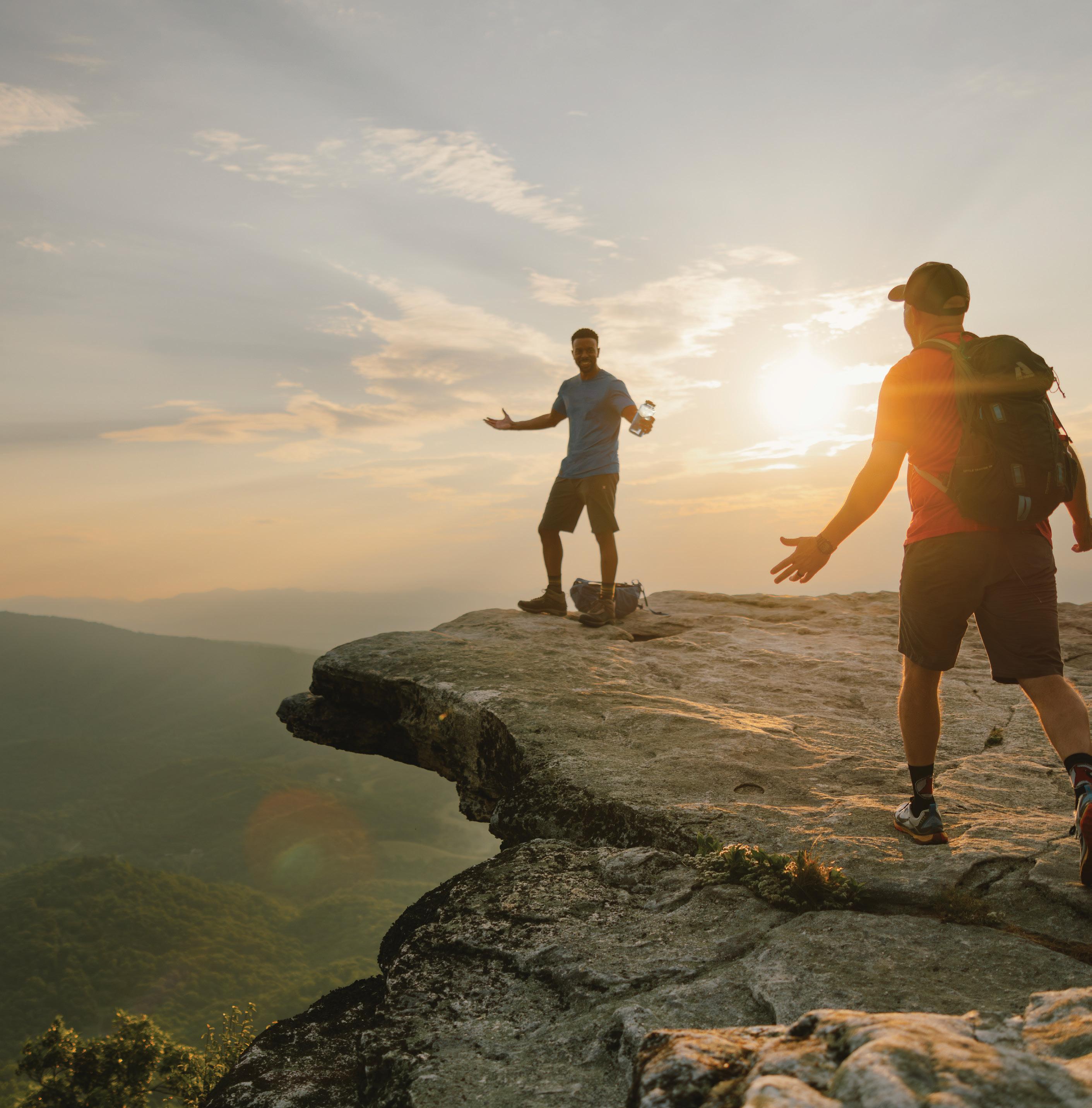




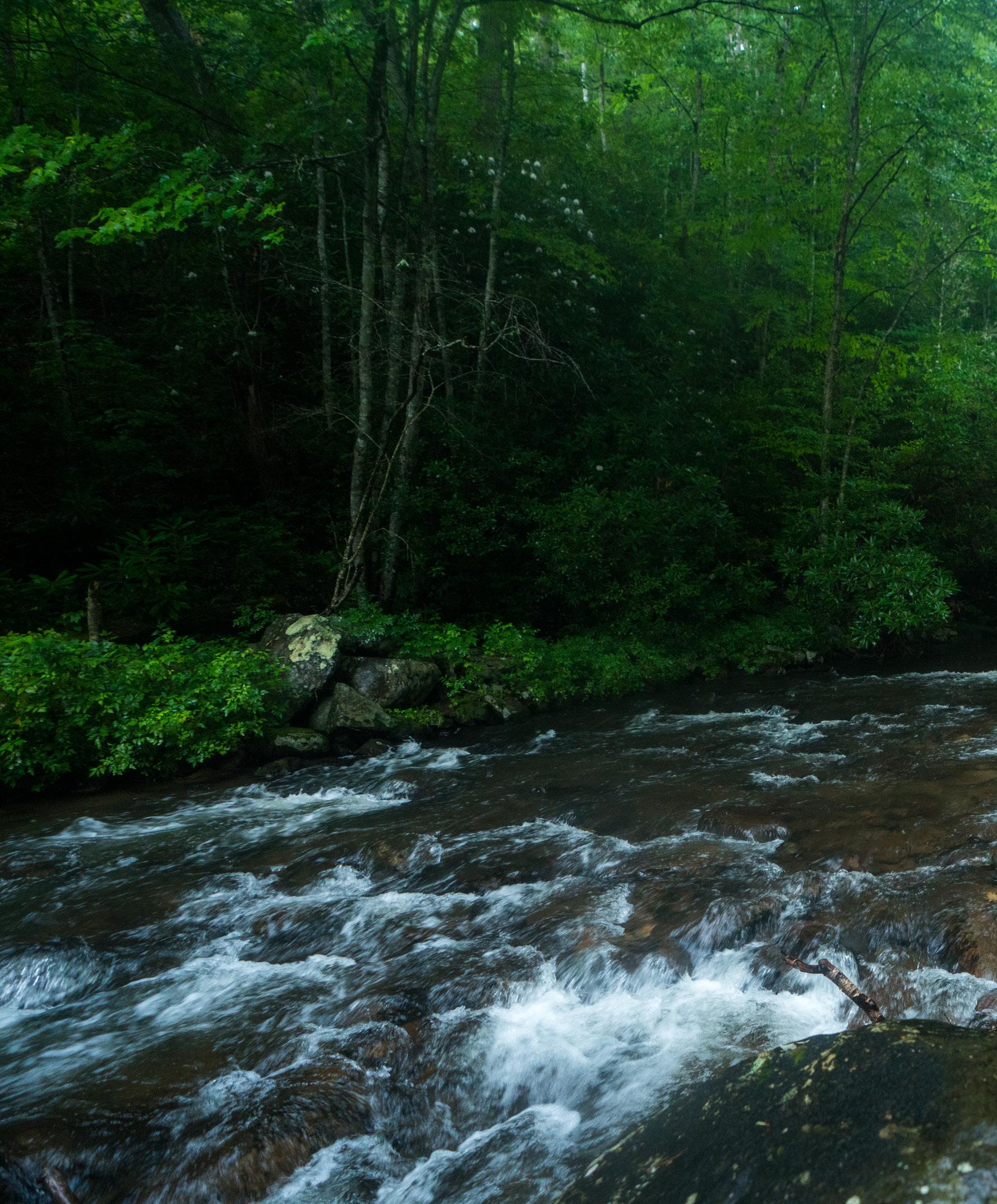
BY LAUREN STEPP
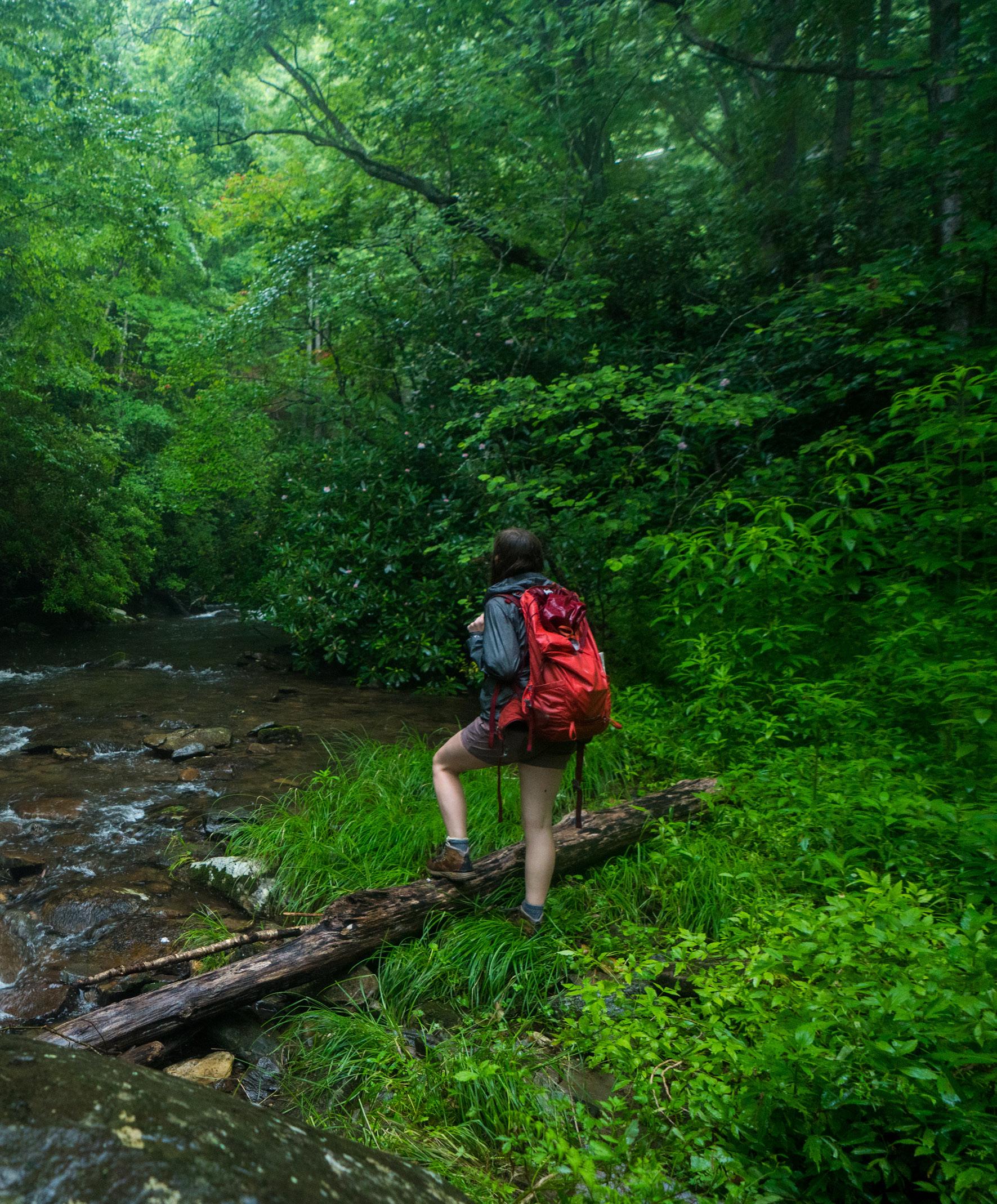
“There’s nothing more tragic than going into the backcountry to do something epic and dying in the process. Knowledge is power”


Lafroy Stevens’ journey to becoming a wilderness EMT began with a rattlesnake. It happened in 2017 on Hidden Rocks Trail in Dayton, Va. That summer, Stevens— who works as a public school teacher in Charlottesville—was overseeing a summer camp program for a local gym. As part of the program, she partnered with a guide service to take kids rock climbing.
On this particular occasion, the group was hiking to a popular crag when a nineyear-old boy needed to use the restroom. So, Stevens looked around and found a private spot. But before she sent the student into the woods alone, a little voice told her to scope it out.
“As soon as I stepped off the trail, I heard that distinctive rattle,” Stevens remembers. “About seven feet away, there was this beautiful timber rattler coiled up.”
That shook her.
“A warning bell went off,” says Stevens. “I just kept thinking, ‘What if he had gotten bitten? I have zero training.’”
Not long after, Stevens signed up for a wilderness first aid class with MEDIC SOLO, a wilderness medical school in Charlottesville. Today, she is a wilderness EMT and an instructor for the school.
From her training, Stevens has learned preparation is key for any outdoor adventure. Even casual day hikes can turn deadly if you get lost, twist your ankle, or become hypothermic.
“There’s nothing more tragic than going into the backcountry to do something epic and dying in the process,” she says. “Knowledge is power.”
With this in mind, we spoke with Stevens and other outdoor experts across the Southeast to learn more about how to stay safe in the woods. Here are the five outdoor survival skills they think every adventurer should master.
In 2017, when Stevens’ camper was


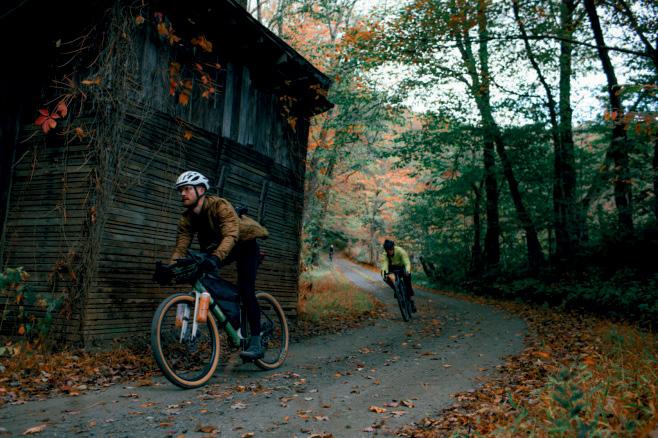

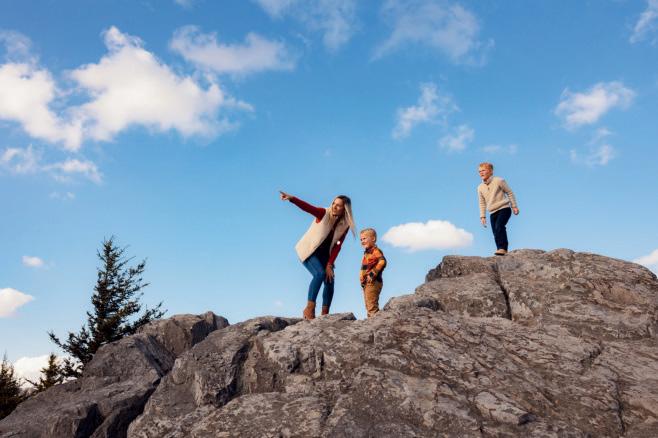



backcountry is pretty simple.
“Press around the wound to encourage some of the venom to come out,” she instructs. “Then, clean the outside of the wound, bandage it, and calmly walk to the front country.”
Once you have cellphone service, call 911 and get to the hospital. So long as you are healthy, you’ll recover just fine.
Other first aid skills like performing CPR, setting a splint, supporting a strain, and stopping bleeding are also invaluable. Understanding how to hydrate properly is another big one.
“There's nothing like being dehydrated out in the middle of nowhere,” says Stevens. “Then, you slip and fall because you’re woozy.”
As a general rule, you should consume about one half-liter of water per hour of moderate activity in moderate temperatures. Of course, if it’s hot outside or you’re participating in a strenuous activity, you should increase your water intake. “And also eat salty snacks,” says Stevens.
One day, while working in the Canadian bush, wilderness first responder Trey Walker received an SOS on his satellite phone. A group had hiked in and couldn’t find their way back out.
“They were lost because they didn’t adequately mark their maps in a remote part of the Canadian

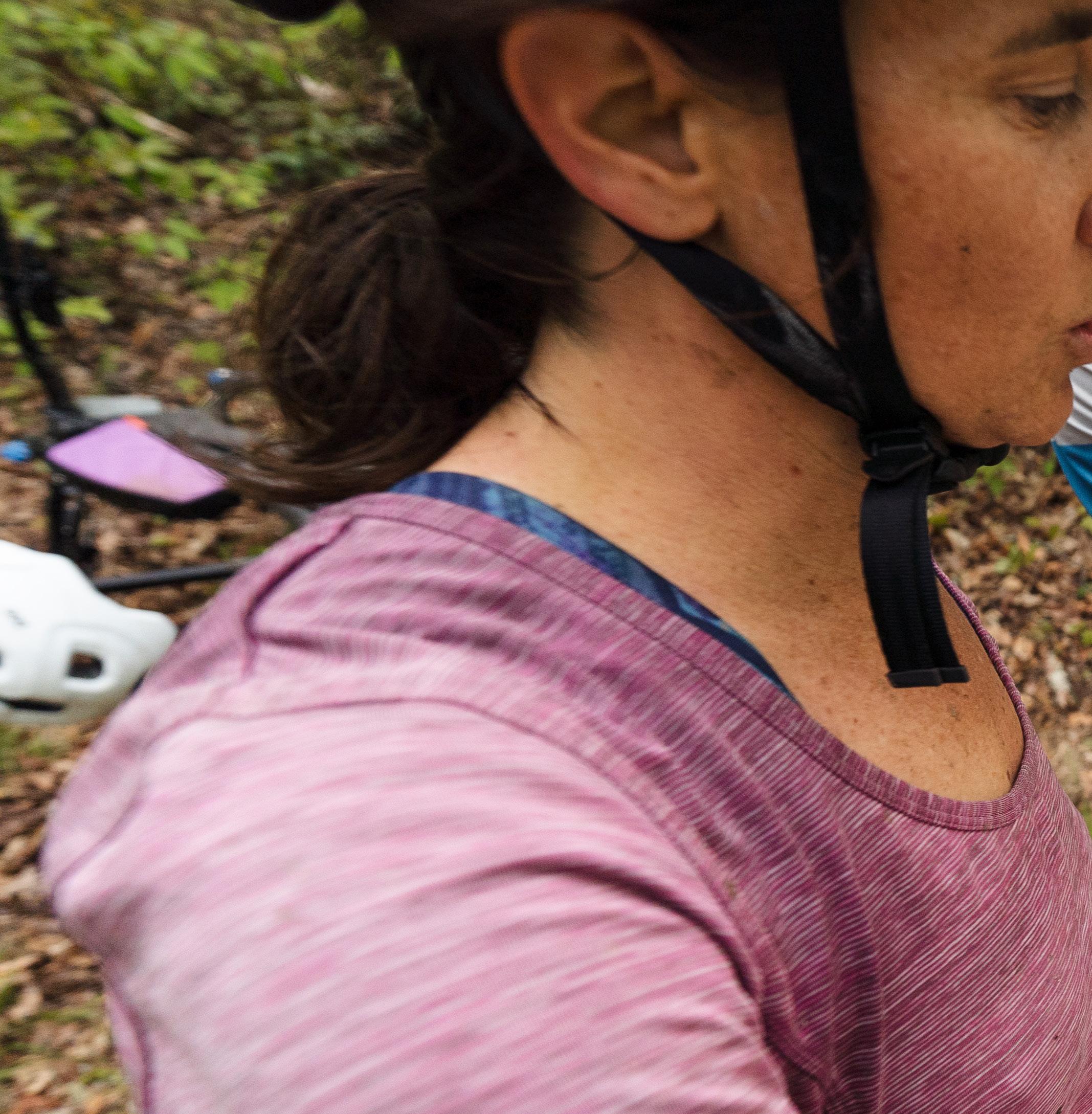

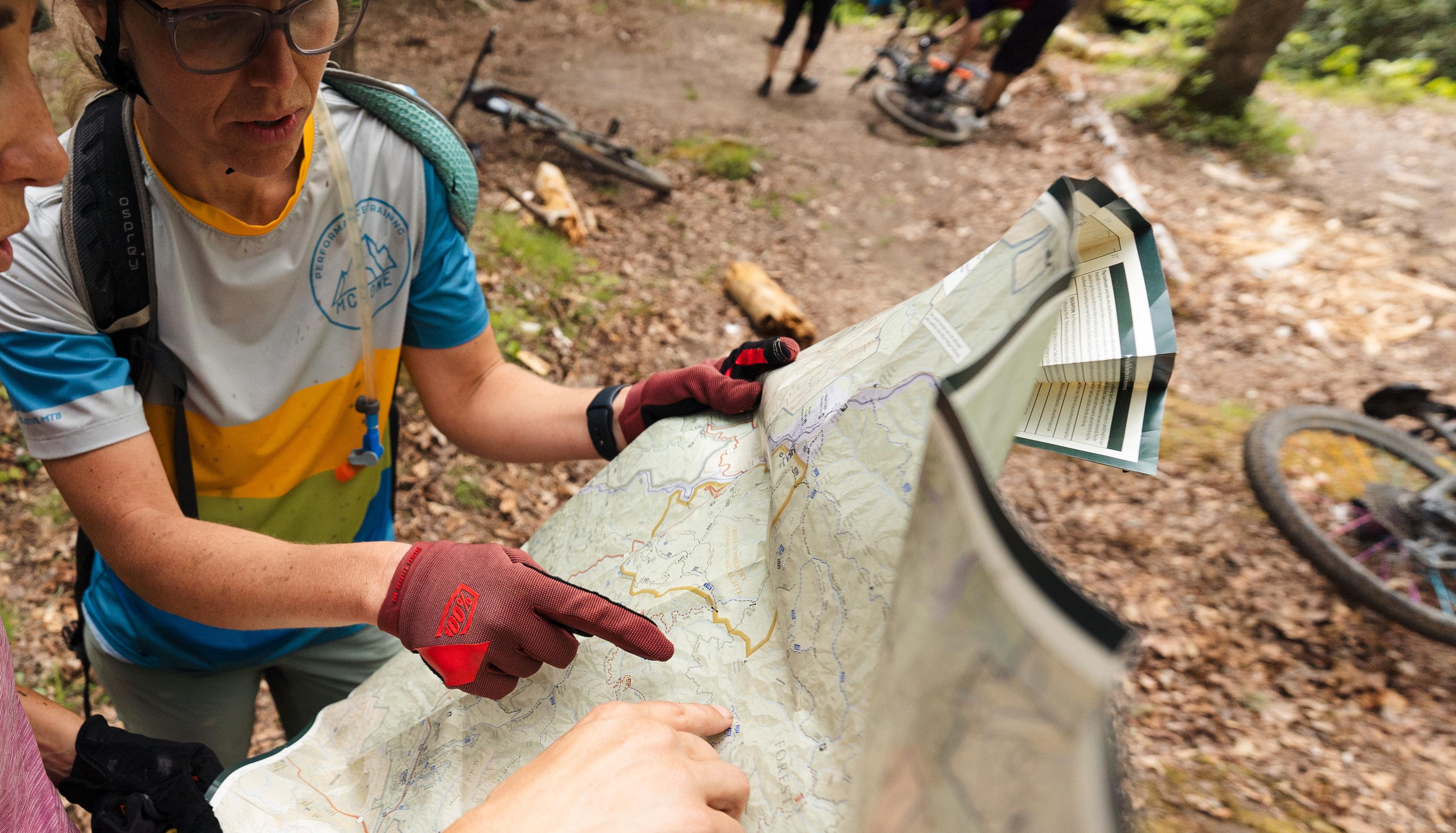


















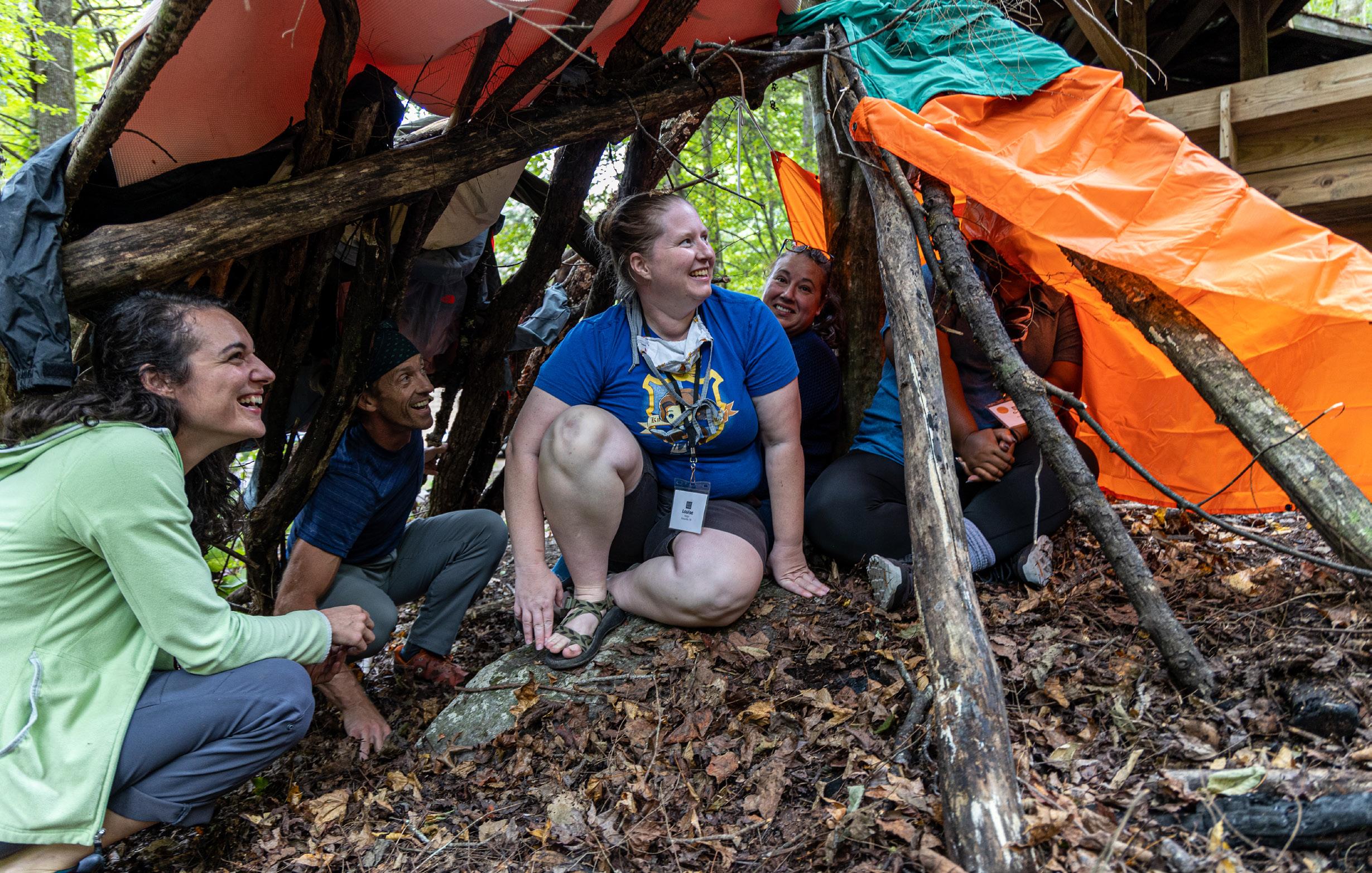

crown lands where the trails are hard to find,” Walker explains. “Luckily, my coworker talked them through this over the phone.”
But had Walker and his team not been in the area, the group could have easily died from exposure. That experience is why Walker stresses the importance of navigational skills in his current role as assistant manager of SOLO Southeast, a wilderness medicine school that offers classes at the Nantahala Outdoor Center in Bryson City, N.C.
“Navigation is really first and foremost,” says Walker. “If we can prevent becoming lost and needing to use our wilderness survival skills in the first place, that is ideal.”
Stevens agrees, adding that adventurers should learn how to read a paper map rather than rely on their cell phones.
“Cell phones are great,” she says, “until they die.”
In certain harsh conditions, the human body can only survive three hours without shelter. Walker learned this the hard way when he became hypothermic while canoeing during a summer rainstorm.
“Building a shelter is vital and should be among


the first things you do in a survival situation,” he says. “We must protect our body from heat losses through the ground and air.”
For this reason, Stevens always recommends carrying a rainfly in your pack. (A poncho works in a pinch.) Essentially, you can create a makeshift tent by stretching the fabric between two trekking poles or sticks and using rocks as anchors. If it’s cold outside, plant matter can be used as insulation.
“It’s pretty basic,” says Stevens, “but it works.”
If a snowstorm is rolling in or temperatures are dropping, you might be tempted to build a fire. But Walker cautions against this.
“Your body is a furnace, and we need to feed that furnace with calories, water, and exercise,” he says. “Fires can only offer an external heat source.”
About a decade ago, Katherine Parnell was working at a summer camp in western North Carolina when a student from Washington, D.C., looked around the verdant deciduous forest and said, “Miss KP, there’s a lot of nature out here.”
He was right. “There is a lot of nature out there,” says Parnell, who now teaches wilderness survival skills as the managing director of Earthshine Lodge in Lake Toxaway, N.C. “And it’s powerful.”
In her current role, Parnell’s primary objective is to help students appreciate the intensity of the natural world.
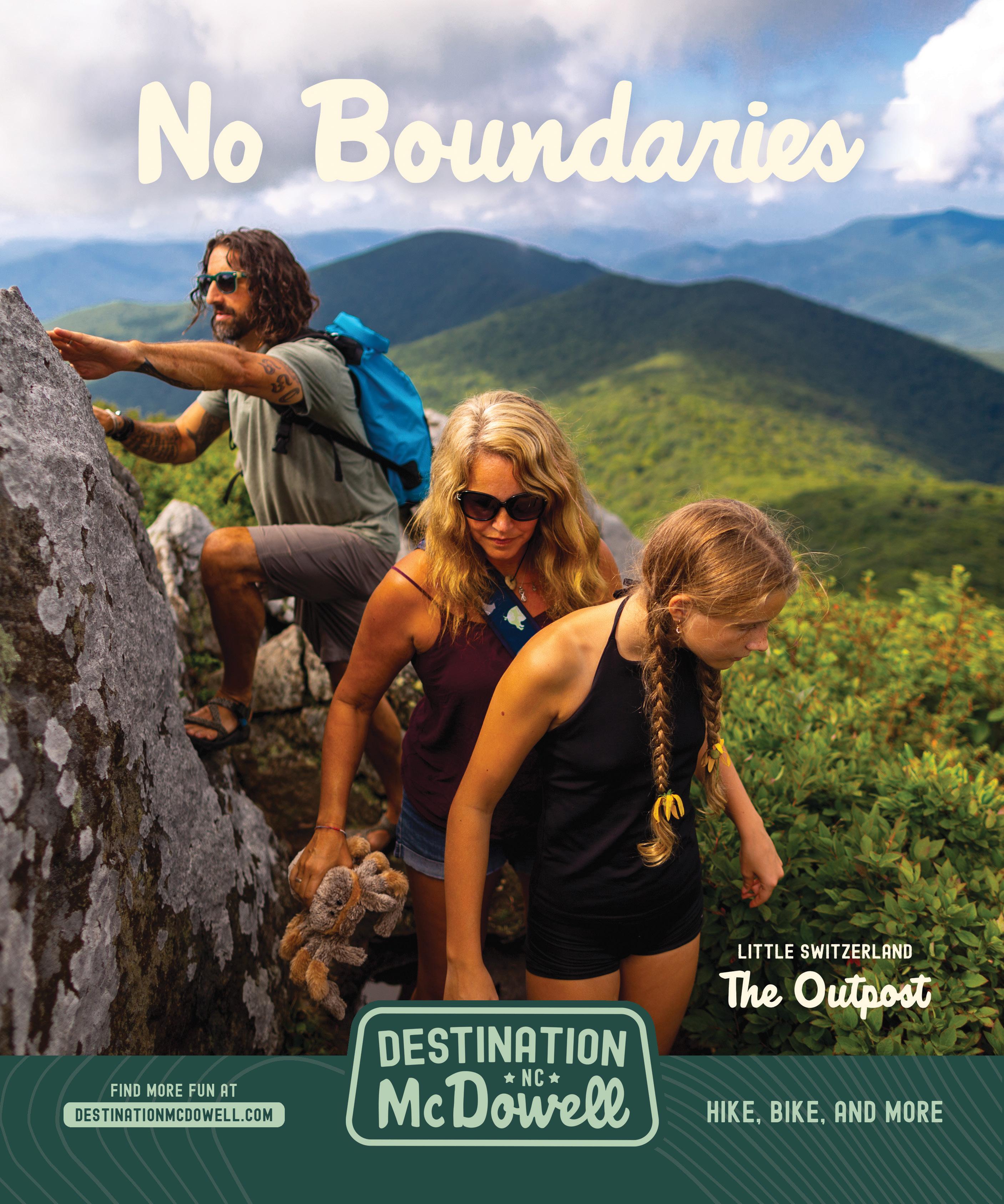

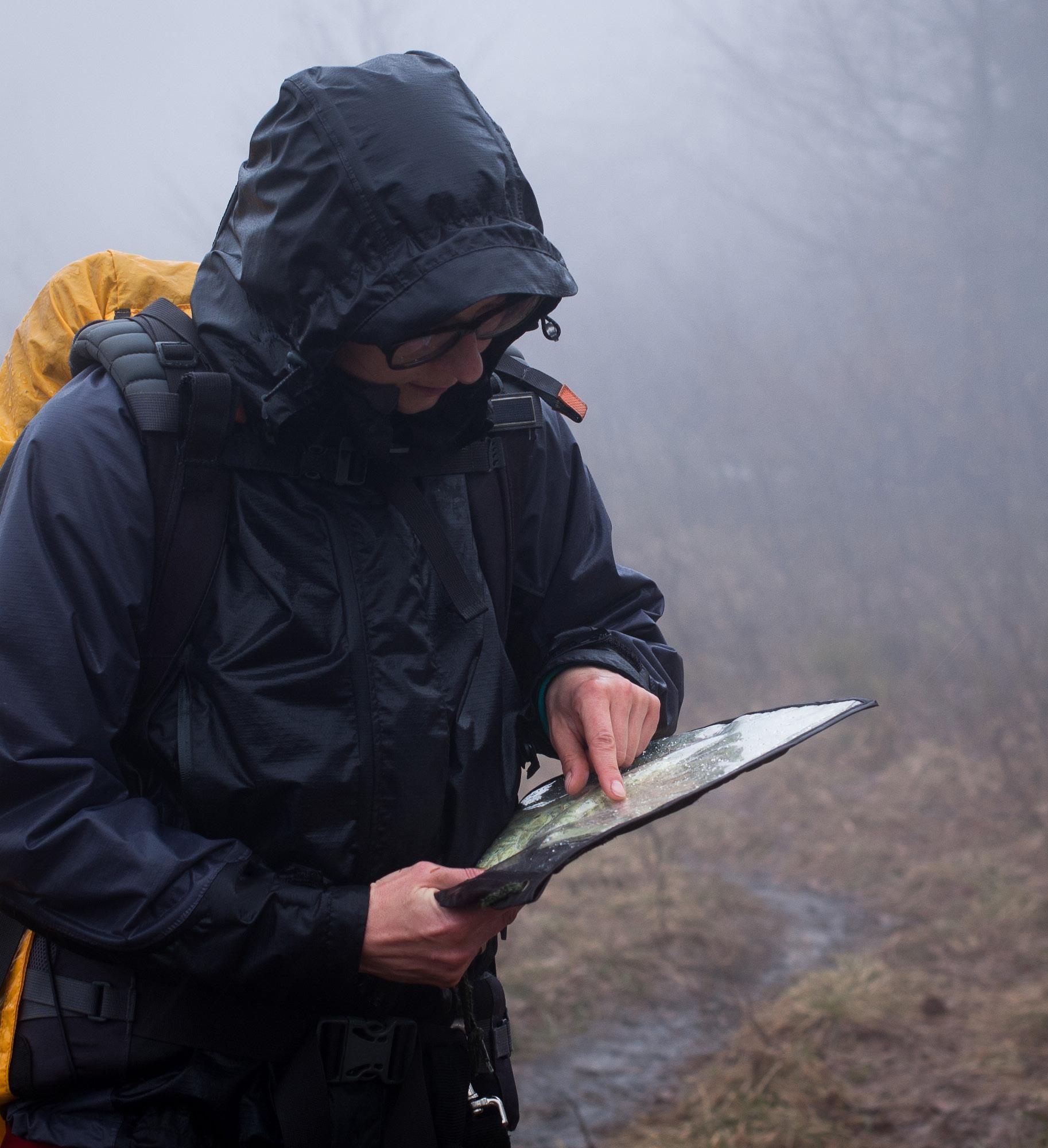
“Knowing and respecting nature is one of my first rules and one of the most important survival skills,” she explains. “The elements in nature can be brutal and change quickly, and knowing the weather patterns, seasons, and forecast can mean life or death.”
Jeremy Lloyd with the Great Smoky Mountains Institute at Tremont in Tennessee has his own variation of this rule.
“Know your place—your ecosystem, watershed, mountain, holler, or swamp,” he says. “Find out which plants are edible. Learn your trees.”
Mother N. can be one cruel lady. You could be having the best time in the backcountry, only for her to send a lightning storm and swarms of mosquitoes. The key is to roll with the punches, says Parnell.
“Staying positive even when times are challenging can make or break your success,” she notes.
Case in point: During a recent backpacking trip, driving rain made a river impassable, forcing Parnell’s group to backtrack and reroute. “To top it off, it was cold,” she says.
But rather than moan and groan, she and her fellow hikers spent the night drying out their gear while sipping hot cocoa and slurping ramen. Thanks to the weather, the group learned how to be adaptable.
Lloyd cherishes setbacks like these. He says “no amount of gear-buying, guidebook reading, or scrolling” will teach you quite like the wilderness.
“Most of us will never be Daniel Boone,” he laughs. “But we don’t need to be to enjoy creation, connect with others, and grow alongside them.”




































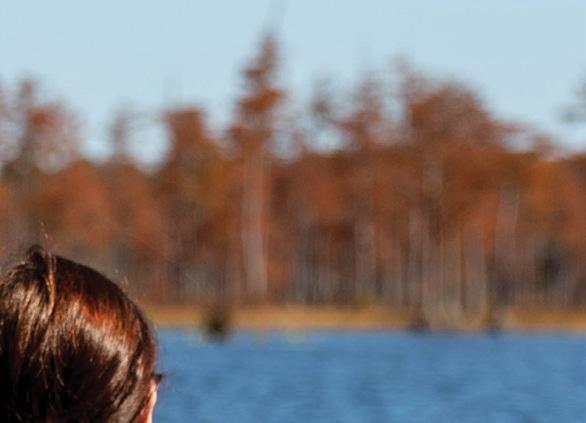













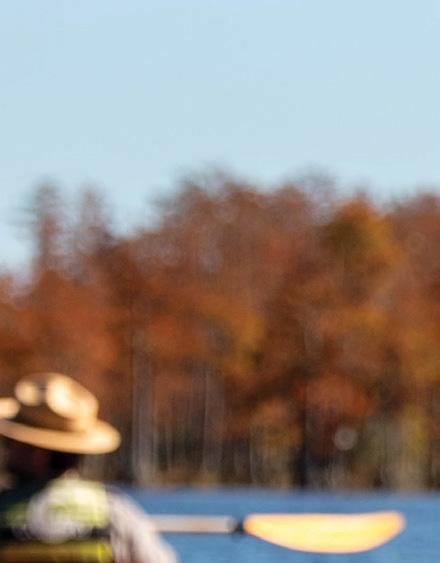







































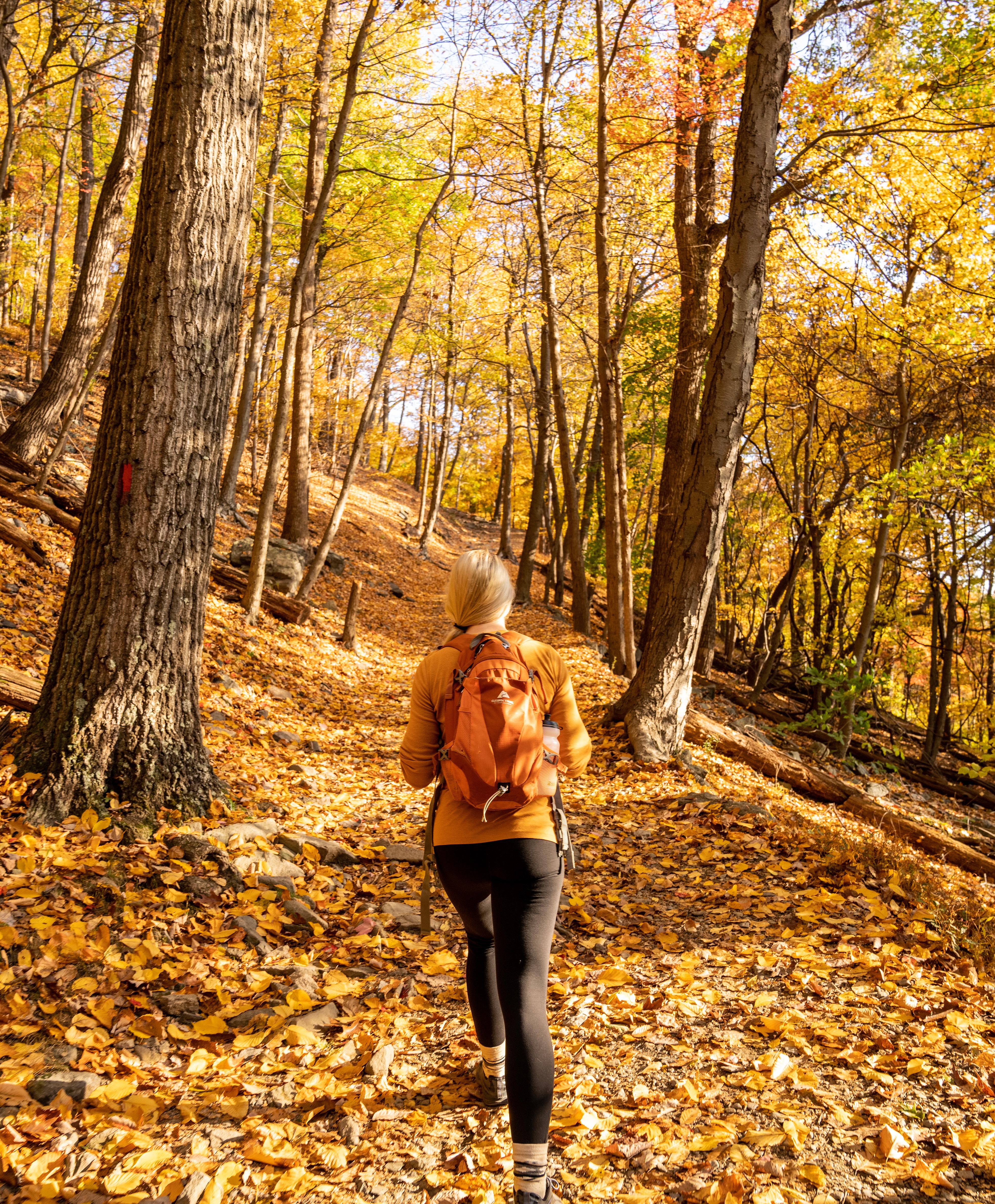
These weekend-friendly hiking trips let you enjoy the famous footpath with some mountain town creature comforts.
BY ERIC J. WALLACE
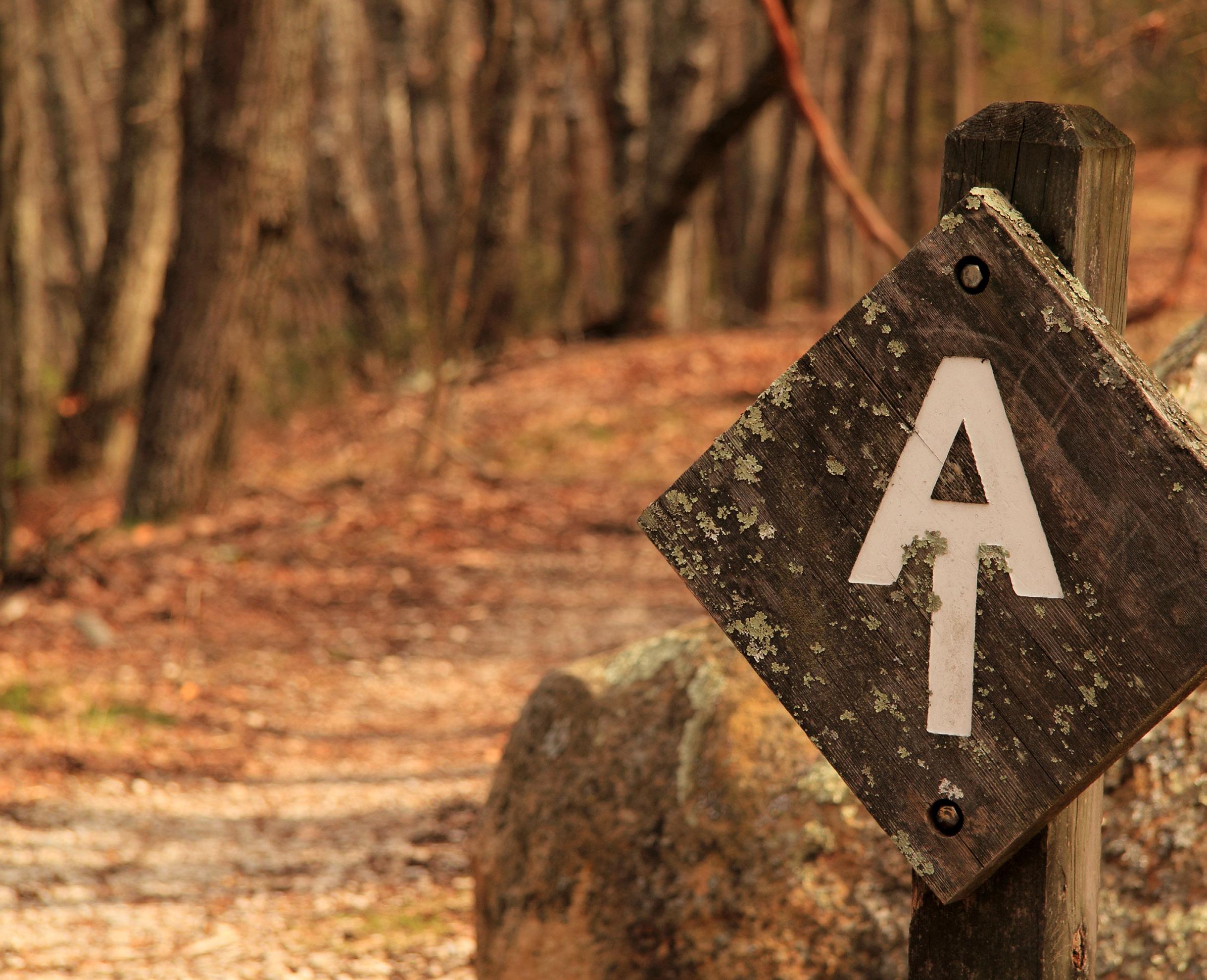
THE BLUE RIDGE REGION HOLDS THOUSANDS of miles of pristine hiking routes—and the iconic Appalachian Trail runs smack through the middle of it all. While there’s much ado about tackling it at once, section hikes are infinitely more pragmatic and user-friendly. And planning them around stays in cool towns offers a delectable brew of ruggedness and comfort. Here we bring you five curated, weekend-friendly treks along the A.T. that pair dazzlingly scenic highland adventures with destination-worthy overnight accommodations and eats.
The Hike: North from the Harpers Ferry National Historical Park parking area to the parking area at Fox Gap, about 17 miles.
The walk begins with a climb to a high ridgeline that passes through woodlands bordering the town, followed by a descent into the riverfront National Historic District. Cross the Potomac River via a repurposed 19th century railroad trestle that brings stunning views of steep surrounding cliffs and the Shenandoah River confluence. Follow the scenic C&O Canal Bike Trail along the riverbank for about three miles, then climb to the Weverton Cliffs for spectacular 180-degree views of the river, town, and surrounding mountains. Continue along the South Mountain ridgeline past the Ed Garvey Shelter, Crampton Gap Shelter and a pair of state parks to Fox Gap.
Stay: Find the Light Horse Inn in the heart of the Harpers Ferry National Historic District. The seven-suite boutique is housed in a sprawling, Georgian-style brick manor that dates to the
1770s. Inside you’ll find spacious, suite-style rooms with amenities like high-end beds, antique furniture, exposed brick walls, and modern bathrooms with marble or vintage tiles. A sister tavern with pub fare and craft brews awaits next door. lighthorseinn.com
Eat/Drink: Snallygaster’s Café & Wine Bar is a gem in a 1900s stick style building filled with historic, general store heirlooms. Sample a broad selection of wine, craft cocktails and regional brews at the barn-style bar. Snack on tasty yet affordable cheese and charcuterie boards, then follow with solid New American fare like barbeque-drizzled braised pork with wild mushroom risotto and local asparagus. snallygasterscafe.com
Shuttle: River & Trail Outfitters offers shuttles to and from trailheads throughout the region. rivertrail.com/shuttles
Hike: North from the Sugar Run Gap parking area to Pearisburg Cemetery, about 13 miles. Begin just below the 4,086-foot summit of Sugar Run Mountain and follow the high ridgeline past the stunning Wilburn Valley overlook and Doc’s Knob Shelter to Pearis Mountain. Soak up 180-degree, 3,555foot views of Peters Mountain, the New River and downtown Pearisburg from the boulder-topped Angel’s Rest vista, then descend into town.
Stay: Find the newly renovated Lilly Valley Inn about two miles from the A.T. perched atop a low mountainside overlooking the New River. Enjoy post-hike views from the seven-suite boutique’s wraparound deck and terraces. Digs are chic, spacious, and modern with amenities reminiscent of a lux countryside spa. lillyvalleyinn.com
Eat/Drink: Palisades Restaurant is a Southern-focused, farm-to-table eatery that occupies a neatly renovated 1920s furniture and hardware store in the nearby village of Eggleston. Regional craft beer and ciders abound, but the craft cocktail menu shines. Stone oven pizza is served alongside delights like a buttermilk brined, Southern-fried local porkchop with hot honey drizzle. thepalisadesrestaurant.com
Shuttle: Lilly Valley provides comped shuttles to and from the A.T. for visiting hikers.
The Hike: North from Tennessee’s Low Gap parking area to downtown Damascus, 15 miles. This scenery-rich trek carries you through the Cherokee National Forest past Double

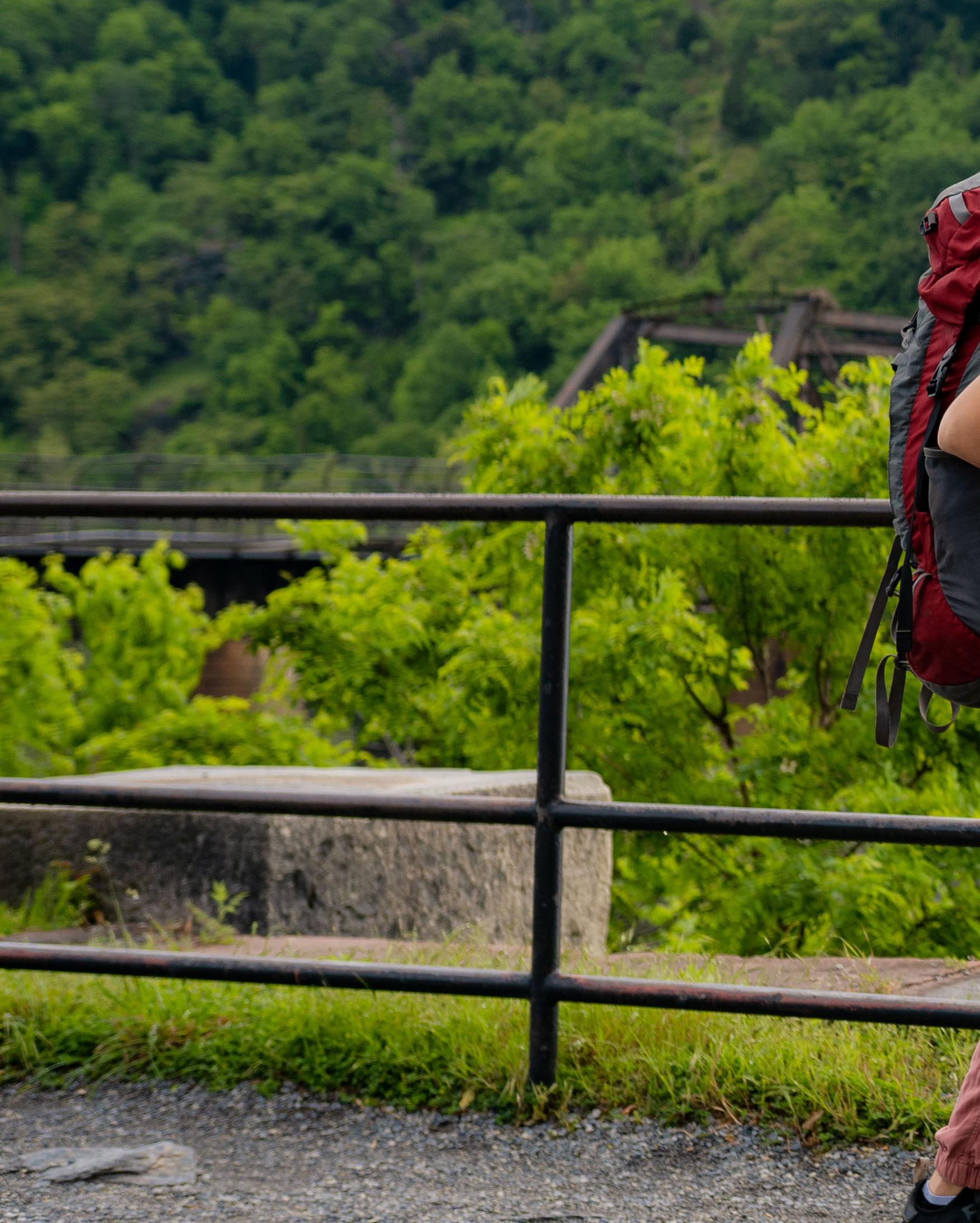
Spring Gap, McQueen’s Knob Shelter and the Abingdon Gap Shelter. The relatively easygoing hike pursues the long, mostly 3,500-plus-foot ridgeline of Holston Mountain and offers a plethora of east and westward views. The route descends steadily into town after the Virginia border.
Hearty hoofers can follow the next day with an approximately 15-mile trek from the Taylors Valley Parking Area to the 5,525-foot summit of White Top Mountain, Virginia’s second highest peak.
Stay: The Old Mill Inn occupies a beautifully renovated, early 19th century downtown mill complex that sits on Laurel Creek about a mile from the A.T. The boutique's dozen, hotelstyle rooms pair modern amenities like walk-in glass showers with carved wooden bedframes. Balconies and wraparound porches overlook a 200-foot-wide dam across the creek. damascusinn.com
Eat/Drink: Pick from eight delicious seasonal brews on tap that rotate between Damascus Brewery’s overall cast of 60 (!). Follow with dinner at Old Mill’s onsite restaurant for solid American fare like pan seared rainbow trout in a setting that feels more old-world tavern than rural Virginia. thedamascusbrewery.com
Shuttle: Mt. Rogers Outfitters provides shuttles to trailheads within 100 miles of town. mtrogersoutfitters.com
The Hike: North from the Lemon Gap parking lot into town, around 14 miles. Climb to the 4,300-foot summit of Walnut Mountain to bask in views of the surrounding Pisgah National Forest and Tennessee’s Cherokee National Forest. Pass

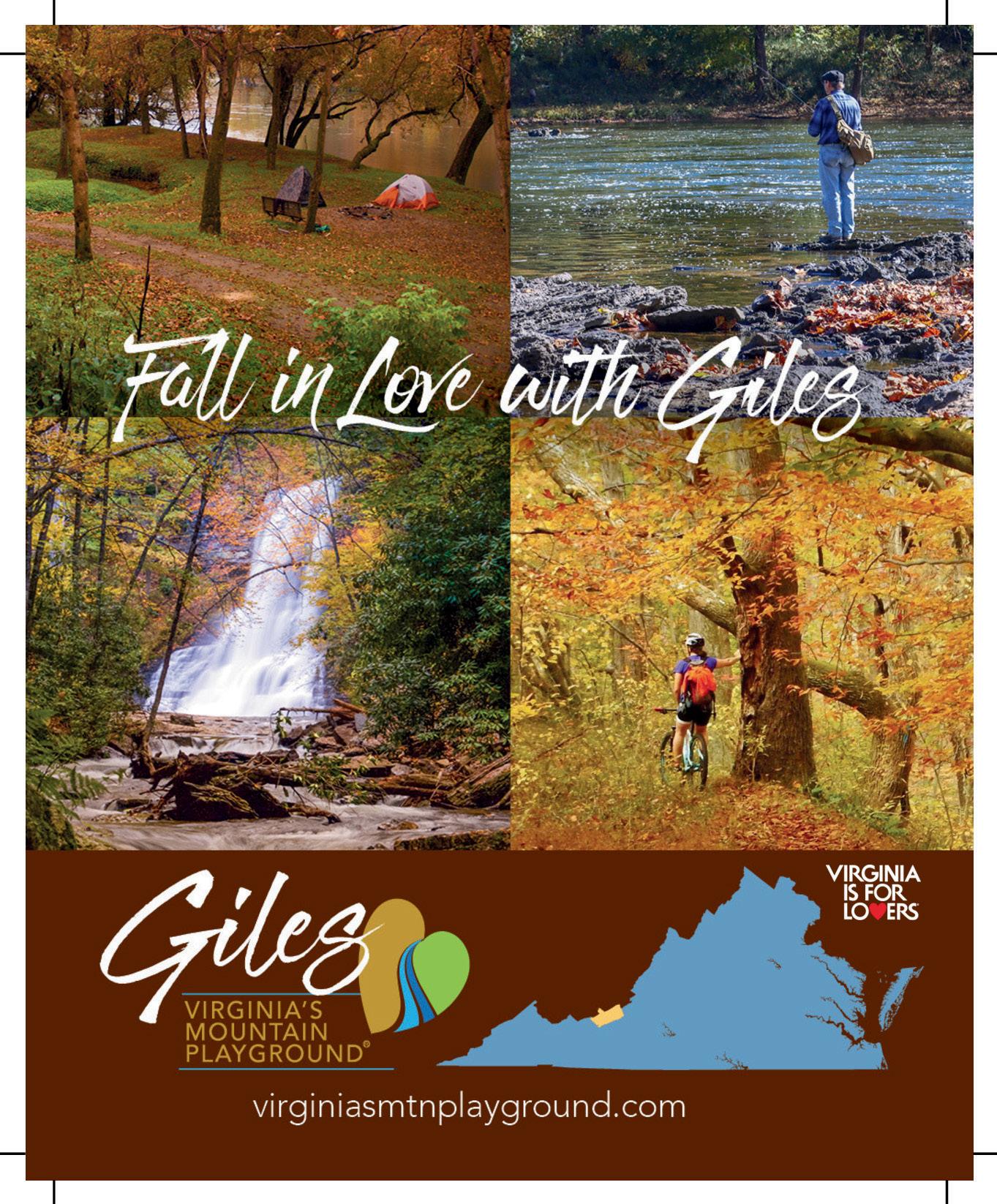

through a series of remote mountaintop meadows to the summit’s eponymous log shelter, then climb through Catpen Gap and descend through dense, high-elevation forests and rhododendron thickets to Garenflo Gap. Nab eye candy at Lamb Knob and Canebrake Ridge, then pass the Deer Park Mountain Shelter and 2,400-foot summit vista and begin the descent into town.
Looking for more action? Follow with a give-or-take nine-miler from Hot Springs to the Hurricane Gap parking area. Highlights include stunning views of the town and French Broad River from Lovers Leap Ridge.
Stay: Find the Iron Horse Station, an inn and restaurant in a pair of restored, turn-of-the-century brick warehouses on the edge of downtown just off







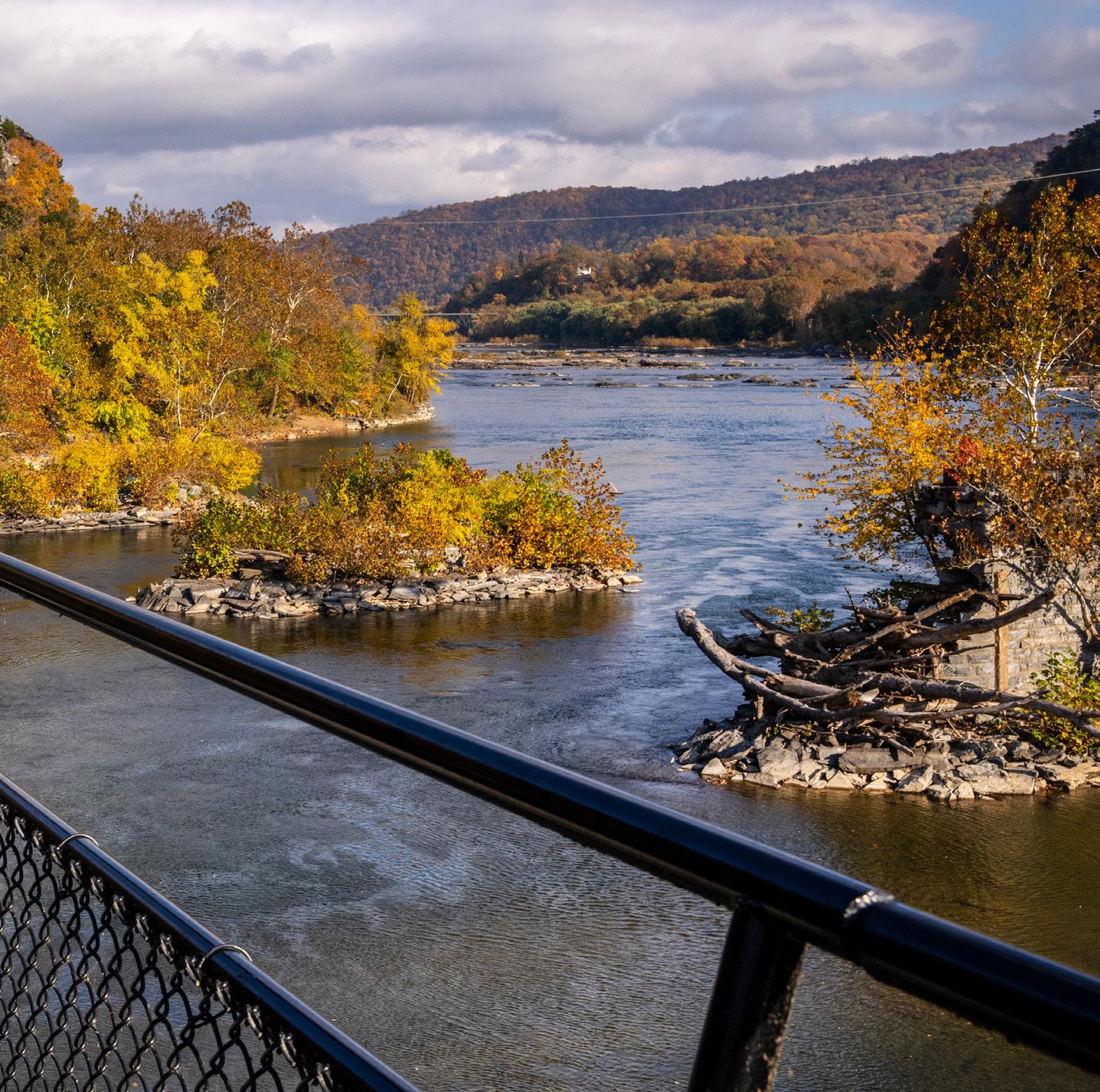
Hike: North from the Carvers Gap parking area to the U.S. 19 parking area, 15 miles. This bucket-list trek passes through rare Southern Appalachian spruce-fir forests in the Cherokee National Forest, traverses the famed Roan Highlands balds, and features some of the trail's most incredible high-elevation hiking. The seven-mile “Grassy Ridge” section is the longest of its kind on the A.T., rarely dips below 5,500 feet and brings stunning 360-degree views. Take a .6-mile or so detour through rhododendron groves to 6,165-foot meadows atop Grassy Ridge Bald for mind-boggling, eastward eye candy that, on a good day, includes Grandfather, Beech, and Sugar Mountains.
Stay: Mountain Harbour B&B sits just over a quarter mile from the A.T. crossing at U.S. 19 and is a legendary haven for thru-hikers. May breakfasts, for instance, are often attended by dozens. Accommodations at the onsite Hiker Hostel are rustic, but the main house’s three rooms are comparatively lux and offer private baths. There’s an onsite food truck that serves burgers, tacos, wings and salads on the gorgeous property. mountainharbour.info
Eat/Drink: Venture into the tiny town of Roan Mountain for craft brews, world-class wood-fired pizzas and dessert pastries from Smoky Mountain Bakers. smokymountainbakers.com
Shuttle: Mountain Harbour patrons enjoy free shuttles within reasonable distance of the inn.

By Mary Beth Skylis
Hikers attempting the entire 2,200-mile Appalachian Trail need quality stops for a respite from the backcountry. Fortunately, the Blue Ridge portion of the famous footpath, which runs from Georgia to Maine, has some easily accessible spots to grab new gear or a night of rest with small-town charm and blackberry milkshakes. Here are five thru-hiker favorites.
Dahlonega, Ga.
Dahlonega is a blip of the radar for people who are passing through the region. However, for Appalachian Trail thru-hikers, it’s well-known for its proximity to Springer Mountain, gateway to the trail’s southern terminus. This well-reputed hotel was started in 2004 as The Hiker Hostel by former thru-hikers, Josh and Leigh Saint. It’s since expanded its lodging options and become Barefoot Hills, but it’s still focused on accommodating Appalachian Trail hikers, offering shuttles to sections of the trail in Georgia.
Blairsville, Ga.
One of the first things that visitors to Mountain Crossings notice are dozens of pairs of boots and sneakers hanging from a tree. Located just under 31 miles from the southern terminus of the A.T., Mountain Crossings is one of the first big milestones for many longdistance hikers, and one of the first places where they can exchange their shoes for a better-fitting footwear option. Most thru-hikers reach the store after hiking Georgia’s tallest Appalachian Trail peak, Blood Mountain. When they make it, they’re greeted by a business with great hiker amenities: a hostel, a mail drop station, and store. And the business has been known to offer hikers “shakedowns” (assistance with lightening their packs by sending unnecessary gear home).
After a steep descent, Appalachian Trail hikers walk right into the Nantahala Outdoor Center (NOC) about 136 miles after beginning a northbound journey. This outdoor center is a popular regional river outfitter but, for hikers, the NOC is typically used as a campsite or bunkhouse for a rest day. The premises feature a number of restaurants, lodging options, and activities like zip lining, tubing, kayaking and mountain biking. Visitors often pass the day watching kayakers and other water adventurers while picnicking from the shore.
Woods Hole Hostel is a small mountain paradise with a promise of food and shelter. As legend would have it, it was the late 1930s when a couple went looking for a place to live in southwest Virginia and found Woods Hole. They fixed her up, eventually bought the place, and used it to house everyone from hunters to passersby. This practice continues, but it’s become predominantly a hiker haven these days. The property looks like an oldcountry farmstead with a rustic appeal. But it is best known for its community meals, which usually utilize locally grown vegetables, and Neville’s bread. In addition to filling hikers’ stomachs, this hostel provides all the basic trail amenities: mail drops, showers, laundry, snacks, and wifi.
Shenandoah National Park, Va.
Shenandoah National Park is home to 101 miles of the Appalachian Trail. The park’s waysides, small, grab n’ go convenience stores with menus full of American classics, are legendary among long-distance hikers. After spending months in the woods, miles away from civilization, these pit-stops provide convenient and easily accessible lunch options. The most popular food item among Appalachian Trail hikers is the blackberry milkshake that can be found at these locations. It’s so memorable that some hikers vow not to miss a wayside for fear of losing out on a milkshake.

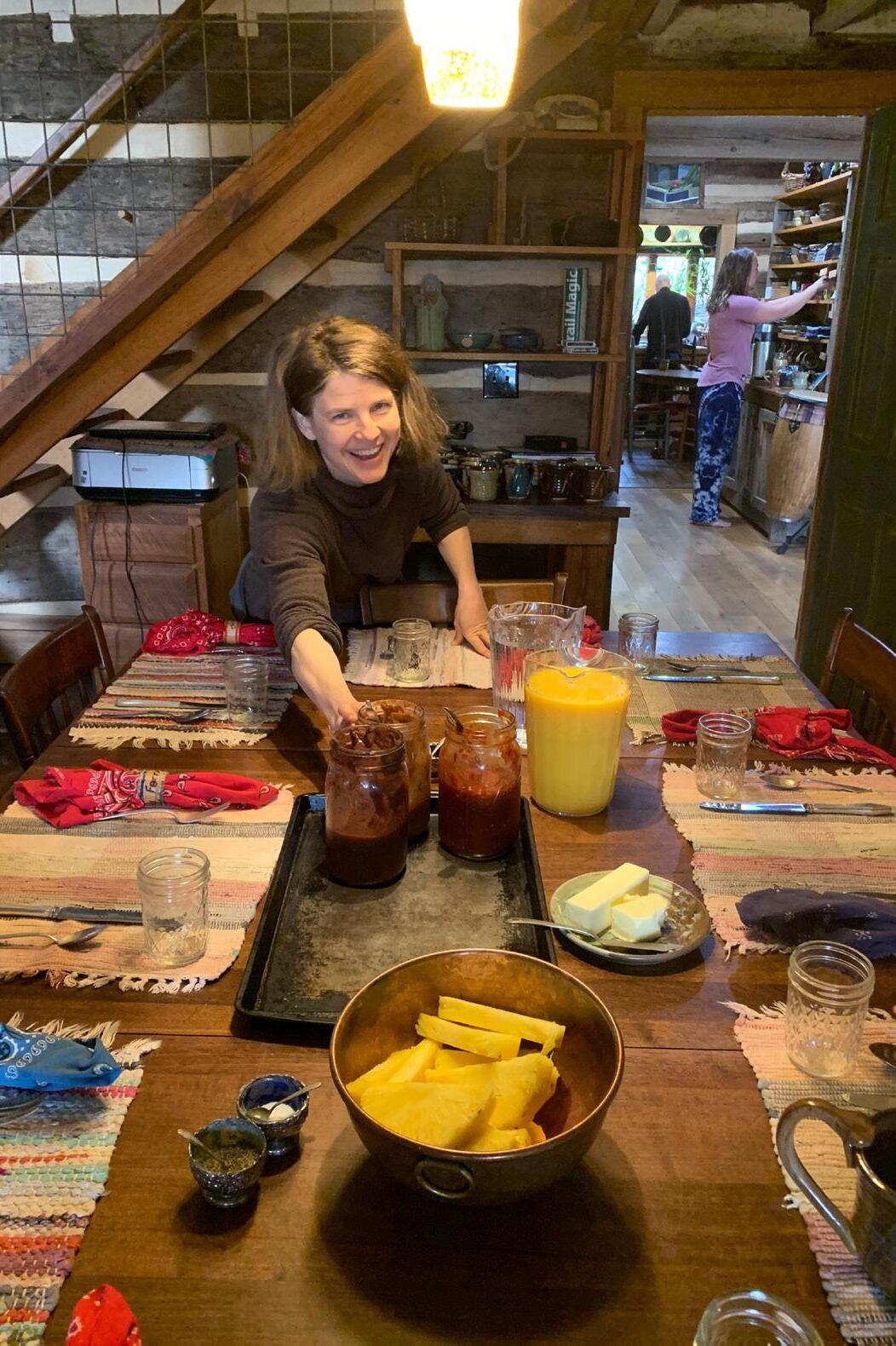

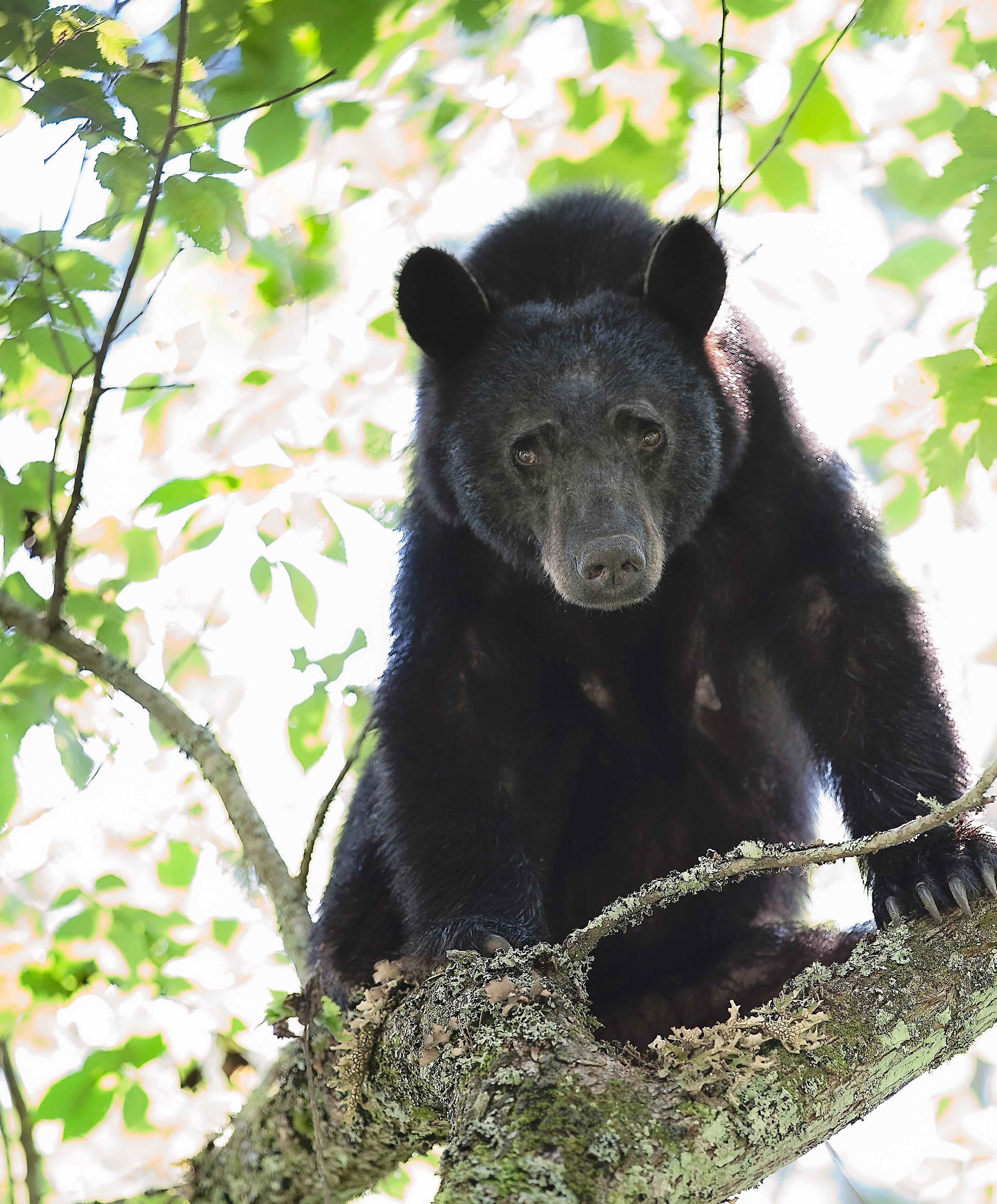
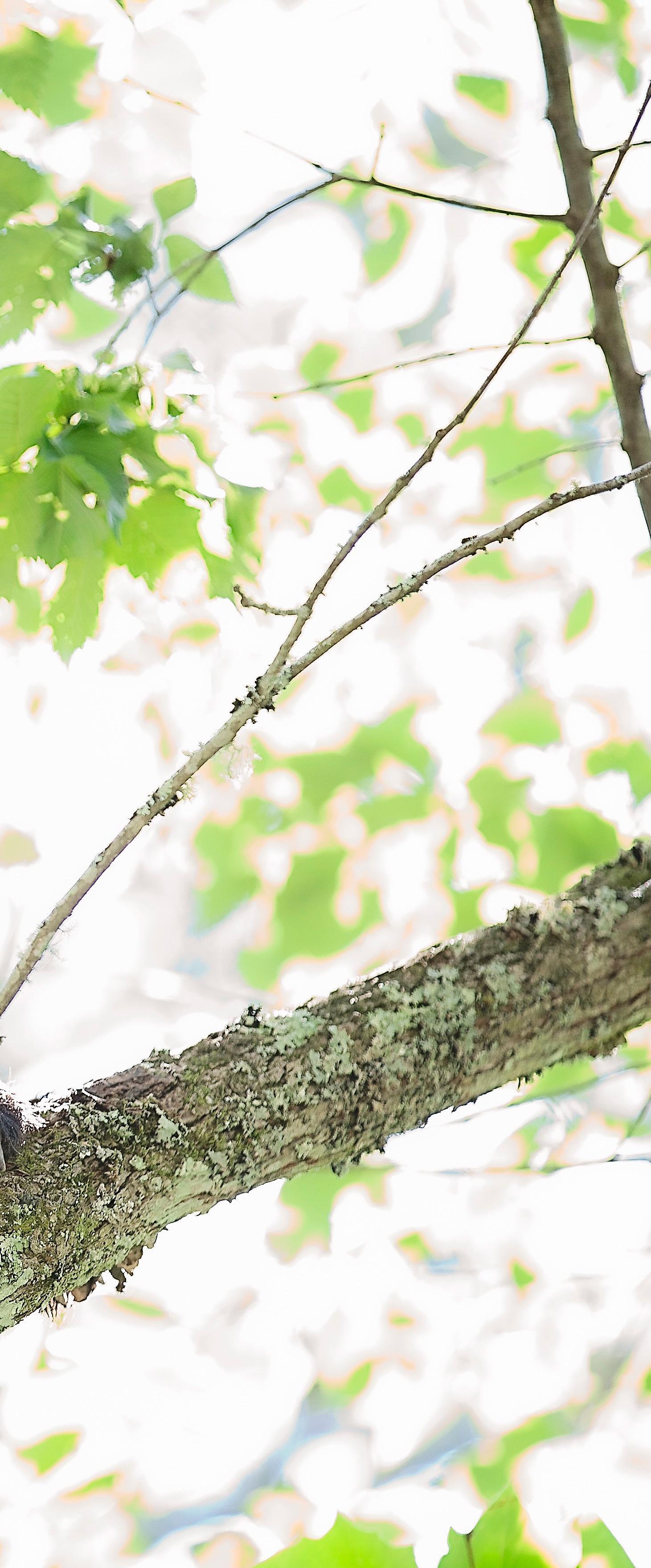
Extensive efforts to add highway wildlife crossings near the Smokies aim to protect animals and people
BY HOLLY KAYS
AS North Carolina State Representative Sarah Crawford and her husband Dan cruised east past Morganton, N.C. They were eager to reach their hotel for some rest between the wedding they’d just attended and the comedy show and baseball game planned for the next day.
Then the car stopped “like we had hit a brick wall,” said Sarah Crawford, a Wake County representative in the North Carolina General Assembly.
In fact, they’d hit a 200-pound bear. Every air bag deployed, the front fender crumpled, and the car was left motionless in the dark—on a road where most people drive 70 miles per hour or more. Though the couple managed to escape mostly unscathed, the car was totaled, and the bear was dead.
It was a “pretty scary incident” that sent Crawford “down a rabbit hole” searching for information about how to make roads safer for both human travelers and native wildlife. That journey led her directly to the Safe Passage coalition, a group of people and organizations that has been working since 2017 to make wildlife crossings safer not only in its focus area of the Pigeon River Gorge, but also in hotspots across North Carolina and Tennessee.
“We at Safe Passage often use the tagline, ‘what's good for wildlife is good for people,’” said Tim Gestwicki, the coalition’s steering committee chair and CEO of the North Carolina Wildlife Federation. “And clearly, if they run into a large animal, the danger is there for people too. So it’s a perfect nexus of people and wildlife safety.”
Over the years, Safe Passage has become an increasingly organized collaborative of dedicated partners involved in everything from transportation planning to educational outreach and lobbying efforts—work that is predicated on foundational research it conducted starting in 2018. Coalition partners Wildlands Network and National Parks Conservation Association hired researchers Liz Hillard and Steve Goodman to tackle the project, and the pair placed 120 cameras along the 28-mile Pigeon River Gorge corridor. This stretch of Interstate 40 straddles the North Carolina-Tennessee line, bisecting a rugged landscape that falls mostly within either the Pisgah National Forest, Cherokee National Forest, or Great Smoky Mountains National Park.
The researchers spent three years investigating how this road impacts wildlife. Their work involved tallying roadkill spotted along the highway, combing historical accident and police reports for
wildlife collisions, fitting 13 elk with GPS collars, and analyzing data captured on the cameras. These methods allowed the team to evaluate 304 wildlife–vehicle collisions, finding that more than half involved bears and nearly two-thirds occurred between October and December, mostly close to existing structures like culverts or bridges.
“Where we built this infrastructure is where we also move through the landscape, the path of least resistance. So, the wildlife are getting funneled there too,” said Hillard. “But these structures aren't adequate for them to use, and that's why we're seeing elevated rates of wildlife–vehicle collisions where these structures are.”
The cameras also revealed that large numbers of wildlife roam the forest along the highway but never attempt to cross it. Nearly every camera captured images of bear and deer, and most had bobcats.
“One take-home point was the pure abundance of wildlife,” Goodman said.
As the research progressed, the coalition also seized on a serendipitous opportunity to create immediate change. Through its collaboration with the North Carolina Department of Transportation, Safe Passage learned that the agency would soon replace five bridges in the gorge. Wildlife
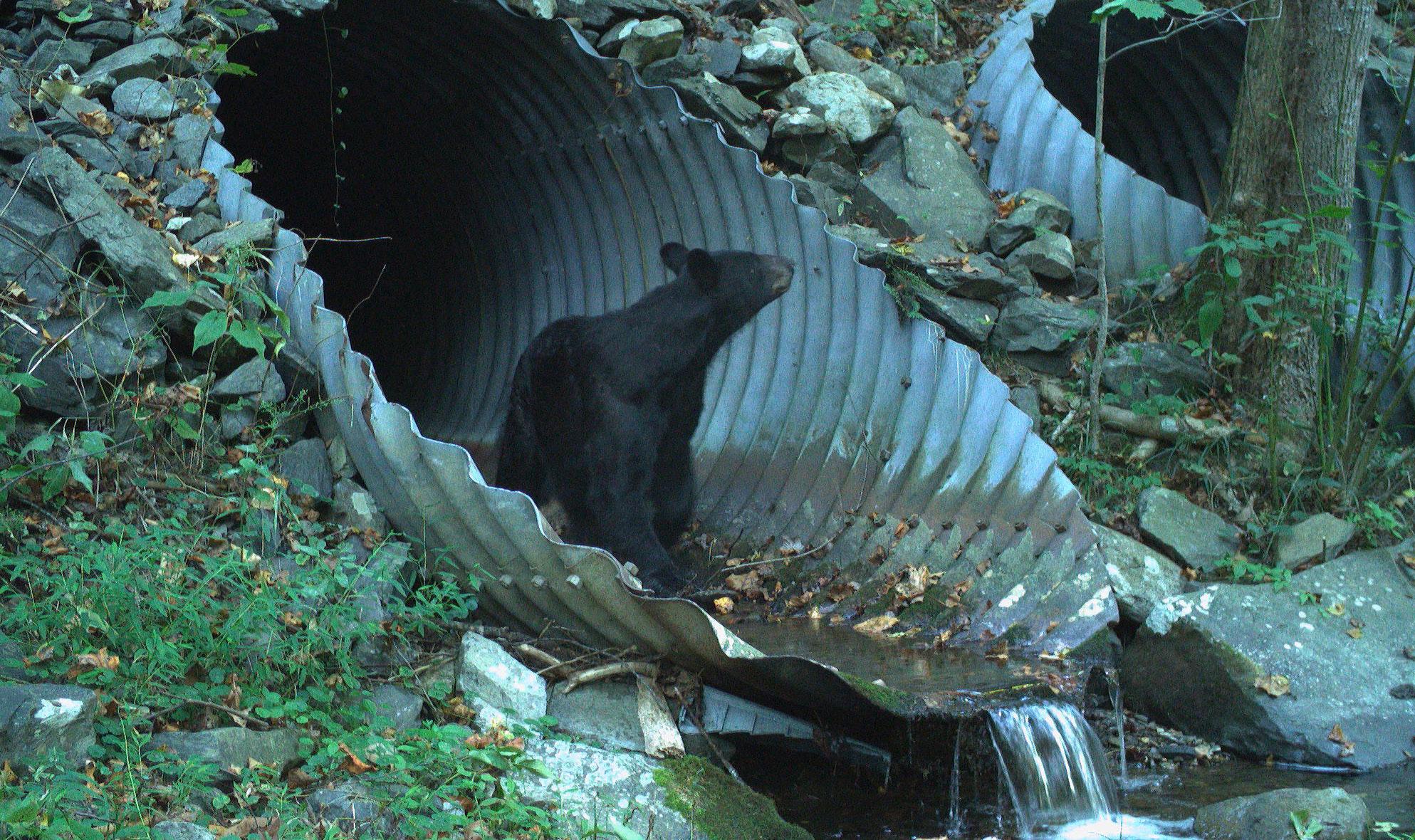
approached Division 14 Engineer Wanda Payne about adding them in, she considered it “the perfect opportunity.”
At Harmon Den Bridge at Exit 7, wildlifefriendly paths have replaced the riprap NCDOT was planning to install under the bridge along Cold Springs Creek. Cattle guards on the exit ramps discourage deer and elk from accessing the highway, and a nine-foot-tall fence excludes animals from the road and guides them under the

bridge. Since the project was completed in 2023, Goodman and Hillard have detected raccoons, opossums, skunks, groundhogs—and more recently, black bears and coyotes—traveling safely through the underpass. But it remains to be seen what the long-term impact might be as vegetation reclaims the site and adult animals pass down their knowledge of safe crossing places.
“It could take five years before a selfrespecting elk will go under something that’s had








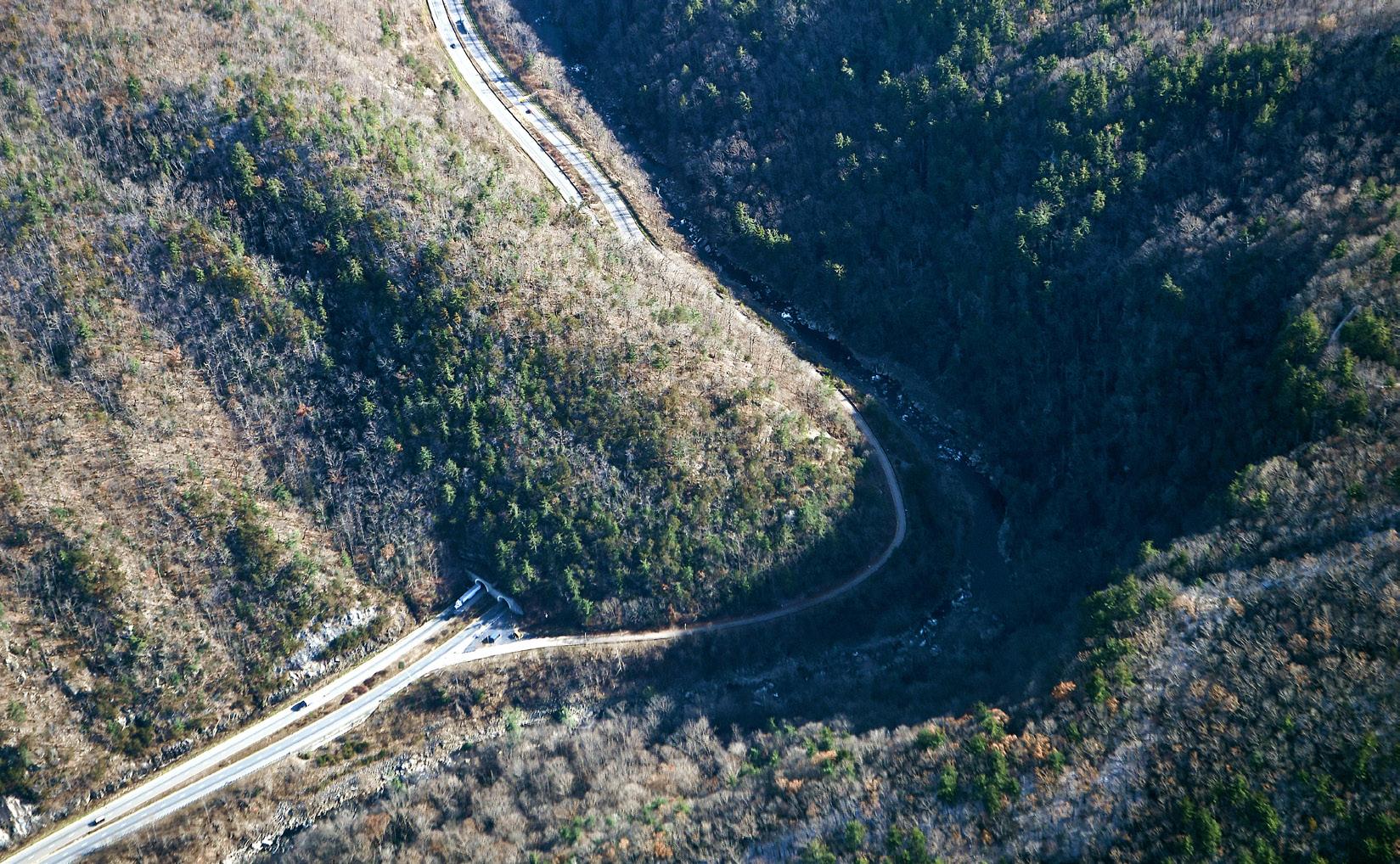
a human imprint for a long time,” said Goodman. Meanwhile, the DOT is using many of the techniques employed at Harmon Den on the remaining four bridges. Two bridges near Exit 24 at Jonathan Creek are nearing completion, and work has begun on Pigeon River Bridge and Fines Creek Bridge, both near Exit 15. Each bridge incorporates slightly different wildlife mitigations based on how animals interact with the road at that particular location. “There’s no
one size fits all,” said Payne.
Road ecology—the study of how human highways impact living things—is a fairly new field. The federal highway system predates it by “many decades,” said Ben Prater, Southeast program director for Defenders of Wildlife. But it’s a vital area of study. For every animal that attempts a potentially deadly highway crossing, Goodman and Hillard found, many more cease to try, creating a barrier effect that makes populations on either side
less resistant to changes in climate, habitat, disease, and other pressures. Roads are also a barrier to the natural flow of water and aquatic creatures within it. Plus, they’re loud. “The soundscape in natural habitats is dramatically impacted by road noise,” said Prater. Myriad animal communications and activities suffer as a result.
To address these issues, Safe Passage hopes to see road ecology become a standard part of transportation planning and a recurring category in governmental budgets. The group marked its first major funding success in 2023 when the North Carolina General Assembly allocated $2 million for wildlife crossing improvements. The money was directed to Haywood County to address issues in the Pigeon River Gorge, where it will most likely be used to install wildlife fencing from the Tennessee line to Exit 20 and assess the feasibility of other mitigation recommendations from Goodman’s and Hillard’s research.
Now, Safe Passage is asking North Carolina legislators for $10 million, a sum that could unlock up to $90 million more in federal grant funds, protecting wildlife at critical crossings across the state. Proposed project areas include: I-26 in Madison County, N.C.; 143 in Graham County, N.C.; 24/27 in Montgomery County; and US 64 in Washington County.
“Every crossing,” Gestwicki said, “contributes to the larger conservation puzzle.”
Learn more at SmokiesSafePassage.org.
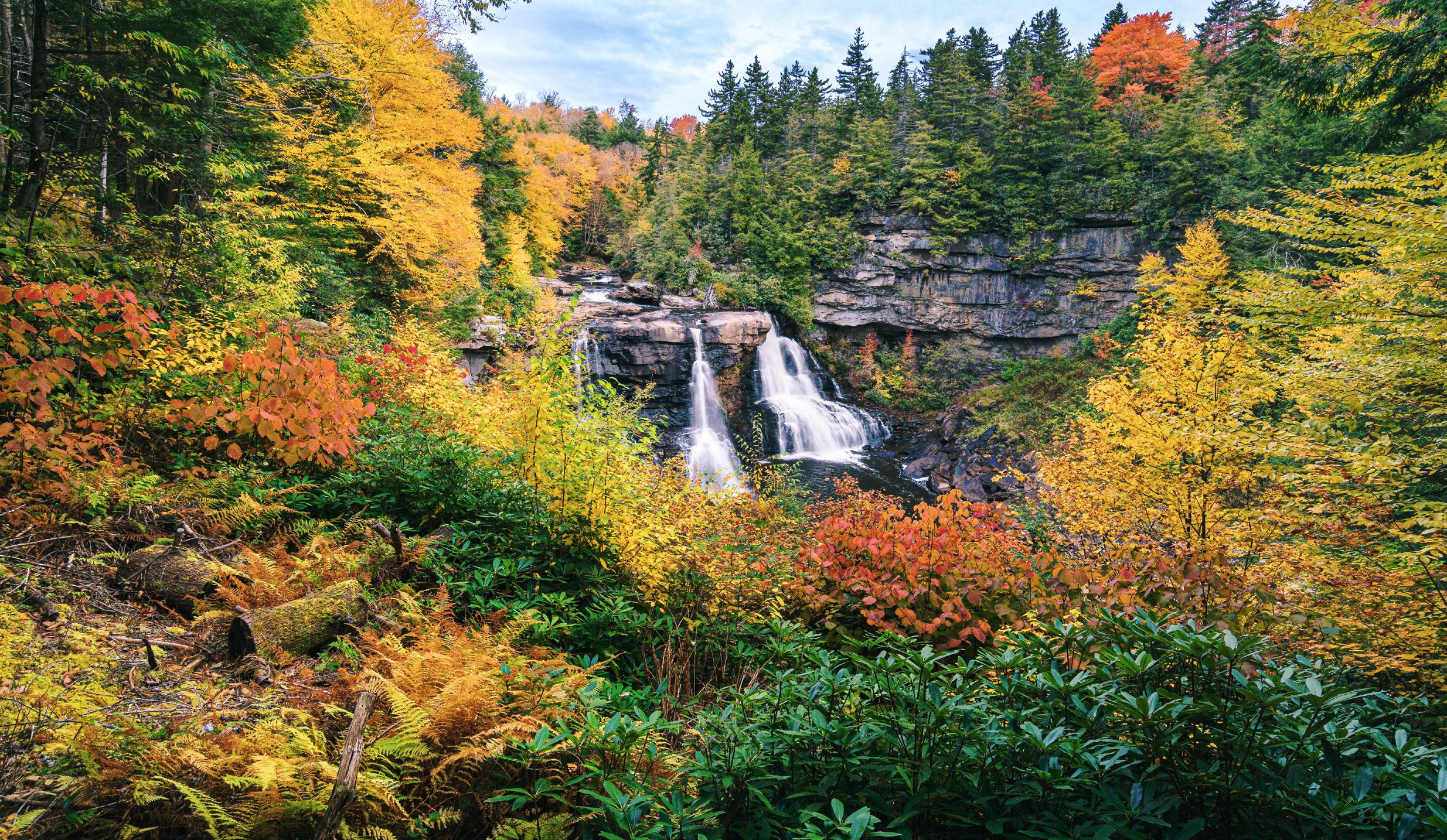



As fall features begin to paint the landscape, there is no better time to hike our region. From family friendly leaf-peeping paths to serious backcountry trails, this guide has everything you need for adventure. So lace up your boots, grab your pack, and get ready to discover the best hikes the Southeast has to offer this season!


Discover the natural beauty of Allegany County, the Mountain Side of Maryland, where outdoor enthusiasts can explore 70,000 acres of majestic nature. With 200 miles of trails winding through diverse landscapes, Allegany County offers a range of hiking experiences with an expansive culinary scene and centuries of American history to uncover along the way.
Start your trekking at Rocky Gap State Park, which provides a diverse hiking experience with over 15 miles of trails. The Canyon Overlook Trail, a gentle 0.3-mile hike, rewards you with breathtaking views of the one-mile-long gorge. For a more immersive journey, the Lakeside Loop Trail stretches 5.3 miles around the picturesque 243-acre Lake Habeeb. This moderate trail features scenic footbridges, meanders along the lake’s shoreline, and traverses through varied woodlands, offering a rich experience of the park’s natural beauty.
Green Ridge State Forest, with its extensive 50-mile network of trails, caters to all levels of hikers, from beginners to seasoned adventurers. It’s an excellent spot for multi-day backpacking trips, providing a range of terrains to explore. During your visit, make sure to stop at Point Lookout, where you can take in sweeping panoramic views of the Potomac River’s horseshoe bend and enjoy vistas of mountain ranges across four states: Maryland, Pennsylvania, Virginia, and West Virginia.
Allegany County is a haven for outdoor adventurers with its renowned bike trails—the Great Allegheny Passage and the C&O Canal Towpath—stretching 334 miles from Pittsburgh to DC and meeting in Cumberland, MD. Adventure seekers can rock climb at Rocky Gap State Park, while those preferring a relaxed pace can paddle or float on the Potomac River.
The county’s Main Street and Arts Districts in Frostburg and Cumberland offer diverse dining, including the Donut and Go Coffee and Donut Trail and the Mountain Maryland Tap and Pour Tour. For a unique experience, ride the Western Maryland Scenic Railroad’s scenic 3-hour round trip or explore Tracks and Yaks, Maryland’s only rail bike operator.
MdMountainside.com
Spotsylvania is celebrating its 300th anniversary in 2021 with a series of programs The Great Eastern Trail is a 1,600-mile hiking route from Alabama to New York’s Finger Lakes. In Maryland, it spans 18 miles, linking the C&O Canal Towpath from Hancock to the Green Ridge State Forest.

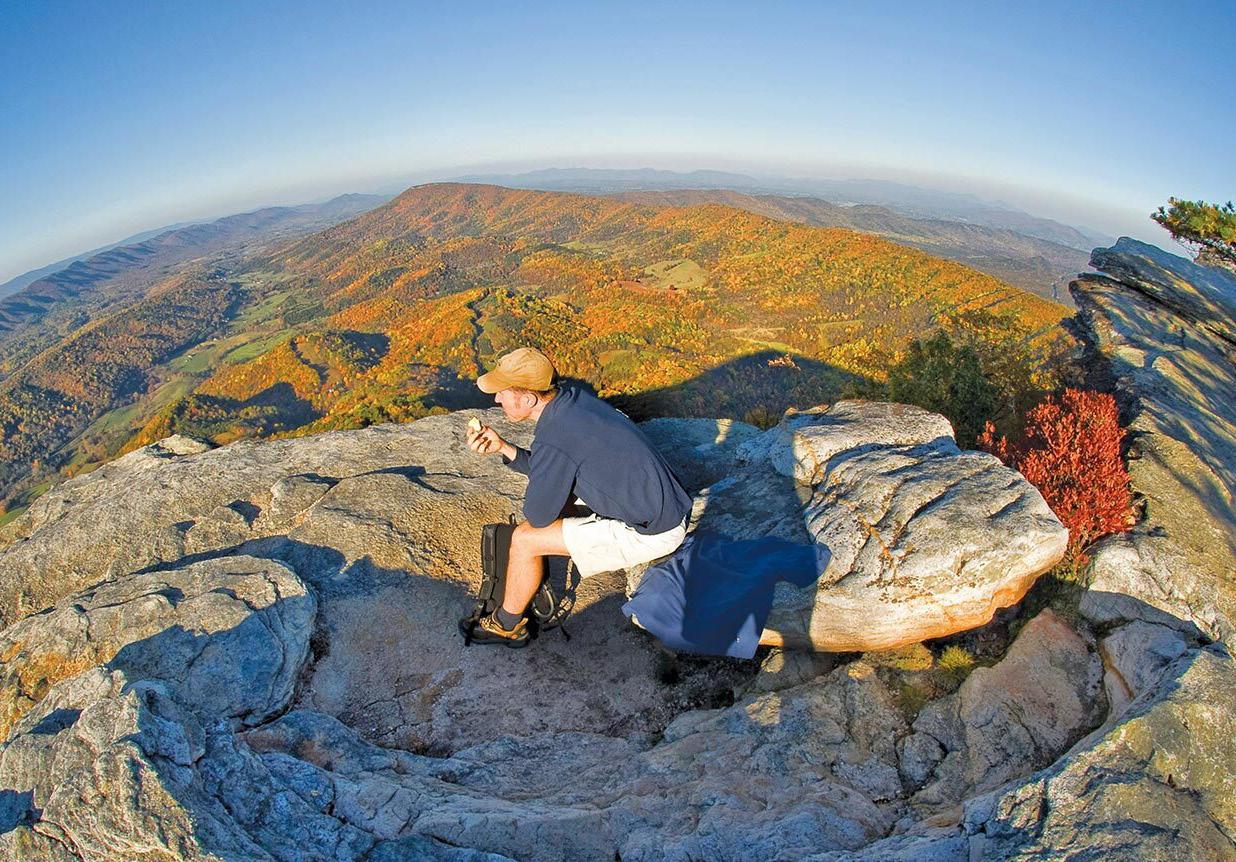

As the temperatures drop and the leaves turn vibrant shades of red and gold, there’s no better place to hike than Virginia’s Blue Ridge. Whether you’re looking for a peaceful family walk or gearing up for a challenging multi-day backpacking adventure, this region offers something for every level of explorer.
Nestled in the heart of Virginia’s Blue Ridge Mountains, the Roanoke Region boasts over 1,000 miles of scenic trails, including more than 700 miles dedicated to hiking. The renowned Virginia Triple Crown, a trio of iconic hikes, offers some of the most stunning views in the Blue Ridge. Dragon’s Tooth, a unique rock formation towering nearly 35 feet, rewards hikers with panoramic views after a steep ascent. McAfee Knob, perhaps the most photographed spot on the Appalachian Trail, offers sweeping 270-degree vistas of the Catawba Valley. Lastly, Tinker Cliffs features dramatic overlooks where you can marvel at the expansive landscapes of Roanoke and beyond.
The region also features excellent trails along the Blue Ridge Parkway and Jefferson National Forest, with beautiful natural areas like Mill Mountain Park and Read Mountain Preserve. A hidden gem on the Appalachian Trail is Hay Rock, where hikers are rewarded with stunning views of Carvins Cove, especially vibrant during the fall.
As the largest city along the Appalachian Trail, Roanoke is the ideal outdoor basecamp. For gear and adventure planning, Roanoke Mountain Adventures, Outdoor Trails, Walkabout Outfitters, and Mast General Store offer great selections. Families can enjoy the outdoors at Roanoke County’s Explore Park, with cabins, camping, aerial adventures at Treetop Quest, and trails for hiking and biking. Roanoke is also a premier destination for cycling and mountain biking, set to host the 2025 USA Mountain Biking National Championships, attracting top athletes from the 2024 Paris Olympics.
After a day on the trails, unwind at the West Station District, where craft beer flows at local favorites like Golden Cactus Brewing, Blindhouse Beer Company, and Big Lick Brewing Company, paired with delicious eats at Tuco’s Taqueria and Beamer’s 25. As always, Visit VBR encourages everyone to recreate responsibly and follow Leave No Trace principles to preserve the beauty of the region’s trails and public lands.
Another top spot in Virginia’s Blue Ridge, the City of Salem is a vibrant hub for outdoor enthusiasts, offering endless adventure just minutes from its charming, historic Main Street. With hundreds of miles of scenic trails close by, Salem is the perfect gateway to explore the natural beauty and excitement of the region.
TOWN TO TRAIL TREKS
Salem offers a wide range of hiking experiences for all skill levels. Beginners and those seeking a leisurely outing can enjoy a peaceful walk along the Roanoke River Greenway, which meanders through scenic landscapes and connects to nearby parks. For a unique blend of nature
and history, visitors can embark on a self-guided historic walking tour through Salem’s charming Victorian neighborhoods, where tree-lined streets and beautifully preserved homes reflect the city’s rich architectural heritage. More challenging trails in the surrounding Blue Ridge are also just a short drive away for seasoned hikers looking for adventure. On weekends between March and November, the McAfee Knob Shuttle is available to take hikers from downtown Salem to the trailhead that leads to one of the AT’s most photographed spots.
After a day on the trails, you’ll be ready for some refreshment. Raise a glass at Olde Salem Brewing and Parkway Brewing Company. These locally-owned breweries serve great IPAs,

pilsners, lagers, and some of their own creative concoctions all in a fun, friendly atmosphere.
The dining choices are as plentiful as the hiking opportunities. Stroll down Main Street in Salem’s lovely downtown and you’ll find dozens of great dining choices. Sample old-style Italian at Mamma Maria’s; Dine in style at Frankie Rowland’s Steakhouse; Savor great sandwiches and salads at Macado’s; And experience the wings and famous calzones at Mac and Bob’s, an institution in Salem for more than 40 years.
Salem is easily accessible from I-81 and Route 460. If you’re looking for a destination that offers endless outdoor fun, plan an adventure at VisitSalemVA.com

Nestled in the heart of the Appalachian Piedmont, Frederick County, Maryland, offers a hiker’s paradise with its vast National and State Parks and historic trails. Whether you’re seeking rugged mountain trails or serene riverside paths, Frederick County has an adventure waiting for every outdoor enthusiast.


Perched on the eastern ridge of the Appalachian Mountains, Catoctin Mountain Park blends natural beauty with interesting history. Hike through well-maintained trails revealing remnants of charcoal hearths from the area’s industrial past, learn about Prohibition-era whiskey distilling on the Blue Blazes Trail, or explore the park’s western edge, once a training ground for the OSS during WWII, the forerunner to the CIA.
For more incredible trails, head to Cunningham Falls State Park, which offers two areas of diverse trails, a scenic lake, camping, and Maryland’s tallest cascading waterfall. The park’s history is intertwined with the nearby Catoctin Furnace, where old-growth forests were cut for charcoal to fuel iron production from 1776 to 1903. The Iron Trail connects the park to the historic village of Catoctin Furnace, offering a short but history-rich hike.
Gathland State Park, atop South Mountain, is a hidden gem where Union forces defeated the Confederates in the 1862 Battle of South Mountain. Explore trails
that lead through the remains of the estate of Civil War-era journalist and writer George Alfred Townsend. A popular hike from here is the 6.9-mile trek on the Appalachian Trail to Weverton Cliffs, offering stunning views of the Potomac River and a perfect ending with a visit to Smoketown Brewing Station in Brunswick.
Frederick County offers diverse outdoor adventures, from the Monocacy Scenic River Water Trail and mountain biking in the Frederick City Watershed to fly fishing in Catoctin Mountain Park. Gear up at the Trail House or enjoy guided tours and rentals with River & Trail Outfitters, including their Boat and Brew experience. The county also boasts Maryland’s largest collection of wineries, breweries, and distilleries. For family fun, visit Tree Trekkers for an aerial adventure and zipline park, and enjoy a frozen treat at South Mountain Creamery

Spotsylvania is celebrating its 300th anniversary in 2021 with a series of programs Cunningham Falls State Park’s fully accessible Boardwalk Trail is 0.25 miles long, ending at the base of the 78-foot waterfall. Parking is reserved for vehicles with a handicap symbol.
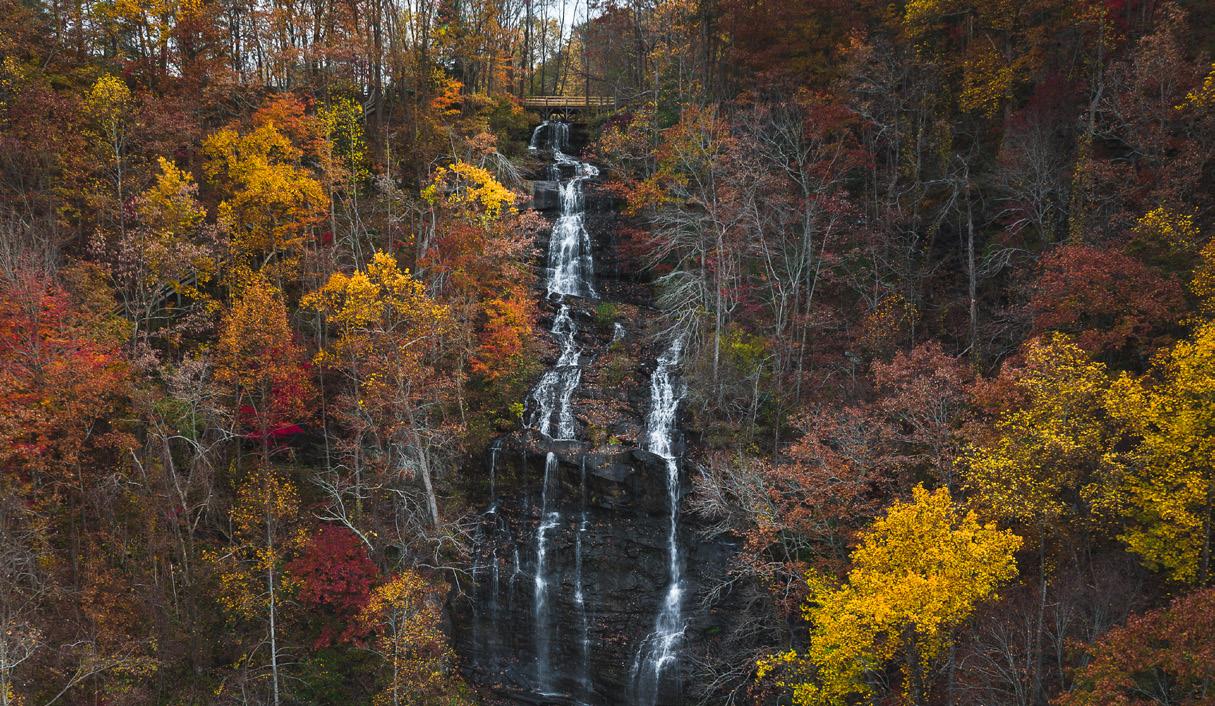

As the highest cascading waterfall in Georgia, Amicalola Falls is the crowning jewel of Amicalola Falls State Park in Dawsonville, Georgia. With its towering cascades and pristine wilderness, this park is a haven for hiking enthusiasts and nature lovers seeking an unforgettable adventure in the heart of the North Georgia Mountains.
Situated just 8 miles from the start of the Appalachian Trail, and within the dense Chattahoochee National Forest, Amicalola Falls State Park and Lodge holds a great amount of significance in the outdoor community. More than half of the northbound thru-hikers begin their journey at the park, due to its scenic beauty and accommodations. Rest assured, those not interested in hiking 2,200 miles can also enjoy the plentiful trails and scenic views that the park has to offer.
The park’s signature trail, the Amicalola Falls Trail, takes hikers to the 729-foot falls, whose name is derived from a Cherokee word meaning “tumbling waters”. The trail is relatively short, but does have some steep staircases, making it a moderately challenging hike. Or, escape to the lush forests on the Mountain Laurel Loop trail, perfect for families. For a more challenging trek, consider the Appalachian Approach Trail, an 8.5-mile hike that leads to the southernmost terminus of the famous longdistance trail.
Be one of the first to experience the new state-of-the-art visitors center at
the park, and learn about the history of the Appalachian Trail! Inside the center, guests can interact with a trail map which showcases the trek from Georgia to Maine, hang out with reptiles in enhanced exhibits, and find the perfect memento in a spacious gift shop. Before heading out, refuel and enjoy a tasty treat at the Falls Cafe
Amicalola Falls State Park & Lodge is your ultimate Appalachian adventure command post. Offering a range of accommodations, from a mountaintop resort-style lodge to cozy cabins and camping options, there is no better way to rest after a day on the trails. For the ultimate retreat, sleep under the stars with Timberline Glamping. These six luxurious glampsites blend modern amenities with rustic charm, offering wood fire pits, hammocks, and picnic tables alongside fresh linens, charging stations, and climate control. So, kick back, relax, and create lasting memories with family and friends around the campfire.
West Ridge Falls Access Trail is
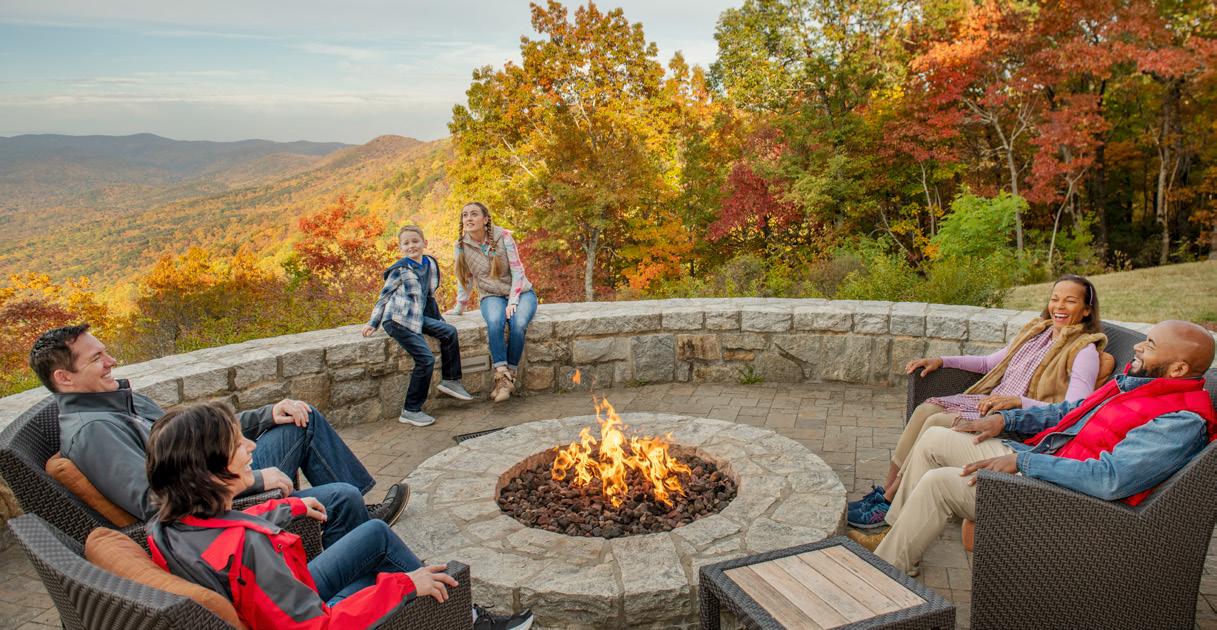
is celebrating its 300th anniversary in 2021 with a series of programs
Located in the Allegheny Highlands of southeastern West Virginia, Pocahontas County is a hiker’s dream. Its rolling hills, dense forests, and the headwaters of eight scenic rivers provide endless opportunities for exploration along its many trails.
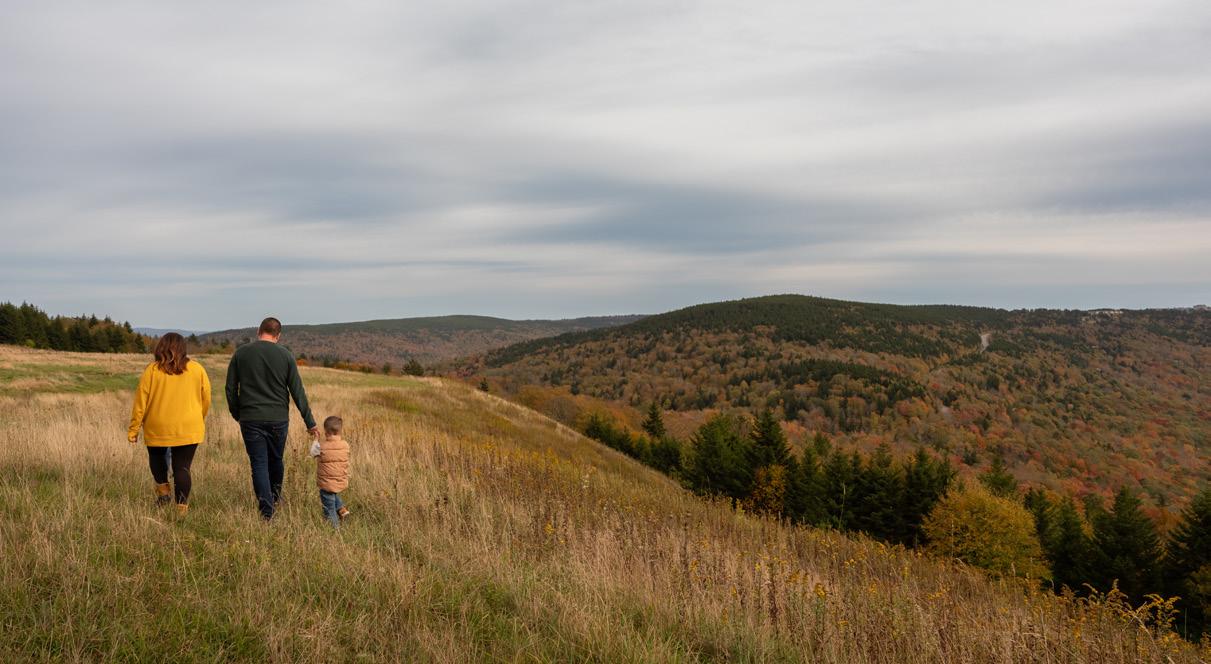



Pocahontas County’s parks are truly stunning. From the rugged beauty of Monongahela National Forest to the historic charm of Cass Scenic Railroad and Droop Mountain Battlefield State Parks, there’s a trail for every adventurer. Explore the serene paths of Watoga State Park or take in the dramatic rock formations at Beartown The Greenbrier River Trail offers a more leisurely escape, while Seneca State Forest promises a deeper connection with nature. Each park offers its own unique trails, providing unforgettable experiences for hikers.
Celebrate the 50th anniversary of the Allegheny Trail with a hike to the new artist mural in Durbin. As West Virginia’s longest hiking trail, spanning 311 miles, you can tailor your trek to the adventure you’re seeking, whether it’s a short journey or an extended exploration. Or, check out Cranberry Wilderness for 47,815 acres of remote trails, including a stunning 18.5mile loop. This route showcases diverse ecosystems, from Appalachian hardwood
forests to red spruce woodlands, and follows a scenic stream with cascading waterfalls along the way.
Gear up for your adventure with hiking boots and fall/winter apparel from The Men’s Shop in Marlinton, or find activewear, outerwear, and accessories at 4848’ Mountain Performance Shop in Snowshoe. After a day outdoors, enjoy home-cooked meals at The Bear’s Den in Arbovale and locally sourced ingredients at Hillsboro Public House. For live music, check out the 25th anniversary season of the Pocahontas Opera House or head to Old Mountain Tavern, both in Marlinton. For fall family fun, head to Green Bank Observatory or C.W.’s Corn Maze. Additional autumn activities and hiking routes can be found at PocahontasCountyWV.com/Things-todo/Autumn-in-the-Alleghenies
PocahontasCountyWV.com
HIKE HIGHLIGHTS
Spotsylvania is celebrating its 300th anniversary in 2021 with a series of programs
The Honeycomb Rocks Trail, located on the Highland Scenic Highway, showcases stunning quartz boxwork formations created by rock bending and weathering. The easy 0.25-mile loop trail is perfect for families to explore!

Thurmont, Maryland, offers the perfect blend of outdoor adventure and small-town charm. Just minutes from the trails, you can explore the town’s vibrant Main Street, filled with local shops, restaurants, and cafes. It’s the ideal destination for hikers looking to enjoy scenic routes while staying close to the heart of town for a post-hike bite or stroll.
Just three miles from historic Main Street, Cunningham Falls State Park features Maryland’s highest cascading waterfall and a picturesque lake perfect for paddling and canoeing. Nearby, Catoctin Mountain Park offers 13 scenic trails, including Chimney Rock, Hog Rock, and Wolf Rock, while Cunningham Falls boasts 10 additional trails.
Main Street Thurmont features the Thurmont Trolley Trail, a scenic rail-to-trail ideal for walking and cycling. The town is also a haven for wildlife enthusiasts, offering excellent birding, fishing, and camping opportunities. With its rich natural habitat, Thurmont is a favorite spot for outdoor activities, and nature lovers will appreciate the area’s blend of scenic trails and diverse wildlife.
For those looking to unwind, Thurmont offers three wineries, including Springfield
Manor Winery, Distillery, & Brewery—the only venue of its kind in Maryland. Uncle Dirty’s Brew Works is a local favorite, along with numerous locally-owned restaurants like Thurmont Kountry Kitchen, 10Tavern, and Mountain Gate Restaurant. For Italian or Mexican cuisine, check out Fratelli’s, Rocky’s NY Pizza & Italian Restaurant, and Los Amigos Thurmont is home to three of Maryland’s five historic covered bridges, the Catoctin Wildlife Preserve with 800 exotic animals, and the storied Catoctin Furnace, rich in history. As one of the 34 designated Main Streets in Maryland and an accredited National Main Street, Thurmont offers a perfect mix of outdoor beauty, rich history, and local flavor.
ThurmontMainstreet.com
Spotsylvania is celebrating its 300th anniversary in 2021 with a series of programs Hike Chimney Rock in Catoctin Mountain Park on a clear day, and you’ll be rewarded with breathtaking, endless views! HIKE HIGHLIGHTS
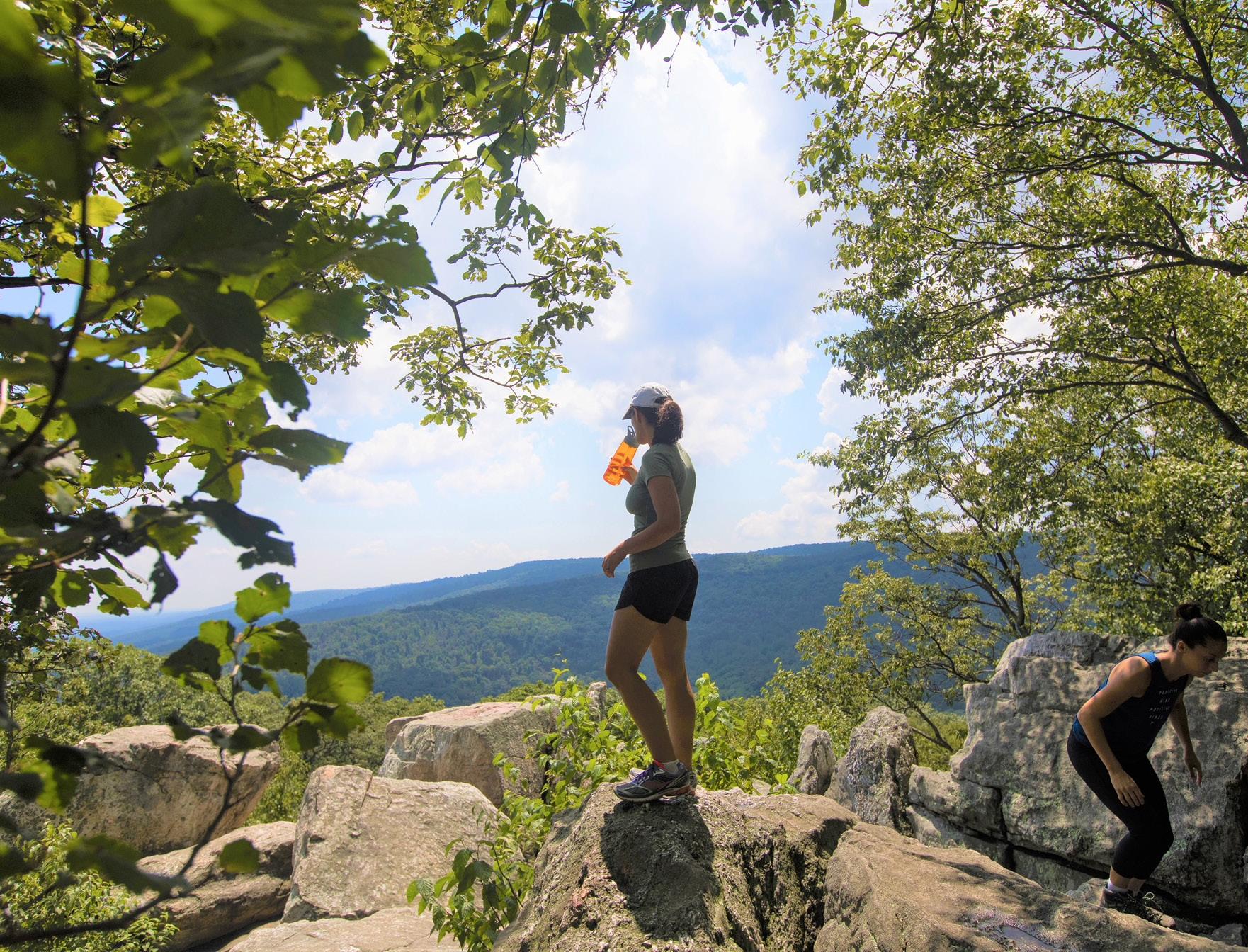

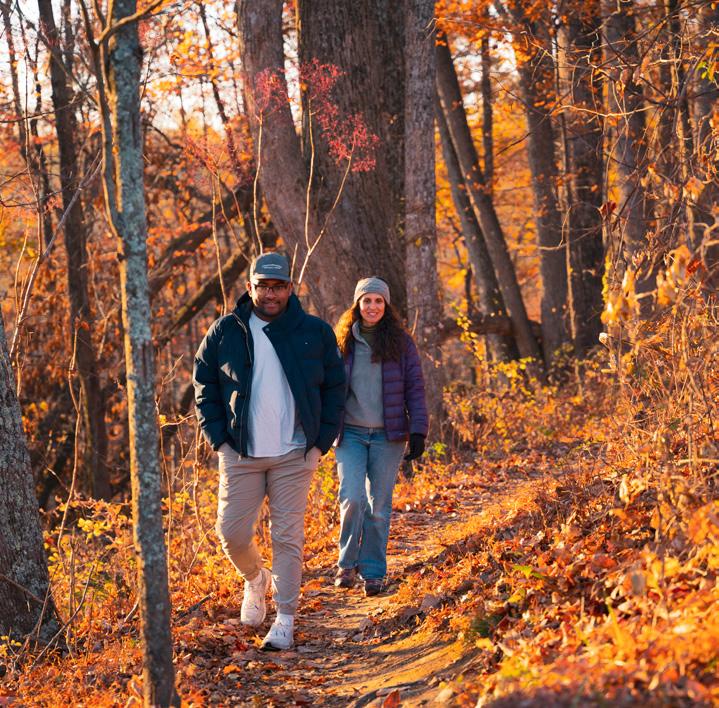
The Blue Ridge Mountains provide endless opportunities for scenic hikes, spectacular views, and lasting memories. Nestled in the foothills, Charlottesville and Albemarle County offer access to our favorite mountains and more, with various natural areas, city paths, and forest preserves to explore.
Just a short 30 minute drive from where the Blue Ridge Parkway meets with Shenandoah National Park, it is a no-brainer to use Charlottesville as a basecamp for your Appalachian hiking adventures. The famed Appalachian Trail meanders through both the Parkway and the Park, where you can also find great day hikes with summit views at Humpback Rocks and Blackrock Summit
Explore Charlottesville’s natural beauty at Ragged Mountain Natural Area, a stone’s throw from downtown. With a 6-mile loop around the reservoir offering captivating views, it’s perfect for nature enthusiasts. Just outside Charlottesville, Ivy Creek Natural Area and River View Farm integrate history into a hike. The area was once owned by Hugh Carr, a former slave, and now spans 125 acres and showcases the family barn

on weekends. Discover the property’s historical roads and springs, making for a rich outdoor experience.
Experience a National Parklike hike at Patricia Ann Byrom Forest Preserve, where steep ascents at the base of the Blue Ridge lead to the 2,300-foot Little Flat Mountain loop, offering breathtaking valley views. The entrance monument, a project by Albemarle Blue Ridge Heritage, honors the families displaced by Shenandoah National Park.
To find more hikes and additional trail information, visit the Trails and Outdoor Routes pages on VisitCharlottesville.org!
The Rivanna Trail is great for a leisurely hike within the city that passes by great breweries, restaurants, and cafes. Circumventing the city of Charlottesville, hikers can trek the whole 20+- mile trail or smaller segments, and grab some refreshments afterward. The historic pedestrian Downtown Mall is another excellent place in the city to dine outdoors, enjoy live music, and spend the night.
Sip world class wines at the 40+ wineries on the Monticello Wine Trail, all within 25 miles of Charlottesville. Visitors can experience Virginia winemaking, with
a backdrop of the bucolic countryside and mountain silhouettes. October is Virginia Wine Month, and what better place to enjoy it than in Wine Enthusiast’s 2023 Wine Region of the Year? Many local wineries are having special events throughout the month for folks to enjoy.
Plan a midweek stay for more flexibility in the fall, as weekends can get busy. You’ll find plenty of charming accommodations, from bed and breakfasts and boutique hotels to historic inns and relaxing resorts.
VisitCharlottesville.org
Spotsylvania is celebrating its 300th anniversary in 2021 with a series of programs Heyward Community Forest, which surrounds Ragged Mountain Natural Area, features a serene stream trail with cascading water flowing into multiple pools.
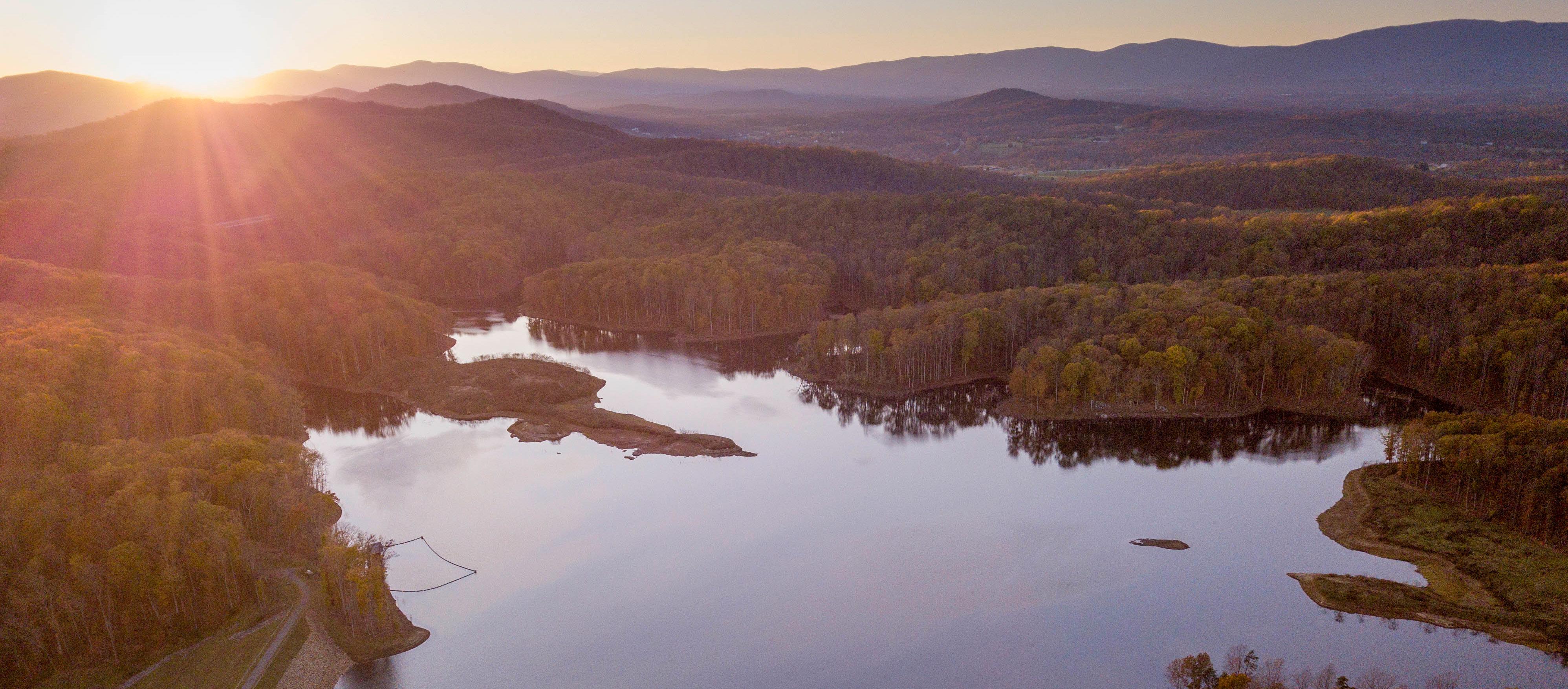

For those who love the outdoors, Kentucky’s capital city invites you to “take a hike.” There are over 40 miles of hiking trails scattered throughout Franklin County. Whether you’re a casual stroller, a brisk walker or a serious hiker, there’s bound to be a trail just for you.
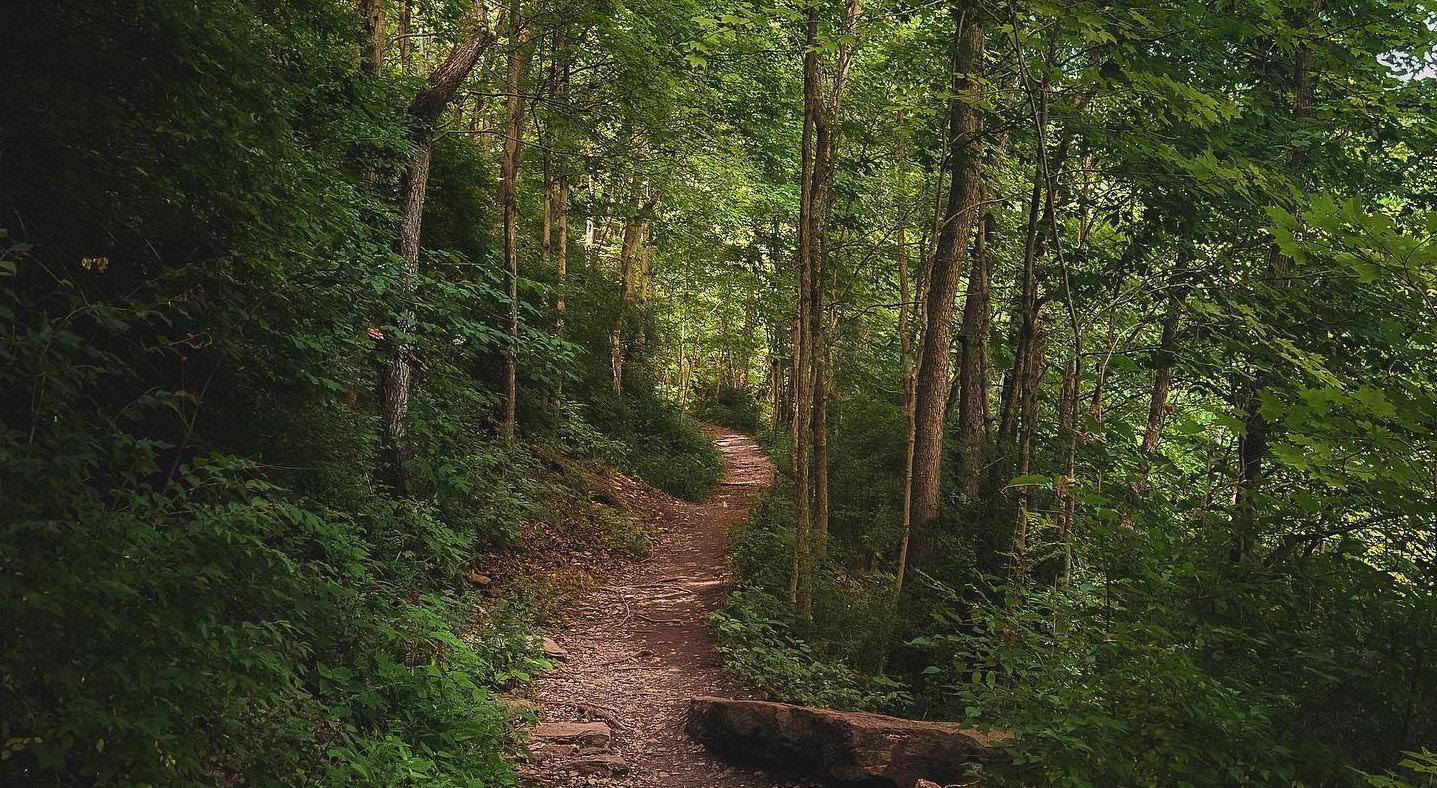

For a leisurely stroll with outdoor art, the trails at Josephine Sculpture Park offer a pleasant walk. If you prefer nature, the 0.5-mile Vaughn Branch Nature Preserve Trail leads to a large sycamore tree, a symbol of the forest ecosystem.
For those seeking a longer hike, Fort Hill in Leslie Morris Park features a 1.2mile loop with Civil War history, a cave, and city views. The 1.8-mile Thorobred Trail is great for dog walking and bird watching, while the trails at Buckley Wildlife Sanctuary meander through 370 acres of woodlands and meadows.
For intermediate hikers, the 1.9-mile Lakeview Park Trail has gentle hills, and the 1.4-mile Riverview Park Trail offers scenic views of the Kentucky River, ending at Buffalo Trace Distillery for a tour and tasting.
For more challenging hikes, Cove Spring Park provides 6.7 miles of trails through wetlands, streams, and forests. Salato Wildlife Center features four miles of trails and diverse wildlife, including elk and bald eagles. The 2.41-mile Pea Ridge Loop is a favorite for its rugged terrain and forested ascents and descents.
At West Sixth Farm, explore four miles of trails near hop fields used by West Sixth Brewing. While most trails cater to intermediate and expert hikers, the 0.7-mile Farm Loop Trail is more accessible. The trails are open for hiking, running, and mountain biking, with additional activities like cornhole and disc golf. Don’t forget to visit the taproom and food truck at West Sixth Cantina for a local brew and a bite to eat.
VisitFrankfort.com
HIKE HIGHLIGHTS
Spotsylvania is celebrating its 300th anniversary in 2021 with a series of programs In addition to the hiking trails, Salato has two fully stocked lakes for fishing, and 12 miles of trails open for both hiking and biking at Capitol View Park. As a bonus, some of the trails provide an excellent view of the Kentucky State Capitol Building!

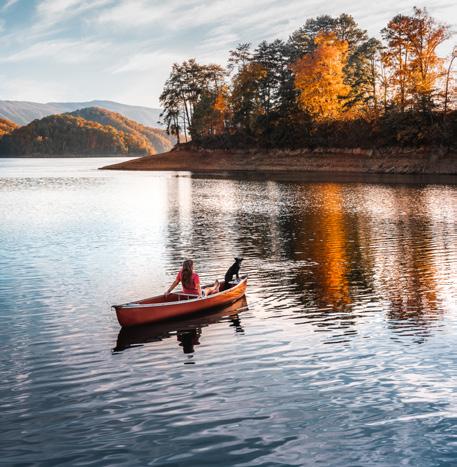
Because of its location in the foothills of the gorgeous Appalachian Mountains, the scenery in Bristol is always worthy of a visit, but when fall rolls around, it reaches its peak. Whether you’re more of a casual leaf-looker or a hardcore hiker during the autumn months, Bristol offers an abundance of sites you can visit to enjoy the area’s vibrant colors.
featuring the scenic “Abrams Creek Crossing,” a perfect spot for fall photos.
South Holston Lake is an ideal destination for autumn hikes, offering stunning views from South Holston Dam. The lake is framed by vibrant fall foliage, pristine waters, and miles of untouched shoreline. Visitors can also enjoy a variety of activities, including boating, kayaking, fishing, camping, and biking.
Steele Creek Park, Tennessee’s thirdlargest municipal park, offers over 2,200 acres of fall beauty. Its 52-acre lake and surrounding hills turn into a stunning palette of reds, oranges, and yellows. Choose an easy lakeside hike or tackle the Ridge Runner Trail for panoramic foliage views. The park is perfect for kayaking, fishing, golf, disc golf, and biking.
Sugar Hollow Park’s 400 acres also provide incredible fall views, making it ideal for hiking, camping, and outdoor sports. For more autumn beauty, visit the Mendota Trail, a 12.5-mile hiking and biking path

BEYOND THE BEATEN PATH
While enjoying Bristol’s autumn beauty, don’t miss these attractions. Visit the Birthplace of Country Music Museum, a Smithsonian affiliate, to explore Bristol’s role in music history. For racing fans, Bristol Motor Speedway and Dragway are mustsees, two of the world’s most famous racing facilities. Check out the Bristol Casino - Home of Hard Rock Hotel, offering over 1,500 slot machines, 75 gaming tables, and 300 hotel rooms.
Be sure to explore The Pinnacle, the region’s largest outdoor shopping center, historic Downtown Bristol with its local restaurants, breweries, and shops, and The Falls for new dining and shopping options.
ExploreBristol.com
HIKE HIGHLIGHTS
Spotsylvania is celebrating its 300th anniversary in 2021 with a series of programs For those looking for a longer hike, the South Holston Lake area is close to the famous Virginia Creeper National Recreation Trail!
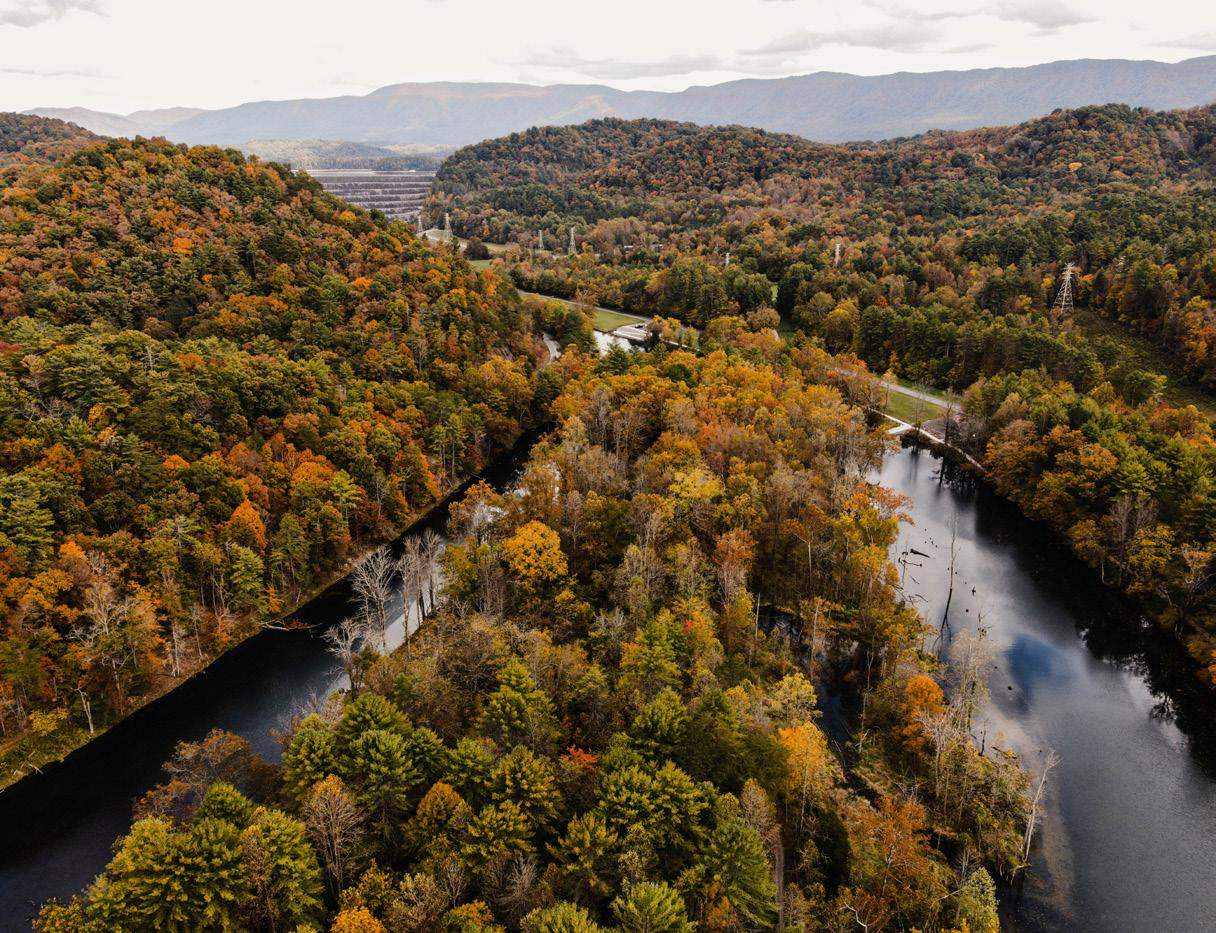
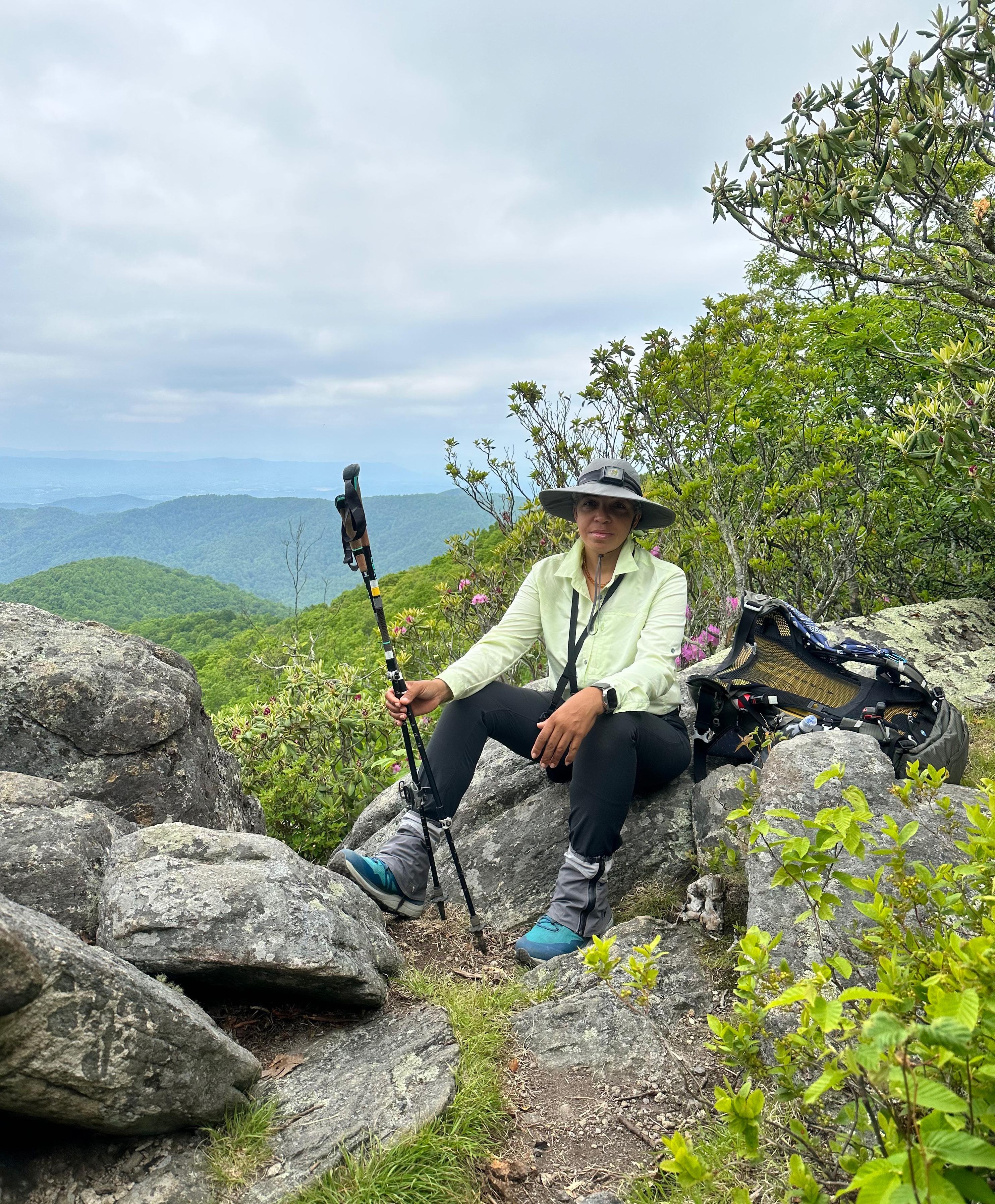
How one woman’s journey is making the Appalachian Trail a safer, more inclusive space
BY LAUREN STEPP

THE DARKENING SKY FLASHED bright with lightning as Stacee “Dragonfly” Ash entered the Chestnut Knob Shelter near Tazewell, Va. After logging 19 miles on the Appalachian Trail (A.T.) that day, Ash was hungry, thirsty, and tired. She wanted nothing more than to curl into her sleeping bag and sleep. But sleep wouldn’t come easy that night.
When Ash sat her heavy pack down in the shelter, a white thruhiker turned to her and narrowed his eyes.
“There’s no place for you here,” he growled. “You need to keep moving.”
The weight of his words hung heavy in the air. Other thru-hikers Ash knew—people she considered friends—looked away while the man continued screaming.
“I felt like I couldn’t breathe,”
Ash remembers. “I don’t know what hurt me more: the man forcing me to leave or the silence of people I knew—people I hiked with, went to town with, shared food with.”
Embarrassed and heartbroken, Ash quietly collected her things and headed outside. The next shelter was nine miles away—too far to cover on spent legs. Tent camping was also an impossibility because of high winds.
Not sure what to do, she walked outside, tears streaming down her face. She couldn’t help but think maybe the man was right—maybe there wasn’t a place for a Black woman on the A.T.
“It was the only time I thought about going home,” says Ash, who works as an early childhood specialist in Huntersville, N.C. “It was the only time I thought about quitting.”
But she didn’t. Instead, she hiked to cell service, called a hostel, and resumed her trek the next morning. Then, on September 15, 2023, she summited Mount Katahdin, becoming the first known Black woman from North Carolina to thru-hike the A.T.
Polishing off the A.T. is an incredible accomplishment in and of itself. But Ash’s achievement is especially noteworthy considering the A.T. thru-hiking community is overwhelmingly white. Of the 3,000 people who attempt the famous footpath each year, fewer than one percent are Black. Even fewer are Black women, and a tiny, almost immeasurable, percentage are Black women over the age of 50.
“I was a unicorn on the trail,” Ash, who is 55, says with a laugh. “I am living proof that you are never too old to try something new.”
A New York native, Ash went on her very first hike in 2019. A few years prior, her brother-in-law, Dale Jones, had introduced her to kayaking—a sport she quickly picked up. Determined to spend more time outdoors, Ash trekked to Catawba Falls in Pisgah National Forest. It was her very first time hiking, and she expected to be bitten by a snake or mauled by a bear. Instead, she fell in love with the woods.
“I hiked that trail over and over and over,” says Ash, whose trail name, “Dragonfly,” nods to the fact that, much like the winged creature, she started adventuring in the water and later evolved to land.
Supportive of Ash’s new hobby, a friend bought her a puzzle of the A.T. Never having heard of the trail, she clicked the pieces together mindlessly. It was only after the
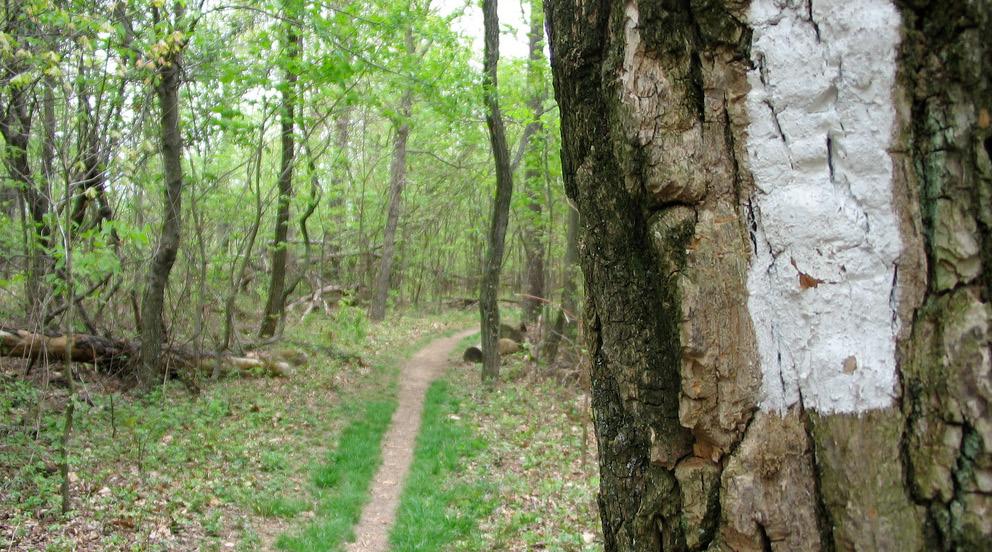
FEWER THAN ONE PERCENT OF A.T. THRUHIKERS ARE BLACK. PHOTOS COURTESY OF THE APPALACHIAN TRAIL CONSERVANCY



puzzle was complete that Ash considered the reality of walking 2,190 miles from Georgia to Maine.
“I sat there tracing this dotted line with my finger thinking, ‘This is insane,’” says Ash.
Intrigued, she bought a book about the A.T. and drove to see a white blaze in person. Then, one night in 2022, she had a dream. In the dream, a voice said, “In 2023, you’re hiking the A.T. because you deserve space in every room.” The next morning, Ash woke up and knew she was going to walk to Maine.
“This voice spoke to my spirit,” she says. “I wanted to break stereotypes and normalize [that] this trail is for everyone. We can’t make change by sitting in our
comfort zone.”
On March 7, 2023, Ash began her journey. The next six months were anything but easy. Besides the incident at Chestnut Knob Shelter, Ash was targeted by a hostel owner and was the victim of countless racial microaggressions. She also broke her left wrist in two places while trying to dodge a rattlesnake in New York.
“I returned the next day and completed the last 800 miles with a purple cast,” says Ash. “Everyone was stunned by watching my determination on the trail. I had bruises, cuts, and lots of pain, but I didn’t stop trying to reach my goal.”
Despite setbacks, Ash also experienced plenty of trail magic.





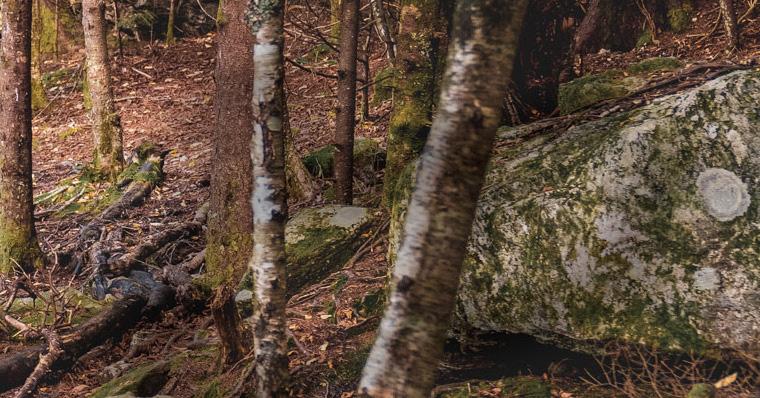
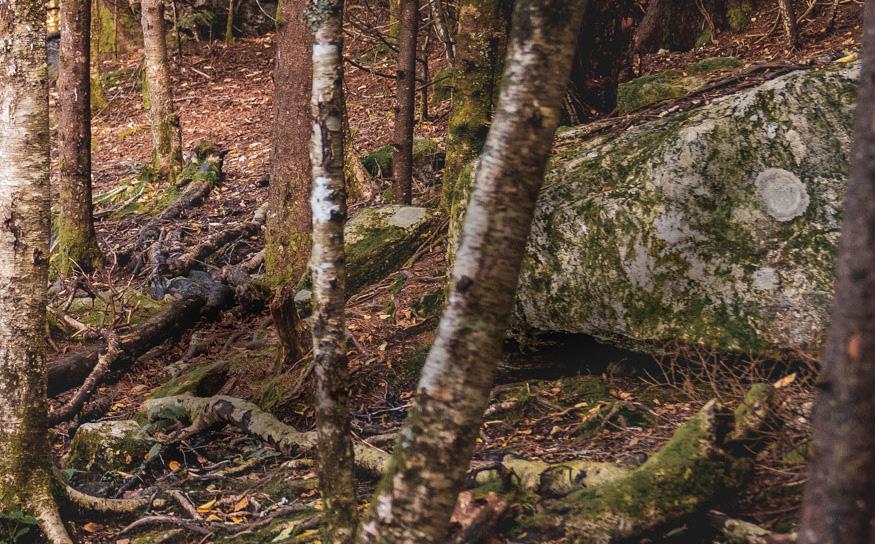

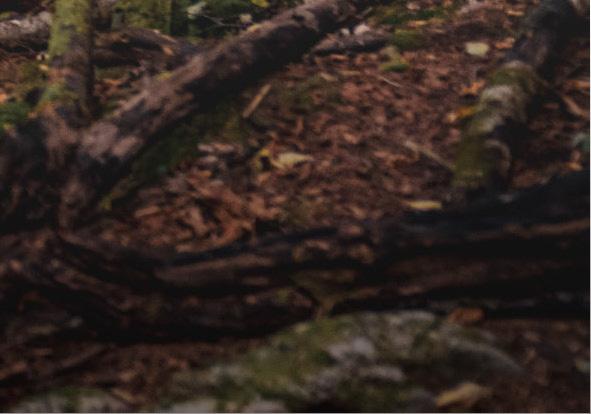
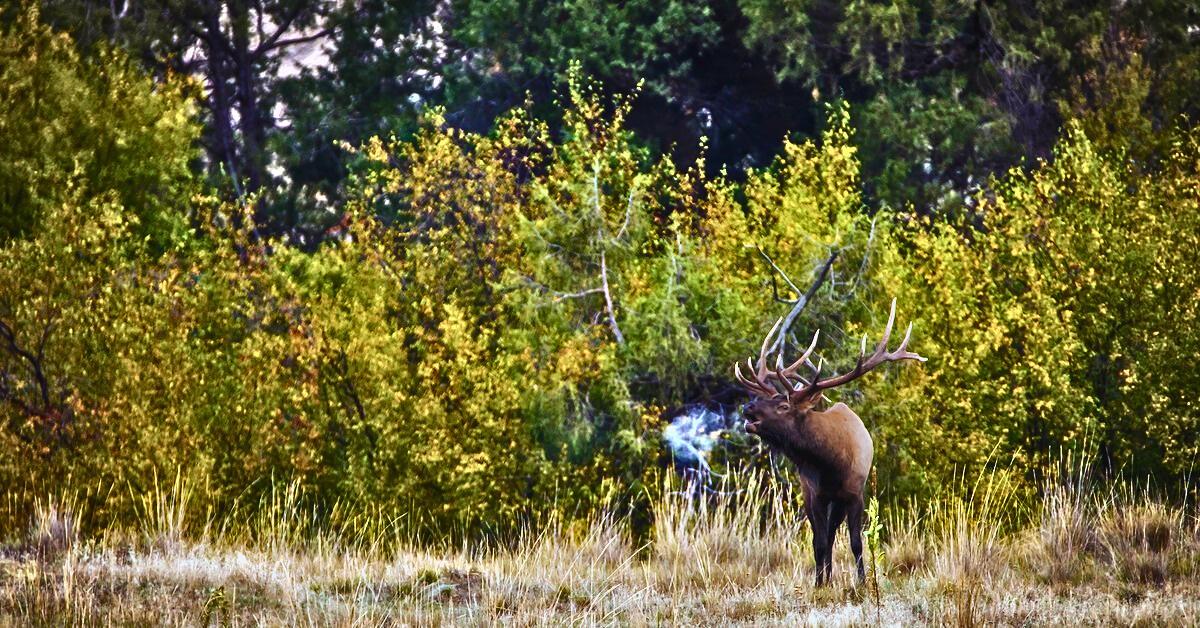
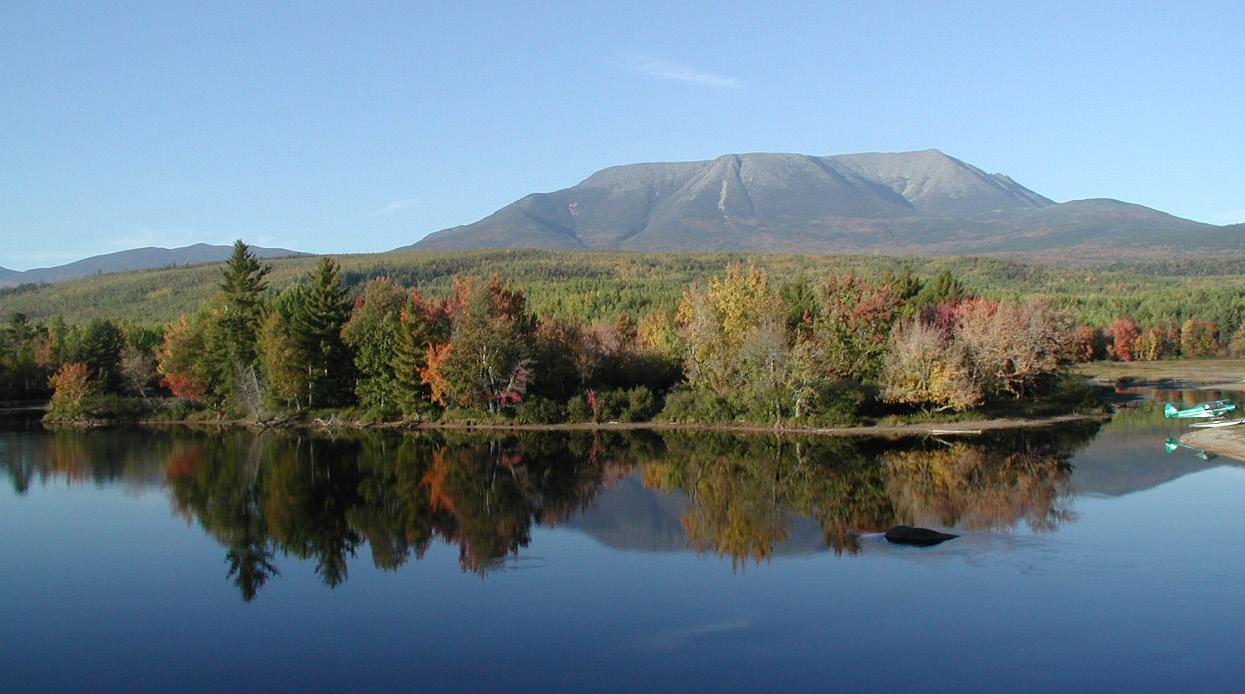

Guided



Mountain
Kids
Craft
Trucks
Lodging/Camping










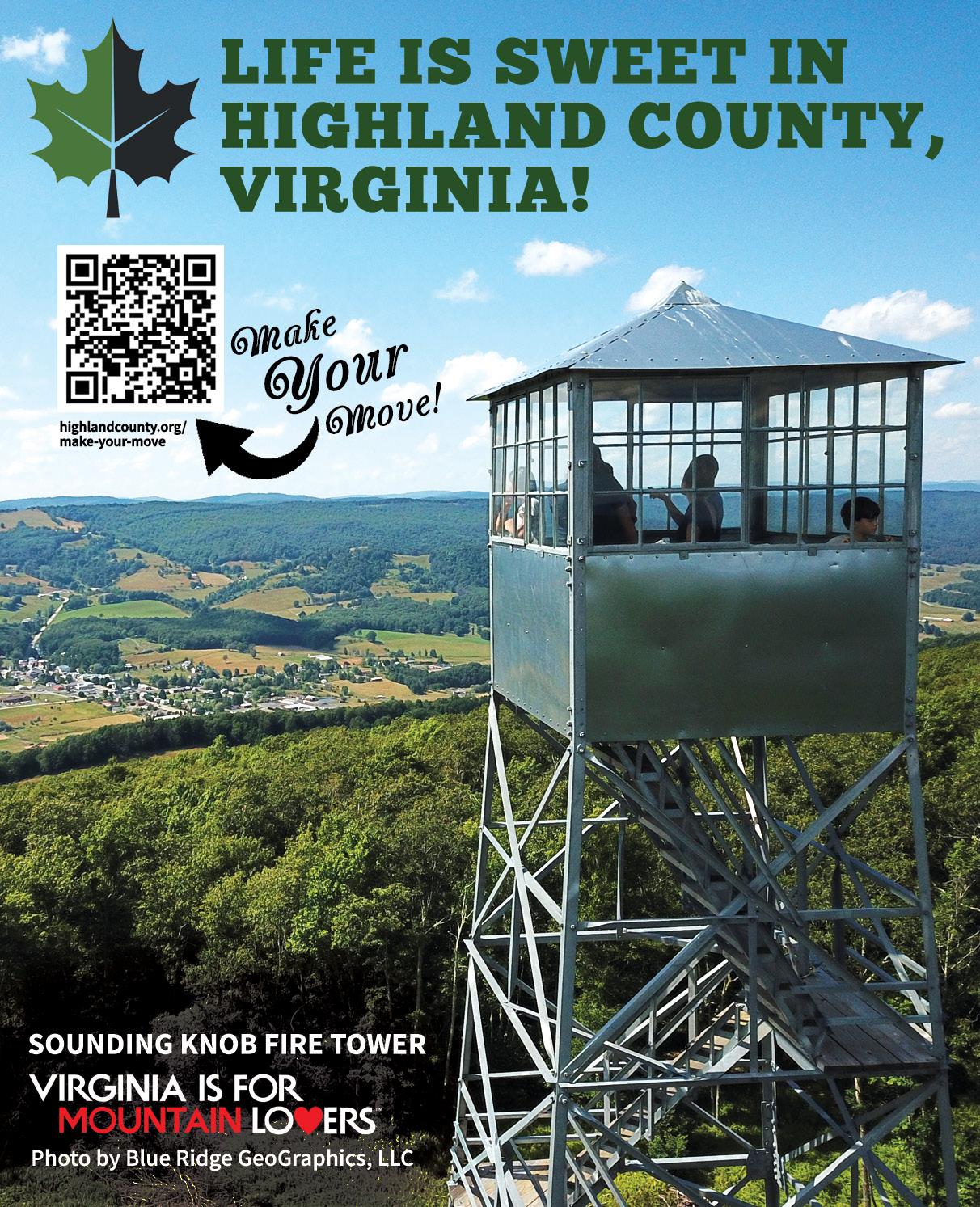
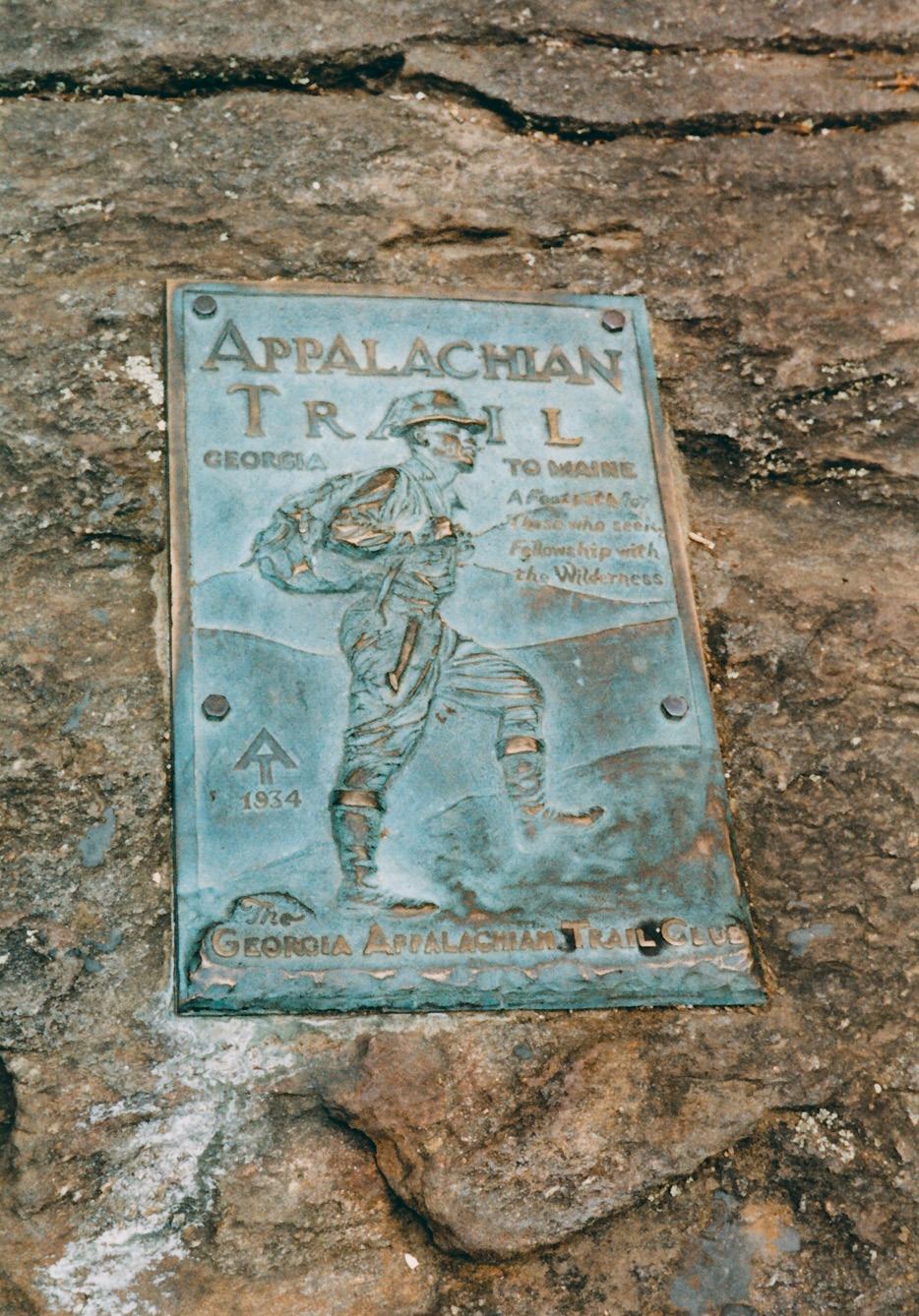
After shattering her phone in Massachusetts, for instance, a retired couple drove her to the nearest Verizon store. Afterward, they fed her dinner and took her to an opera in New York.
“It was the most epic experience ever,” says Ash. “Who can say they went to an opera while hiking the A.T.?”
During another instance, Ash was hiking into town after a 20mile day when an older gentleman offered her a ride to the hostel. At the end of the ride, he politely asked Ash if they could take a photo together so he could share her story with his grandson, who was biracial.
“As I got out of the car, he told me, ‘You keep moving, Dragonfly. You make it to Katahdin,’” Ash remembers, her voice cracking with
emotion. “I was in tears.”
Ash says the kind, compassionate people she encountered along the trail far outnumbered the hateful ones. But there’s still work to be done to make the outdoors an inclusive, safe space for all.
“It’s going to take visibility,” she says. “Showing different faces of the A.T. will allow people to connect and see themselves on the trail. I hope that my story inspires other people to embrace nature.”
So far, it has. Since Ash completed the trail, her local REI has seen a tremendous uptick in Black women getting fitted for gear. According to employees, these customers cite Ash as their motivation.
“Lately, I’m either laughing or in tears,” she says. “I’ve seen so much beauty. Things are changing.”
















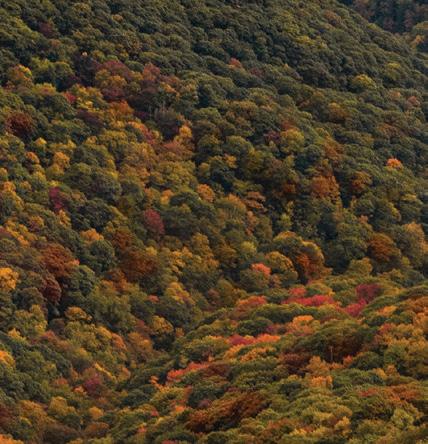

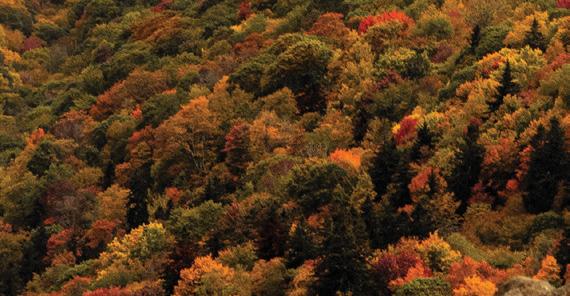













Stunning views and rock scrambling makes for a classic day hike in Virginia’s Shenandoah National Park
BY MIKE BEZEMEK
THERE’S SOMETHING THRILLING about summiting a mountain. This feeling was palpable among the 20 other hikers heading uphill from the Old Rag parking lot. The Ridge Trail wasn’t too crowded, but almost everyone seemed to be sprinting out of the gate, trying to get in front.
“Let’s pace ourselves,” I suggested to my wife. “We’ll probably just pass them all later.”
We stepped off the trail to let a group of laughing college kids practically run past. There was no need to hurry. It was 9 a.m. on a foggy Thursday morning in early August, with temps in the mid60s. We had plenty of time to complete the 9.4-mile loop, which starts with an elevation gain of 2,348 feet when heading in the suggested clockwise direction.
I’d heard good things about this challenging summit hike, which is the most popular trail in Shenandoah National Park. Many of the park’s 1.5 million annual visitors come from the Washington, D.C. metro area, located about 90 miles east. In recent years, Old Rag had developed a reputation
for overcrowding, particularly during summer and fall weekends. At times, lines of hikers might form below the trickier spots.
Then in 2022, the park service followed a growing trend at popular outdoor sites. They instituted a daily quota system, capping Old Rag users at 800 per day. The $2 tickets are released on Recreation.gov, with half available 30 days in advance and the rest available five days ahead. Two weeks before, I’d targeted our hike for a weekday, not knowing what to expect. When we checked in at the entrance station, the ranger said only about 350 spots had been reserved that day.
For a mile, the trail rose gradually through an impressive hardwood forest before steepening with a series of rocky switchbacks. As predicted, we slowly passed most of the groups who had rushed ahead at the beginning. Some folks were resting on rocks. Others kept
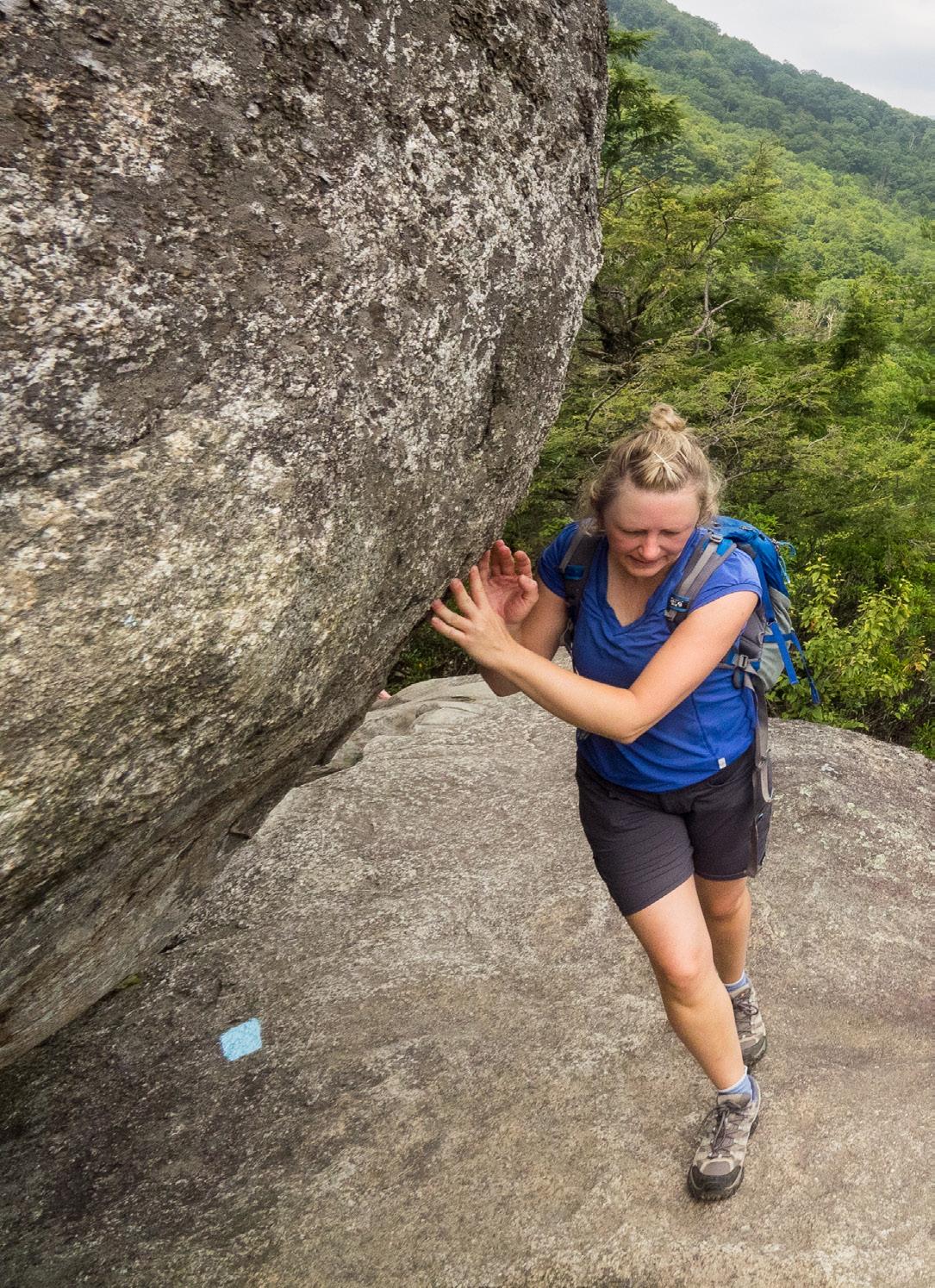
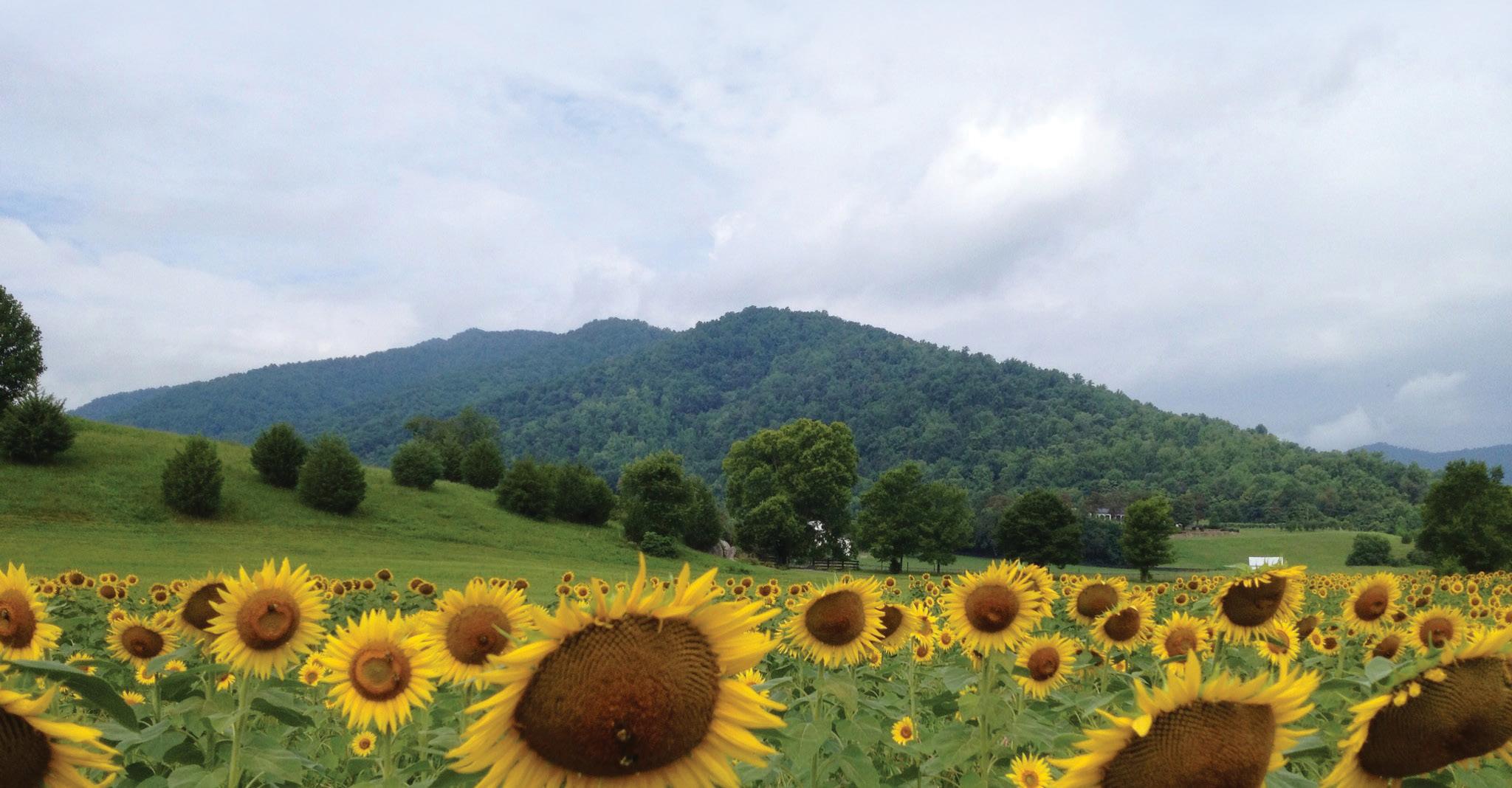
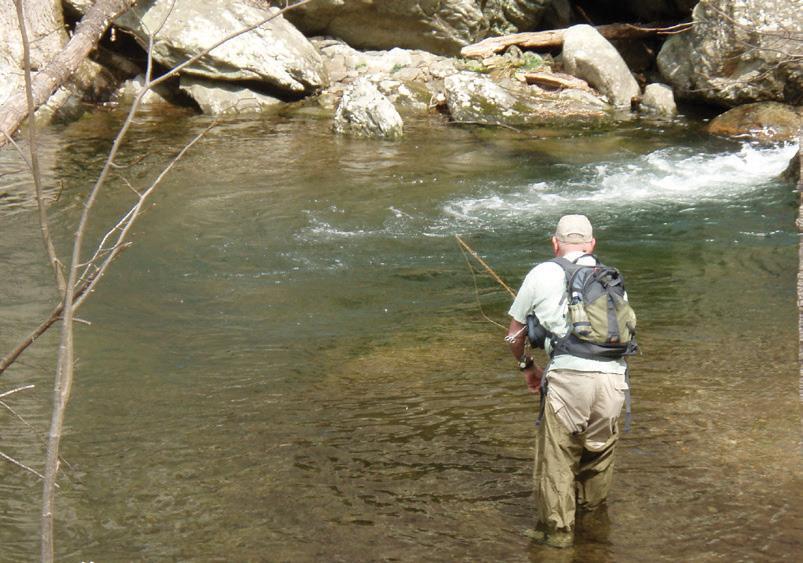
Find your MAD WanderLOVE, the strong desire to travel to and through Madison. Take a road trip! Come for the hiking, history, artisans, scenery, fishing, breweries, wineries and more. Stay in a B&B, cabin, camper, RV, lodge, vacation rental house, tent or even a yurt!




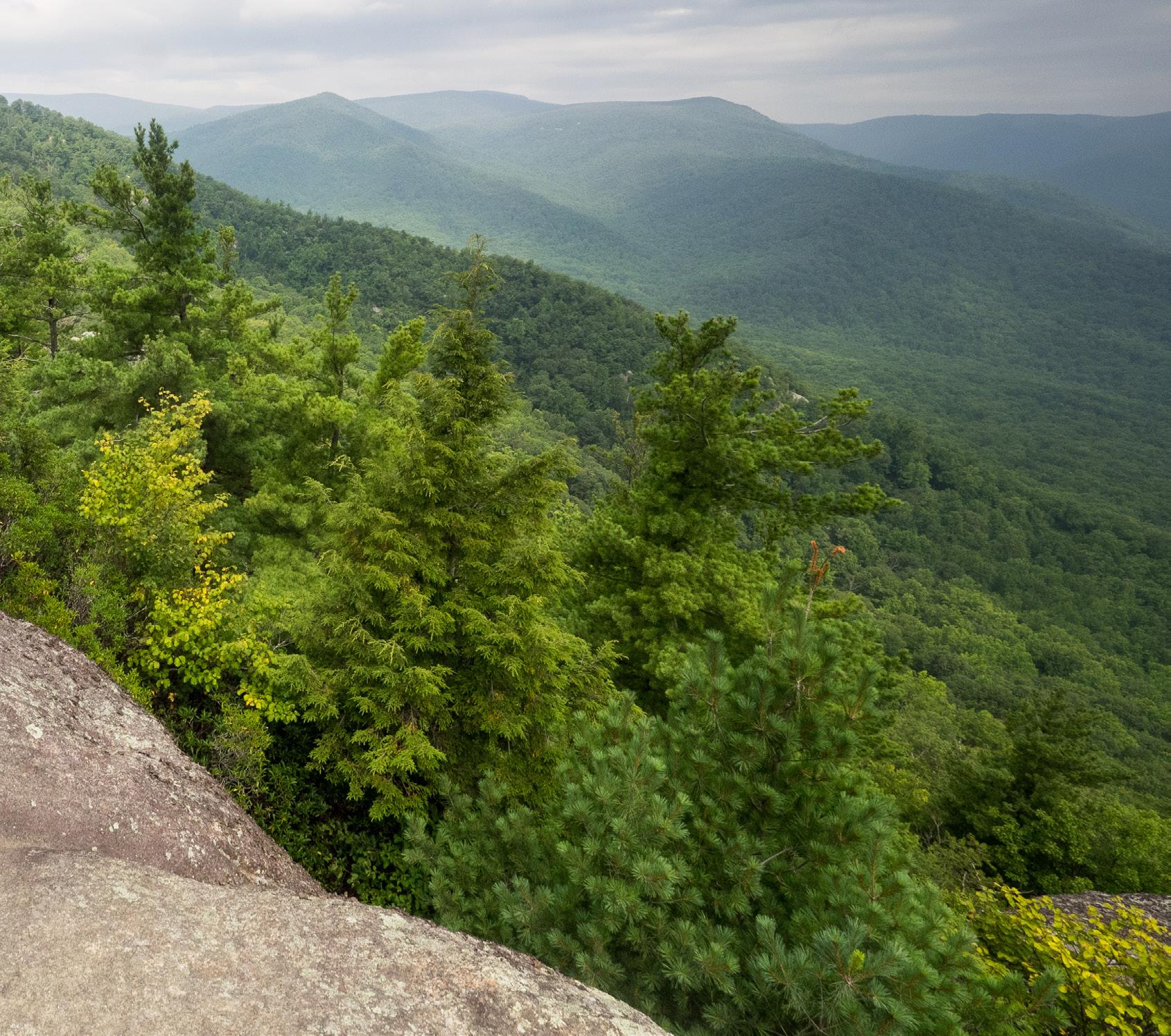
glancing nervously uphill. A few people turned around and went back down.
As we ascended, deciduous trees gave way to an increasing number of conifers. A steady mist blew eerily through the treetops. After about 2.5 miles, we emerged on a sparsely vegetated ridgeline and began traversing granite slabs and ledges. The fog had lifted by now, and occasional viewpoints revealed a string of colorful specks. These were people slowly making their way toward the summit. To either side were wide open views of the shadowy peaks and ridges of the Appalachians.
The repeated exclamations of nearby hikers made it clear why this is such a beloved route. By now, we’d made friends with a few groups moving at roughly the same pace. Occasionally, we took breaks together and chatted about our impressions of the park.
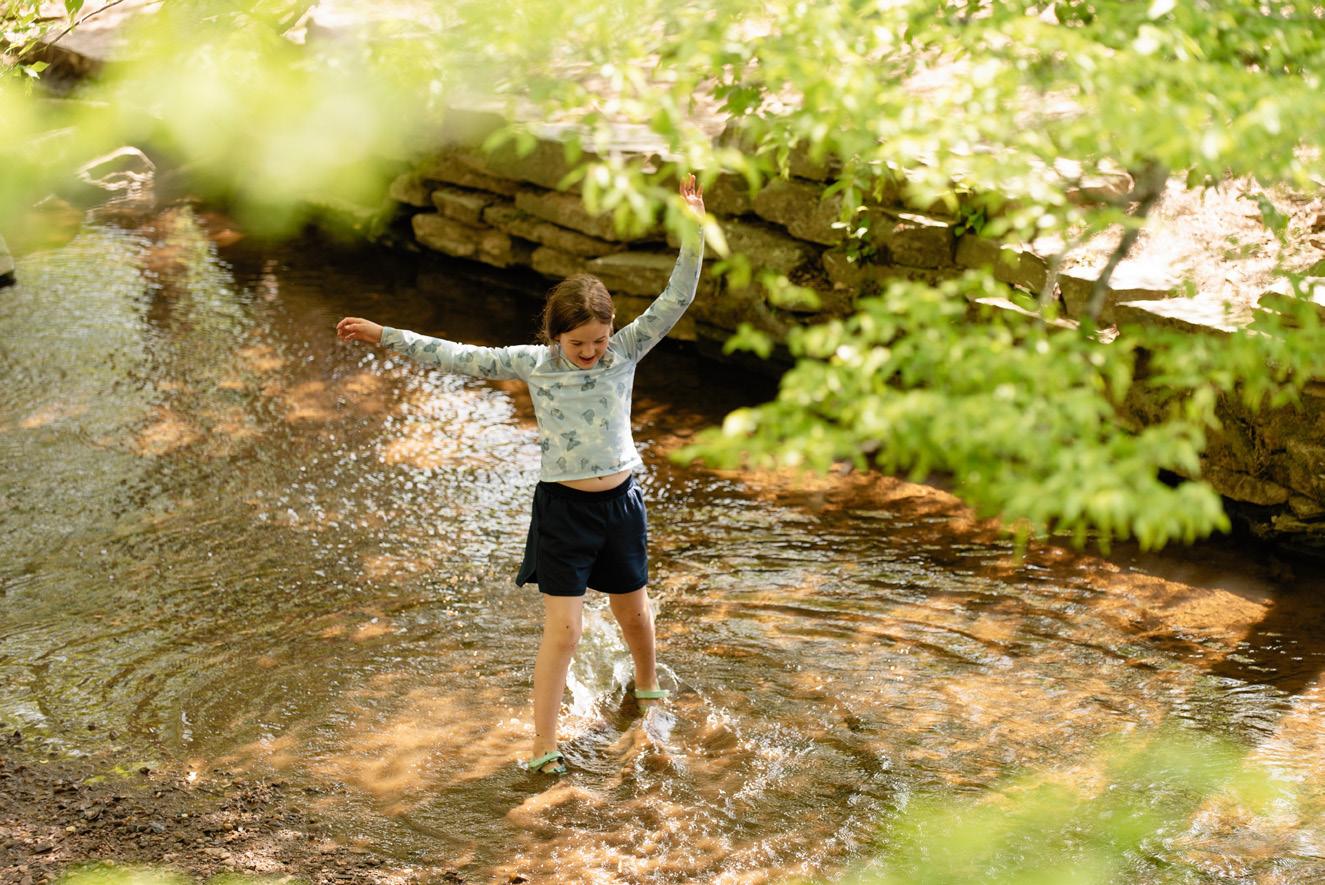

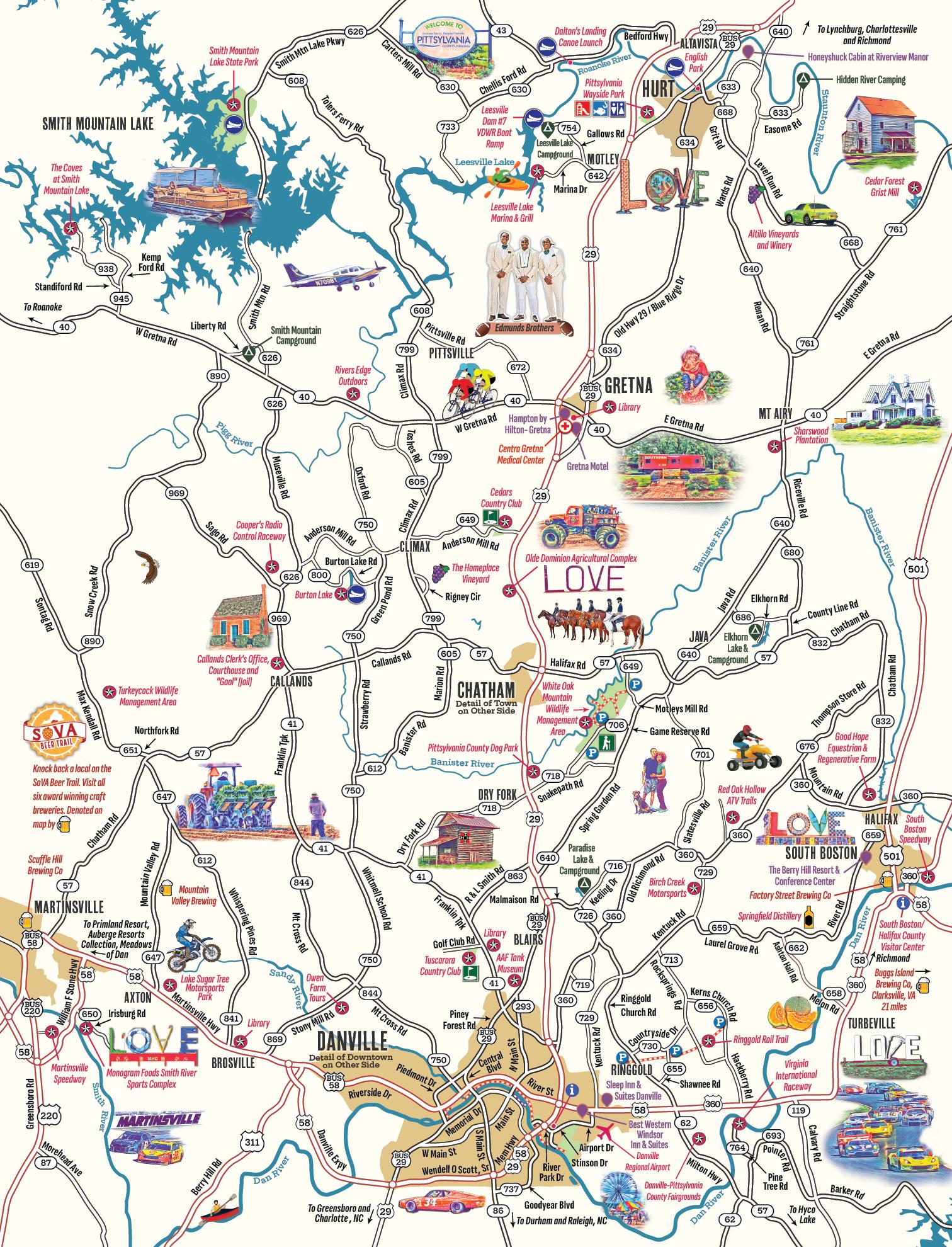
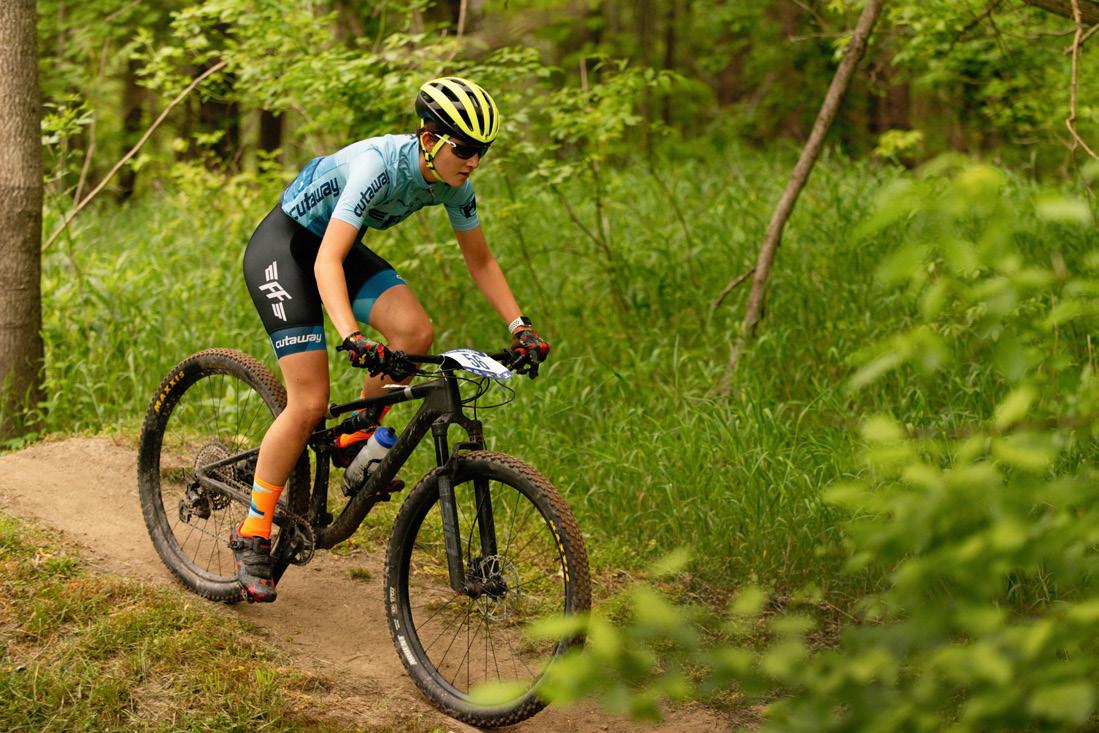
Embrace the great outdoors on the Southern side of Virginia. In Danville and Pittsylvania County, adventure awaits around every corner! Whether you're into hiking, biking, fishing, or water sports, SoSi offers endless opportunities to escape, explore, and connect with nature. Discover why SoSi is the ultimate playground for outdoor enthusiasts. What are you waiting for? Plan your adventure at VisitSoSi.com
style national parks—like Yellowstone and Yosemite—in the Southern Appalachians. However, obtaining the needed lands in these more populated regions was much harder than reappropriating federal lands in the West. Numerous private parcels had to be acquired in Virginia, North Carolina, and Tennessee through purchases, donations, and controversial declarations of eminent domain. The process was still underway in the early 1930s when a third unit, the Blue Ridge Parkway, was authorized to connect the two national parks.
Summiting Old Rag was the main goal for our first visit to Shenandoah. Yesterday, we’d put our camper at the wooded Big Meadows Campground. At just over 3,500 feet, this popular area often has a steady breeze and mild temps compared to the valleys below. After setting up, we walked over to the visitor center and did a short hike to Dark Hollow Falls. Camping at Big Meadows put us in the heart of the park, about an hour from Old Rag. It’s important to note that the trailhead is located on the eastern edge of the park, so you have to drive out and around through Sperryville.
Aside from Old Rag, Shenandoah’s



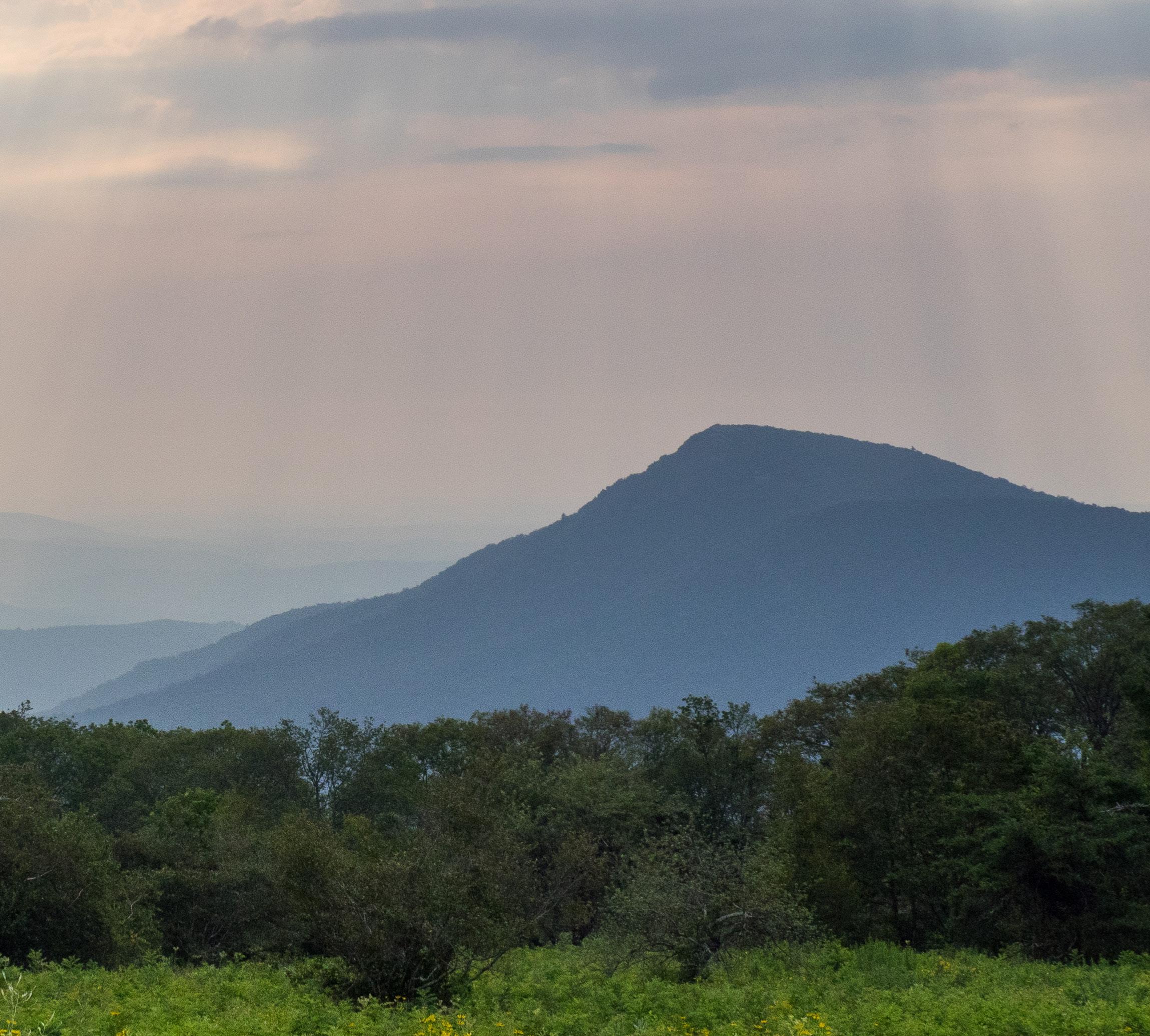
primary feature is the 105-mile Skyline Drive. Like the parkway, it follows the crest of the Blue Ridge Mountains. Along the way, there are lookouts, campgrounds, lodges, waterfalls, hiking trails, and over 90 named peaks. Among those peaks, many are capped with greenstone, a type of metamorphic volcanic rock. This includes the park’s highest point, Hawksbill Summit at 4,050 feet, which can be reached by several short but steep trails just off Skyline Drive. Despite being on the shorter side, Old Rag is unique for its granite bedrock and massive boulders that hikers increasingly encounter as they approach the 3,284-foot summit.
The best part of hiking Old Rag began about a mile below the summit, around 2,200 feet. That’s where the trickier rock scrambling started. At first, this mostly involved mounting rounded boulders using hands and feet. My wife was doing well but getting wary about what was to come. Glancing ahead, we could see the terrain steepened.
“This is tough,” she said, wiping away


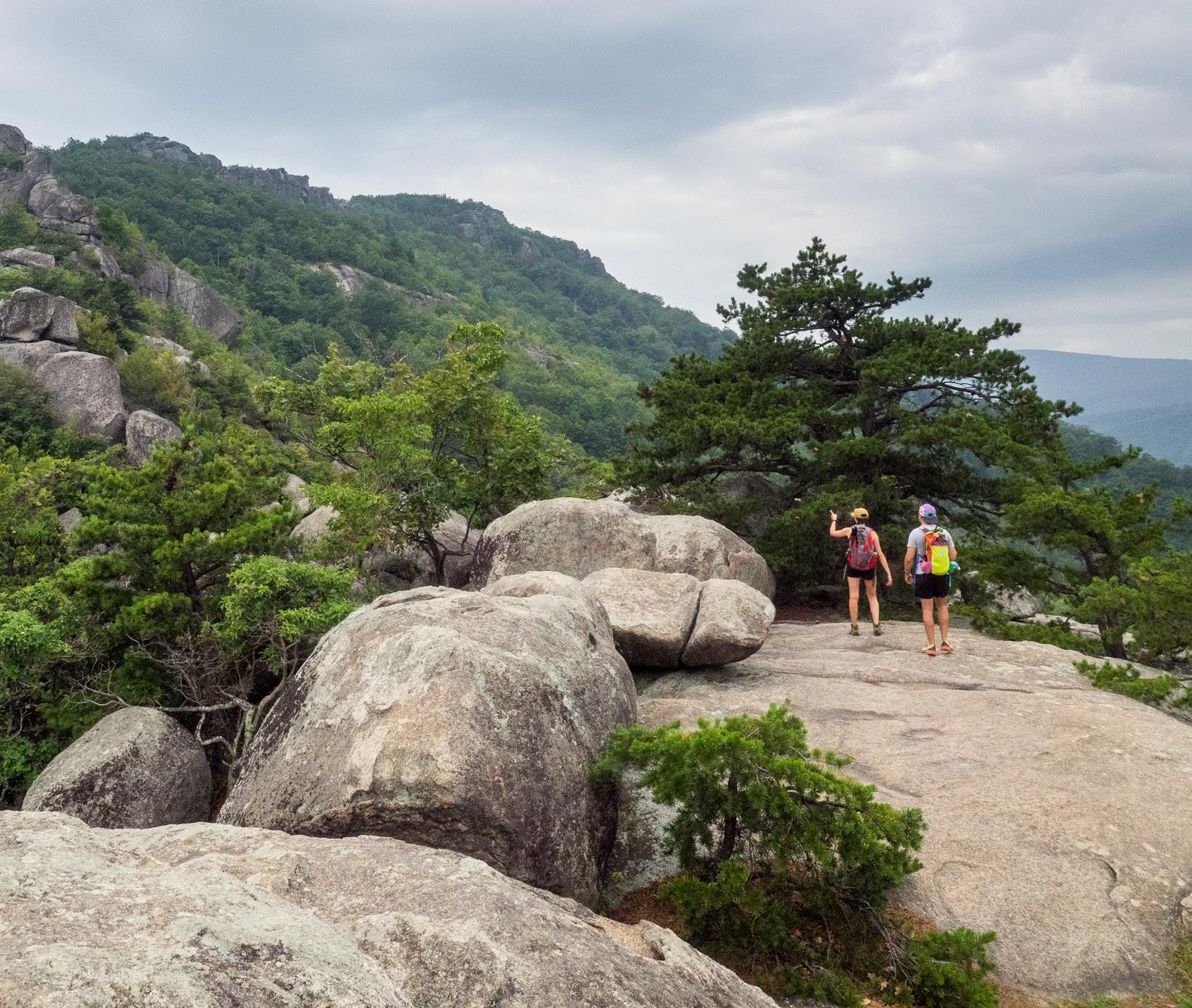

sweat during a break.
One reason for her nervousness was due to our prior encounter with a “big talker.” Three months before, we were chatting with a hiker on a waterfall trail in the Smokies. When he heard we were heading to Old Rag, he turned serious.
“That’s a dangerous hike,” he said. “You’re basically rock climbing without a rope.”
The way he went on to describe ascending Old Rag, like it was comparable to free soloing El Capitan, did not sound accurate. But his warning had clearly rattled my wife.
“Maybe I should skip that one,” she said, the moment he was gone.
I disagreed. The guy was clearly talking himself up by over-selling the difficulty of Old Rag. Yes, we needed to be cautious, but the route was a scramble, not a big wall climb. Still, he’d sowed enough doubts for me to toss in my backpack a short rope that never got used.
After a quick rest, my wife and I reached our first real “move” on Old Rag. A sunken crevice about eight feet deep. There were several ways to descend, and it reminded me of exploring slot canyons out West. Our technique involved scooting forward into the




gap and lowering ourselves using legs, arms, and bodies to wedge against the walls. Once our feet rested on a narrow ledge, we crept carefully to the end.
Not everyone was as experienced, and two college girls behind us seemed overwhelmed and about to give up. My wife slipped into teacher mode. She scrambled back up the slot and demonstrated the technique. The first girl taught her friend, and gradually all three emerged, brimming with confidence.
From here, we skirted along some cliffs. Clambered over rocks and up bare slopes. Occasionally, the route followed cracks or passed under small alcoves. Sometimes we handwalked. A few times we crab-walked. One intriguing feature was a natural staircase rising up through another narrow crevice. We spent an hour on the rock scramble, stopping often to wait for others, pace ourselves, and enjoy the views.
By noon we were on top, having lunch while sitting on smooth boulders. Nearby were a dozen other hikers, each of them clearly tired but buzzing with excitement. Always a good sign.
Granite is my favorite type of rock, and it reminds me of a favorite mountain range, the Sierra Nevada in California. I’ve been atop numerous peaks there, including Half Dome in Yosemite. Hiking that 8,846-foot peak is definitely tougher than Old Rag, involving almost twice the mileage and
Deadline: November 1
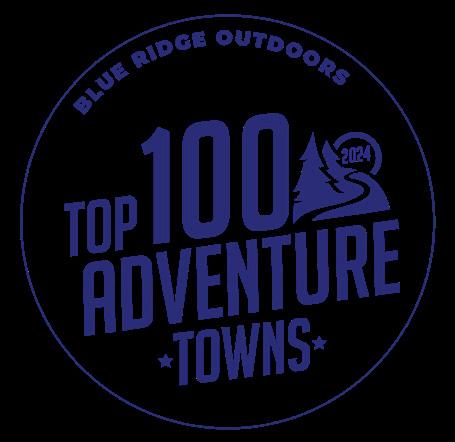
You chose your favorite outdoor destinations amongst the top 100 spots across the Mid-Atlantic and Southeast.

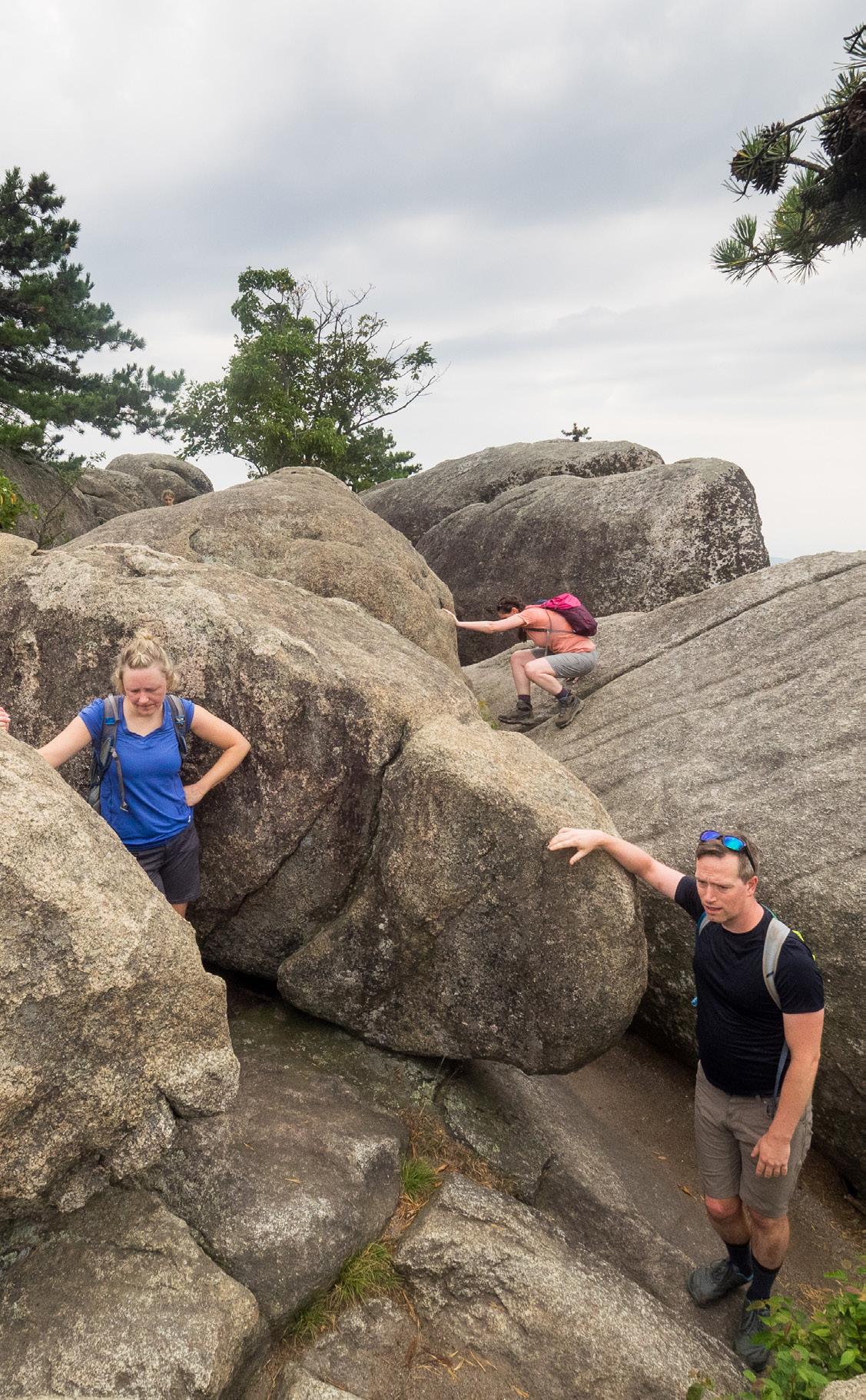
elevation gain, and ending with a careful scramble up the smooth dome assisted by cables.
Meanwhile, across the Appalachians, some of the highest peaks have been developed, with nearby parking lots allowing easy access to short, graded paths leading to observation platforms. That does make the summits more accessible to everyone, but it also can dampen the thrill for many outdoor folks.
In contrast, Old Rag offers a little bit of everything adventurers seek from a summit hike: a physical challenge, a rugged landscape, and plenty of scenic rewards.
We might have stayed longer, but thickening clouds were rolling in. Light rains caught us several times on the more gradual descent, which starts with about 1.5 miles on the Saddle Trail and ends with three miles on a fire road. As we neared the bottom, we were exhausted, in a good way.
“I think that’s one of the hardest hikes I’ve done,” said my wife.
“That is a classic national park hike,” I mused.
Like a small piece of Yosemite inside Shenandoah National Park.







BY MARY BETH SKYLIS

LEARNING HOW TO START A FIRE can be tricky. Novices often run through a whole pack of matches and wonder why the logs won’t catch. But the reality is that dialing in ignition is just a small piece of the equation. Taking steps like choosing the right tinder can make a big difference, but avid campers and backpackers also employ additional ticks to make sure blazes get going. Here are a handful of hiker fire-starting hacks.

Hikers piling on the trail miles often get hungry, but saving a bit of one salty snack can help ensure warmth before tent time. Corn
chips are notoriously oily, and oil is flammable, which means that it doesn’t take much to ignite this crunchy treat. However, most hikers find that seasoned corn chips are less likely to ignite since the seasoning is a natural retardant. So pick the original flavor to make sure your chips go up in flames.
While the laundry lint trap is designed to keep homes safe from fire ignitions, bringing a little lint to a campsite can be useful as an easy fire starter. The texture and loose pieces of fabric make it one of the best firestarting options. Just collect balls of the material and keep it dry until it’s time to use it.
Admittedly, petroleum jellydipped cotton balls make for a much messier fire starter than a number of other materials. Yet barring extreme circumstances, most households contain both petroleum jelly and cotton balls at the ready. The petroleum jelly makes a great ignition source, while the cotton prolongs the burn period. Adventurers can simply cover the
cotton balls with petroleum jelly and store them for use.
Similar to petroleum jelly, survivalists can cover cotton balls or dryer lint with wax. Campers who choose this option usually cover the cotton balls by placing them in egg cartons before pouring the melted wax on top of them. Ensure the cotton balls are entirely covered by poking the balls or moving them around with something like a fork. Eventually, they’ll solidify to make a slightly less messy fire starter. Then they can be stored in a small ziplock bag or remain in the egg carton itself.
Once that initial flame is lit, it’s time to make the fire grow. A couple keys things can help make a comfy campfire last.
• Ensure Your Materials are Dry : Start by collecting small twigs and sticks and increase their size as the fire gets bigger. And always look for materials that are dry. This can be challenging in extra wet climates, but even during
soggy nights in the South the twigs and sticks beneath trees and in heavy brush tend to stay drier than expected. One way to determine whether the sticks are dry is to clink them together. If they feel heavy and make a thud, they are probably wet. If they sound light and hollow, they are probably dry enough.
• Optimize Airflow : It can be tempting to throw all the fire building materials in a pile and strike a match, but fires need oxygen to burn. Without enough airflow, a pile of brush may not stay lit. A good way to make sure that the interior materials are surrounded by oxygen is to either build your materials in a tipi or log cabin-shaped style. The tipi is usually seen as the most accessible method and involves placing twigs and sticks vertically before igniting the fire starter on the inside of the tipi. Log cabins have a cabin-like structure and involve placing twigs and sticks around the fire starter, but it can be more challenging to optimize airflow if new to the method.

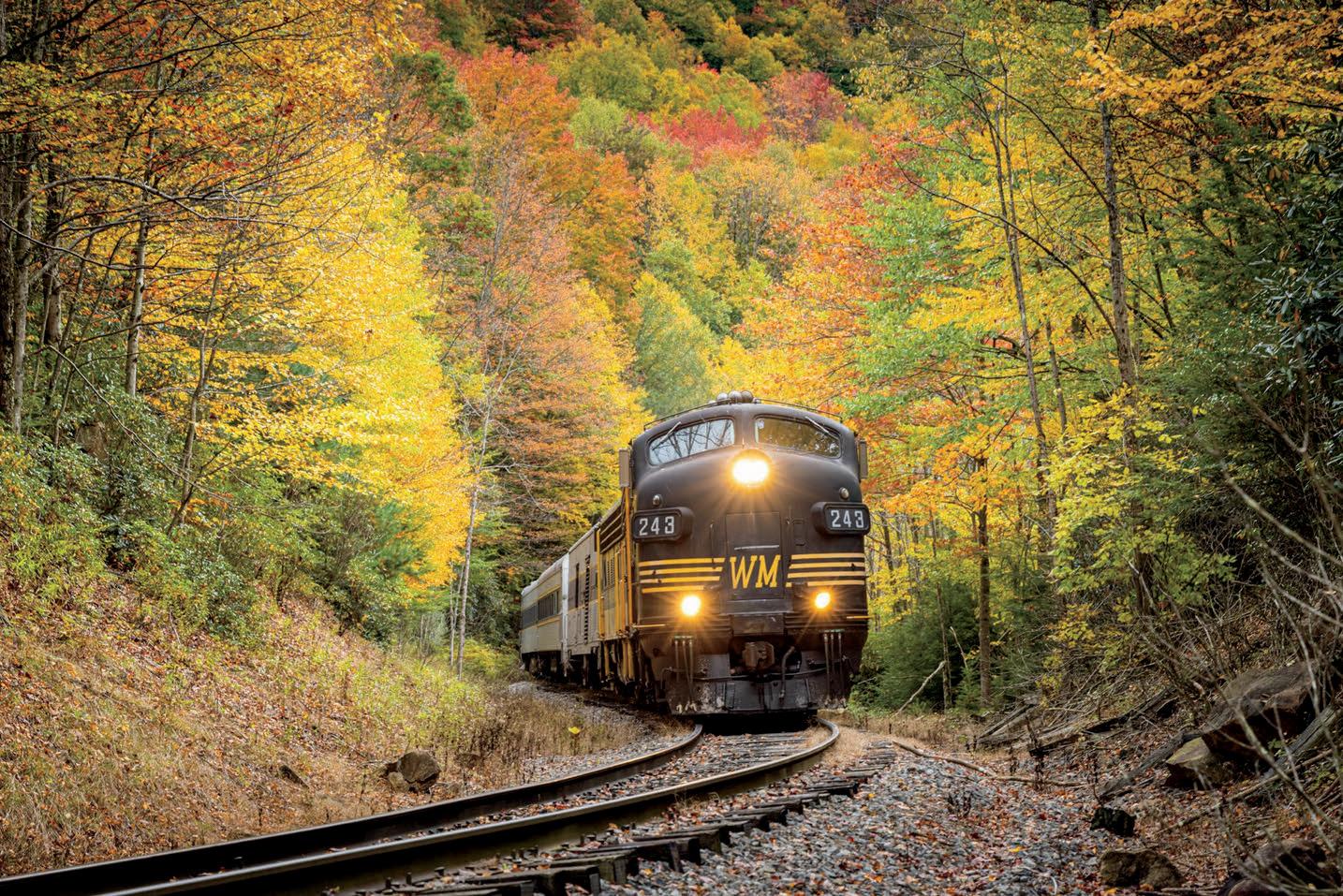
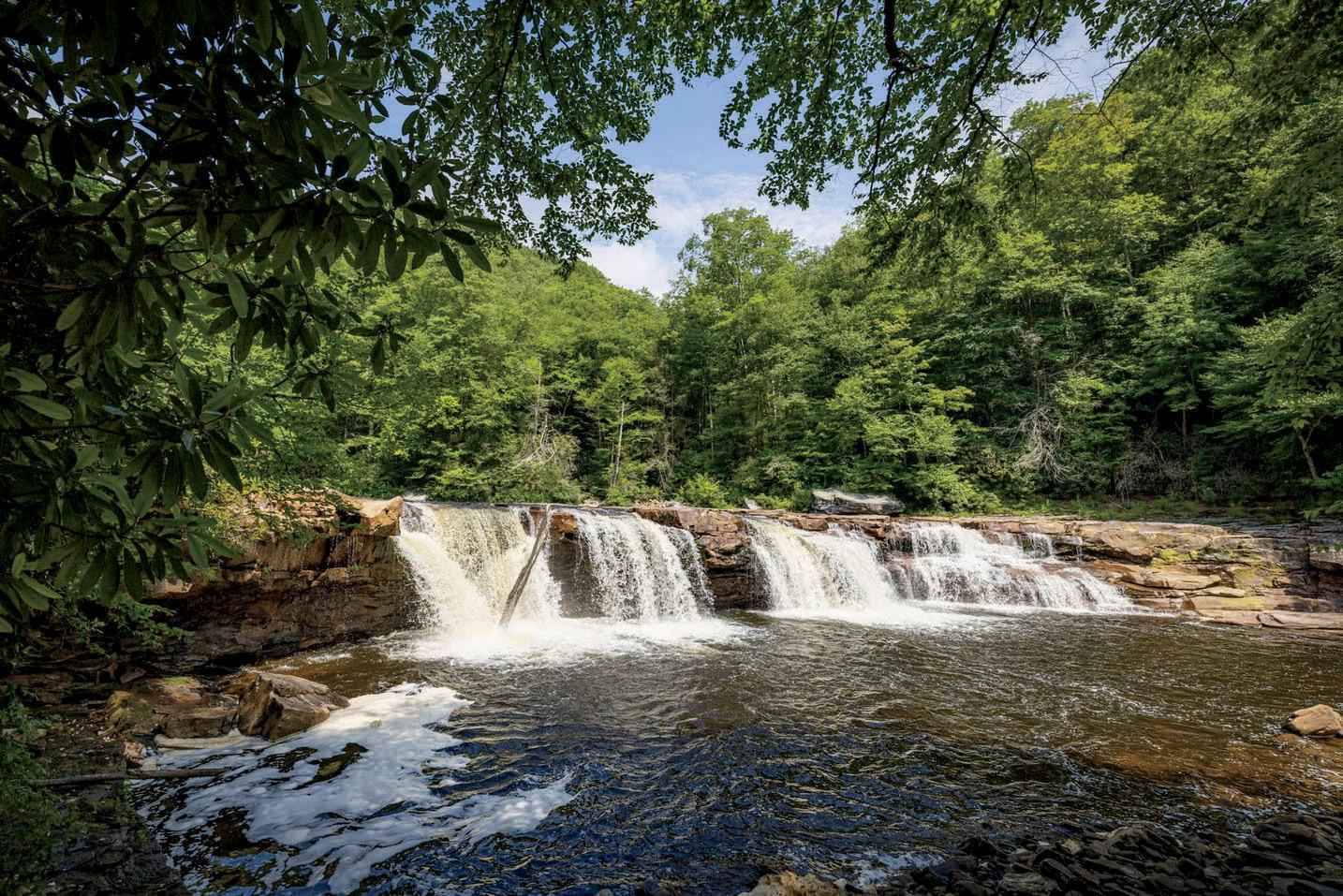
Outdoor Recreation Historic Towns


BY GRAHAM AVERILL
PERSONAL GROWTH IS overrated.
Don’t get me wrong, there’s a time and place for pushing beyond your comfort zone, expanding your horizons, trying new things…all that nonsense. I think that everyone with the means should spend a month or two backpacking across Europe after college, or thru-hiking the Appalachian Trail before settling down and getting a real job. Can’t afford those luxuries? Get a job on a fishing boat in Alaska, or work on a farm in Nebraska. Do something hard that scares you. It’s important. It will make you a better person.
I’m constantly harping on my kids to push themselves and do things they’re scared to do because it’s good for their development as human beings. They’re teenagers, so they’re currently laying the foundation for the adults that they will one day become. Seeking out intimidating situations, like trying a new sport or signing up for a theater class, is integral to that developmental process.
But I’m not a teenager looking to build a strong future. I’m a middle-aged man who has come to realize that pushing myself into situations beyond my comfort zone is exhausting and usually makes me physically ill.
So I’m done with personal growth. This stance goes contrary to the best advice from medical professionals and the “life coaches” that occupy your social media feed. The prevailing thought in those circles is that people should continue to seek growth opportunities as they age. Learn a new language when you turn 50. Pick up a new sport when you see your first gray hair. Learning new skills and getting out of your comfort zone can help you live a longer, more robust life. The mental and physical decline that we see in older generations is often exacerbated by the fact that aging people simply stop pushing
themselves.
But I don’t know, man. I’m tired of being scared and nauseous all the time. Because that’s what personal growth looks like in my case. It looks like me, facing fears and setting aside the limitations I put on myself from an early age, and seeking out situations that involve either boats, sharks or heights. Sometimes all three at once.
In recent years, I’ve found myself on expedition cruise ships, swimming with sharks, and climbing towering cliffs of granite in the pursuit of personal growth. I understand that these are bucket list items for a lot of people, but none of them are in my personal bucket. I never wanted to swim with sharks or spend days on a boat or even climb towering cliffs. I signed up for these adventures specifically because I was scared to do them. I thought facing my fears would somehow make me a more complete person, but honestly, I’ve just spent a lot of time trying to stay calm and not throw up.
Case in point: I spent a significant portion of last weekend hanging on to the railing of a tiny-ass fishing boat, battling an angry sea, and trying not to chum the waters with my breakfast. I put myself in that situation because I thought it would be good for me—give me a chance to face my fears of the open water—but I spent the entire time so sick, I was praying the ship would sink and put me out of my misery.
A few years ago, I decided to confront my fear of heights by climbing a big ass cliff. I like the physical act of rock climbing; the challenge of figuring out a route, the strength and mobility it takes to ascend from point A to point B, but the idea of clinging to a rock wall hundreds of feet above the ground makes me shake and sweat with anxiety. Something about falling to my death is unsettling. Weird, right?
So, I thought climbing Looking Glass Rock, a 600-foot-tall granite monolith rising from the belly of Pisgah National Forest, would be a

great way to confront that fear and spur personal growth. I followed a guide up the Nose, which is the classic route up the face of the rock, a 5.7 three-pitch traditional route that has climbers trusting the rubber on the soles of their shoes as they smear and press their feet against the rough granite as they move higher and higher. Everyone says it’s a beautiful climb, and that the forest spreads out in a carpet of green below you, but I wouldn’t know because the only way I could move forward was to keep my eyes glued to the wall two feet above my head. I may as well have been climbing inside a gym.
More recently I found myself on a 100-passenger expedition cruise ship because I hate boats and the ocean terrifies me, so what better way to push past those limitations than by spending a week on a boat in the middle of the ocean? I coped by staying hopped up on seasickness pills and a steady stream of cocktails.
Agreeing to speak in front of crowds, snorkeling with sharks, climbing 13,000-foot peaks with exposed ridge lines…I’ve spent a lot of time in the growth phase as a middle-aged man, and I’m not sure it’s done any good. The ocean still makes me nervous. I’m still worried
I’m going to fall off a cliff.
Maybe I should just live with the irrational fears and limitations that have guided me through life thus far. I’m not a teenager piecing together the building blocks of my future. I’m a 48-year-old dad who has probably reached the ceiling of his potential anyway, so why keep pushing?
Personal growth is a young person’s game. I’m tired of being nauseous all the time.
So I’m done. No more personal growth. I will only seek out experiences that are well within my comfort zone. Instead of sharks and small boats, I’ll spend my time watching reruns of ‘90s-era sitcoms and cruising the same intermediatelevel mountain bike trails. I will become excellent at bouldering V-1 in a climate-controlled gym.
Except I’ve already signed up for a week-long survival skills course where I’ll get dragged out into the desert of Utah until I’m so cold and hungry, I have no choice but to learn how to build a shelter, find food, and start a fire. This scares me on multiple levels (I need to snack constantly and typically need gasoline to start a campfire) and is essentially designed to make me a better person. So I’m gonna see this one through. But after that, sitcom reruns and V-1 bouldering problems for the rest of my life. I swear.







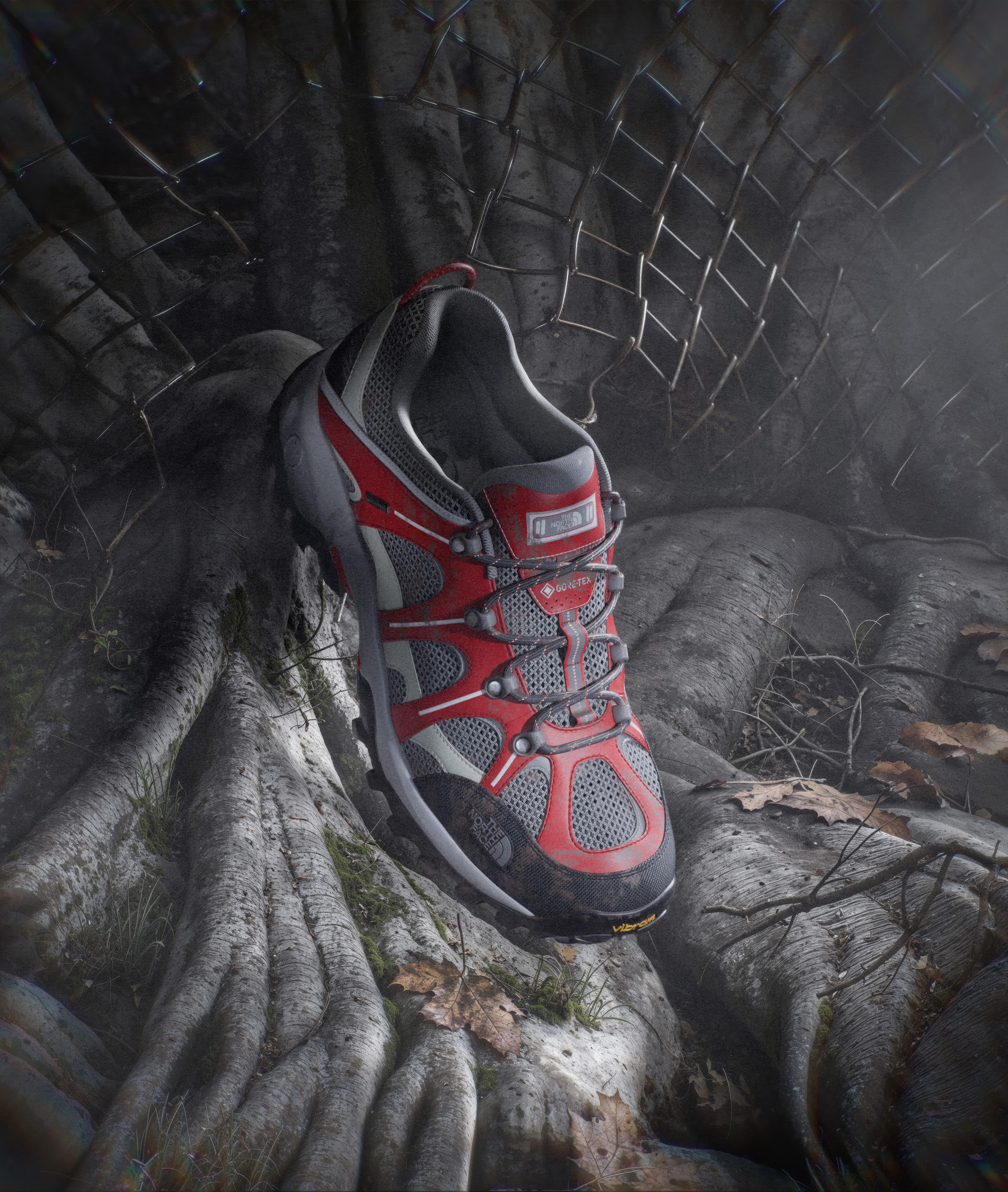
Crisp fall days are prime time to get out and hike a few miles or head out for an overnight in the wilds. To that end, we give you gear to make your time on the trails better.
BY DOUG SCHNITZSPAHN
Pedroc Air
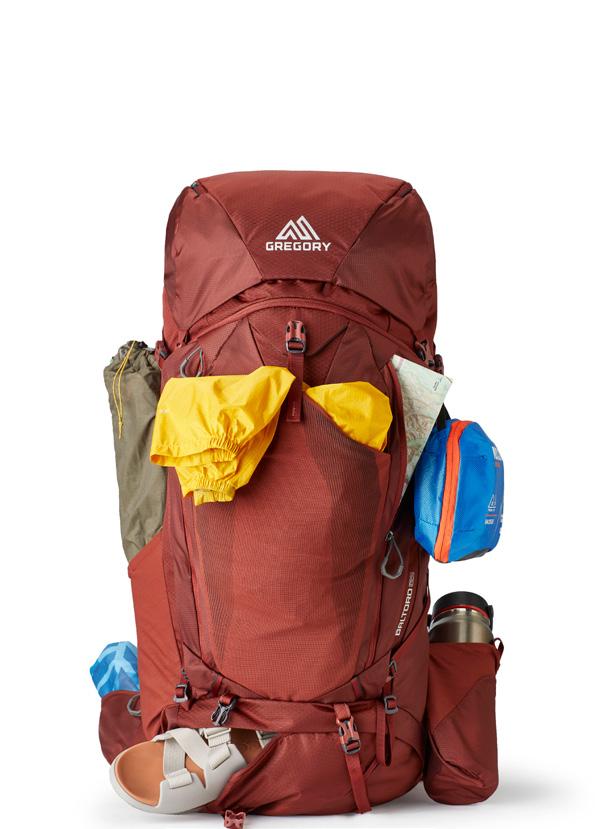
This speed hiker is our go-to shoe for daily hiking and quick summit scrambles. The knitted upper breathes like a champ and the whole shoe battens down for a fit that’s both comfortable and confident, thanks to a Kevlar wrapping net that secures your foot even when you are navigating loose rock and wet roots. Hell, we feel so good in them we wear them to work, too. $160; salewa.com
Hedgehog 06
TNF updated a classic from 2006, beefing up this versatile hiker with a 100% recycled GoreTex liner and sticky Vibram sole that can handle all the elements of Blue Ridge trails in the fall. It’s casual enough for day hikes with the family but sturdy enough for light backpacking forays, making it the ideal choice if you want one shoe to do it all. $179; thenorthface.com
Re:Connect
With the retro flair of a 1980’s tennis shoe, this hiker feels right straight out of the box and even better when you put it to the dirt (or the pavement). It’s a godsend for those of us with floppy dogs, since there’s plenty of room in the forefoot and locked-in support in the heel. It’s no slouch, though: An Xlite outsole serves up performance with grip and flex on the trail. $140; vasque.com
Randir Mid GTX
Rather than burden you with the overkill of big backpacking boots, these sturdy women’s hikers offer up all the support and stability of a heavy shoe but feel more like a light hiker—just what you want when you are already hauling

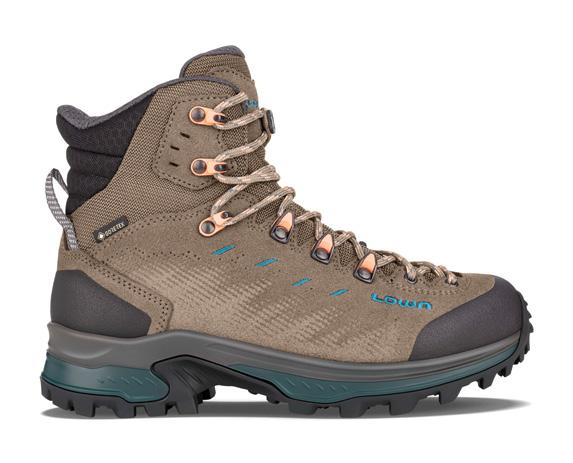

a big load on your back. The women's-specific last and a design that cradles the ankle and heel in position are the key to a fit that won’t cause blisters but will keep you on your feet when you are navigating steep descents or technical uphills. $295; lowaboots.com
Hike Cushion
You can test all the boots you want without finding the perfect fit for your unique foot. That’s where a good insole makes all the difference. (Plus, brands often skimp on the insole since it's something customers so often change out.) If your tootsies crave comfort, these insoles offer up just enough support and flex to take some of the burden off your feet, while also giving you plenty of arch structure. A welcome heel cushion takes some of the ouch out of each step, too. $55; superfeet.com
Trailblazer 25L
Our go-to pack for a wide range of hikes, this hauler was designed with Montane’s well-known trail running smarts—it’s light, easy to batten down when you are carrying less in it, and it doesn’t jostle around when you are on the go. Most of all, it’s the most comfortable day pack we have put on after nearly 30 years of professional gear testing. A clever strap system means you can carry all sorts of extra bulky stuff (a tenkara rod, a helmet, your partner’s bulky shell) if the need arises, and the treated nylon material sheds off precipitation. $180; us.montane.com
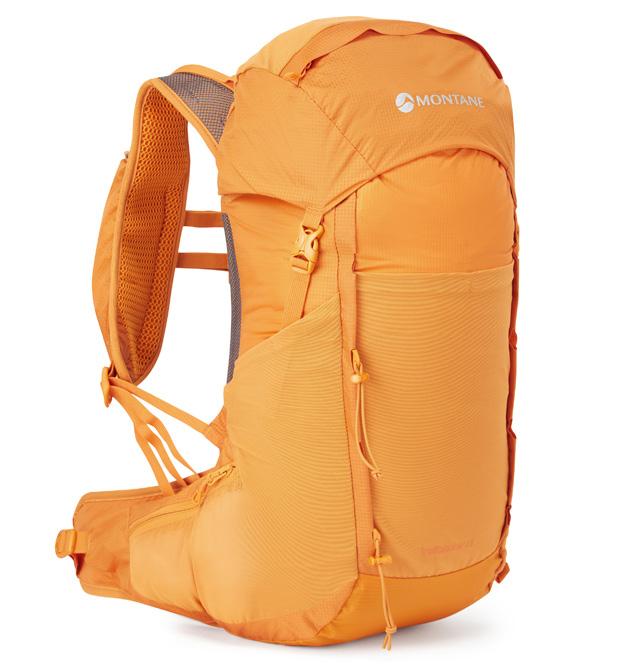


Mira 32
Big enough for a hut overnight or gear-intensive activities (or if you are carrying the bulk of the family’s gear), this day pack on steroids is just as functional as it is comfortable. Credit the latter to cushy shoulder straps and a breathable mesh back panel you’d expect on a far larger pack. It’s stocked for adventure with a rain cover, trekking pole and ice ax straps, and a 2.5-liter hydration reservoir, making it the top choice for a wide range of big days. $220; osprey.com
For the past decade, Gregory’s Baltoro series has impressed us when it comes to providing all you need for backpacking adventures. Start with the fit: The plush and independently rotating hip belt and harness can be custom fit at your local Gregory dealer, and on the trail the whole system evenly distributes big loads so you feel spry rather than overloaded, no matter how full you stuff the roomy 65 liters of space (which, we may add, easily takes an unwieldy bear container). Add in smart details, like a minimalist removable day pack on the inside and a side water bottle holder, and you have a winner for multi-day excursions. $225; gregory.com

Fuson 2L Reservoir


Upgrade any pack with the latest iteration of Camelbak’s tried and true hydration bladder. The originator of the concept built a better reservoir here with a handle and zipper system that makes it easy to fill—and clean. Bonus: The big bite valve delivers more water. Also available in a 3L version ($57). $55; camelbak.com
Delta Hoody
The ideal cool-weather hiking jacket and musthave backpacking layer, this fleece hoody provides plenty of warmth when you need it but won’t sweat you out when you get moving, thanks to a hollow-core fiber that keeps warm air close to your body but still breathes. And don’t just wear it on the trail, because it looks good out on the town, too. $220; arcteryx.com
Anderson Shirt

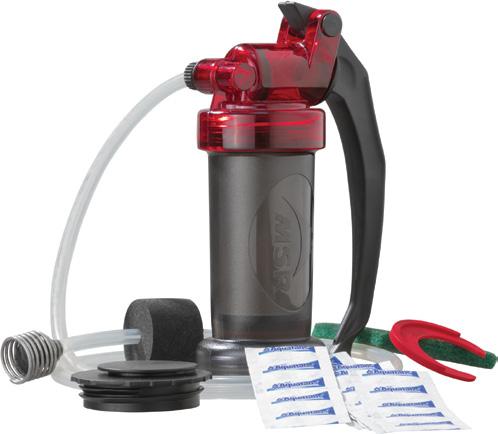

Black Series FX Carbon
This suave hiking shirt says you have some trail cred without the technical dorkiness of some outdoor brands. Made with a mix of comfy, stretchy, and quick-drying materials it’s technical enough to use in the wild but it's still casual enough for a round of golf or drink with friends. $80; flylowgear.com
Abisko Värm Trekking Tights
Indeed these Swedish tights made for the trail are varm thanks to double-knitted stretch fabric with a brushed inside and wind-blocking fabric in just the right places that keeps them cozy. That makes them just the ticket for fall hikes and runs when the temps feel a bit Scandinavian. $175; fjallraven.com
Poles make backpacking so much easier, giving you more pep in your step and involving your arms in your gait (eliminating that swelling in the hands you can sometimes get when you hike with a big pack). We like them so much we use them on pretty much every hike. Built with carbon and a breeze to adjust between 110-130 cm (or to break down and stash), these sports cars of poles also feature a comfy cork grip that’s easy on your hands during long days on the trail. $270; lekiusa.com
MiniWorks EX Microfilter
The latest version of this classic design is a musthave for any backpacking trip, and a smart carry for hikes when you would rather not load too much water in your pack. The pump pushes dirty water through the replaceable carbon/ceramic filter with confidence and it's easy to clean. It’s the reliable system you need out there. (But for extra confidence you can back it up with MSR’s chlorine-based Aquatabs® purification tablets that add viral defense). $120; msrgear.com


Your tent can take up a lot of space and weight in your pack. Not here. This sturdy, easy-to-setup, two-person shelter tips the scales at just 2 pounds, 8 ounces and is easy to stuff into smaller overnight packs, thanks to the built-in Divy Cube stuff sack. Best of all—much like Dr. Who’s TARDIS—it feels bigger on the inside than it looks on the outside. Set it up without the tarp for plenty of airflow or take advantage of the roomy vestibule to protect your packs in bad weather. It comes in one-person ($400) and three-person ($550) versions, too. $430; nemoequipment.com
Neutrino 400
It’s shocking how small this bag packs down considering how much warmth (rated down to 19 degrees F) it provides when you curl up inside it. Made with recycled 800-fill goose down and tough Pertex Quantum material on the outside, it’s a bag you can rely on when facing chilly temperatures and weather elements out in the backcountry. Concerned about sustainability? Instead of touting claims, Rab gives you full data on the materials it uses here. $435; rab. equipment
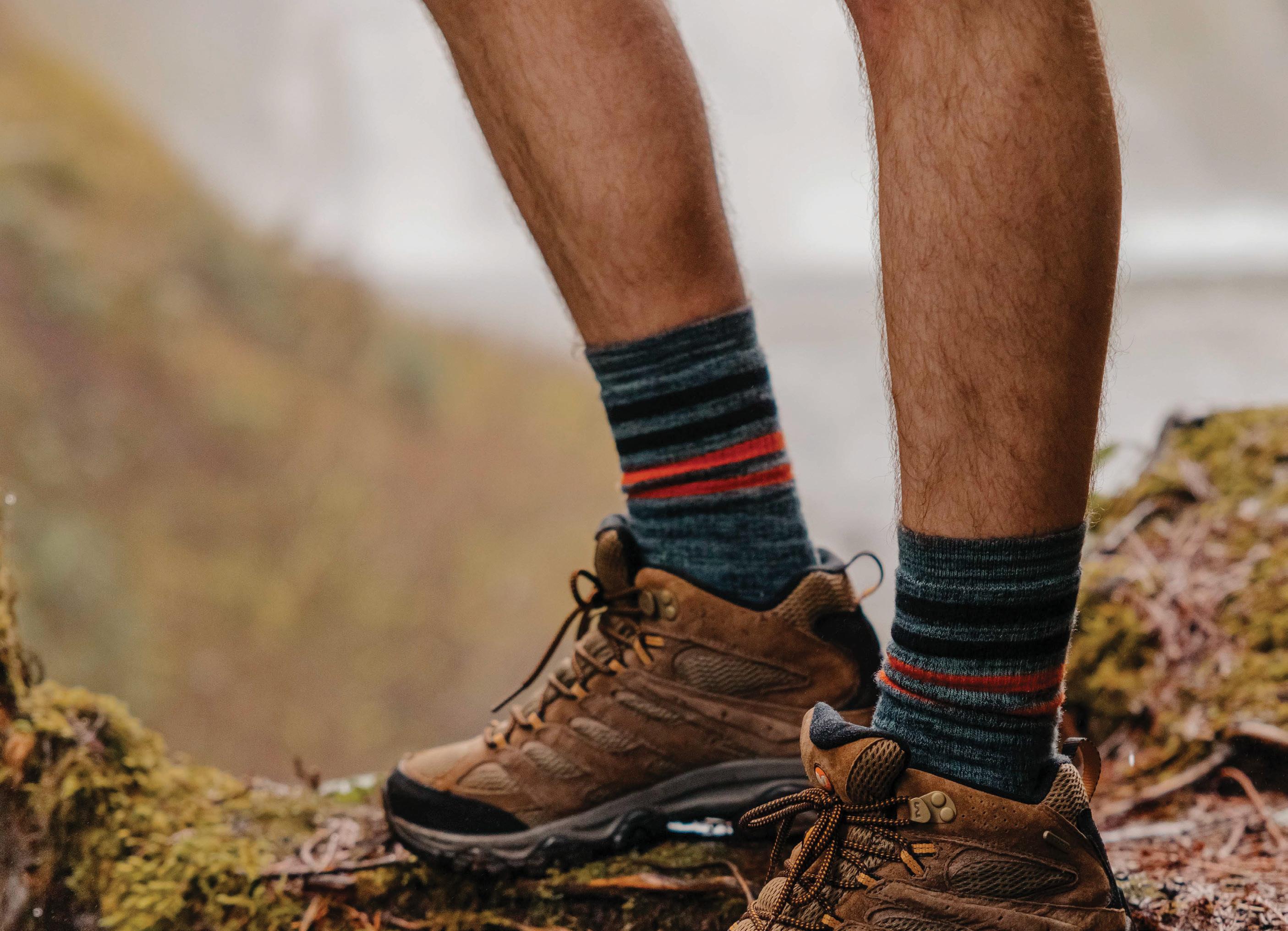
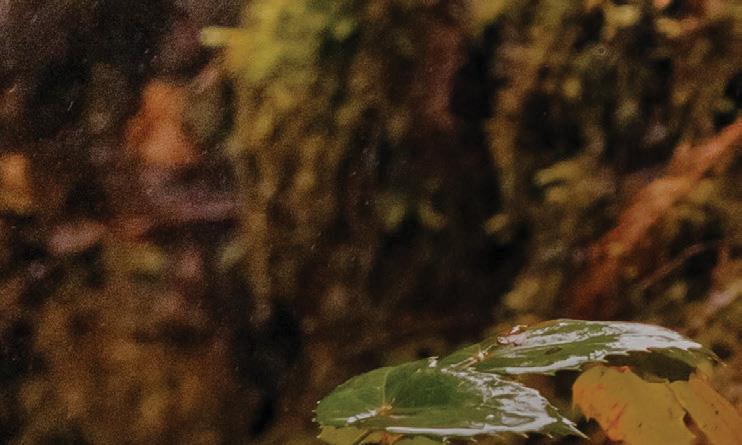

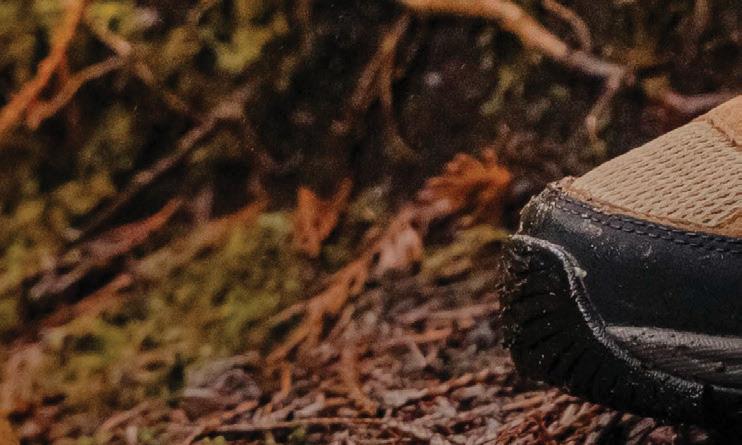

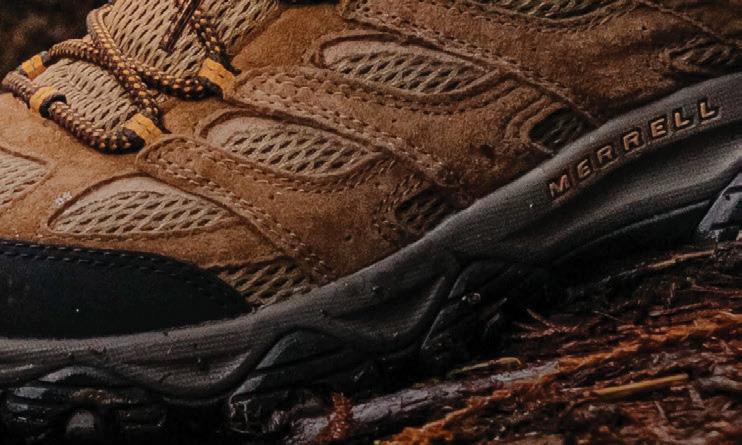

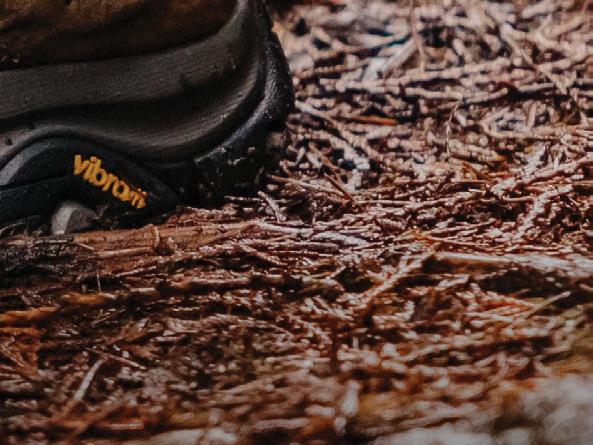


BY JEDD FERRIS AND DAVE STALLARD
curate a playlist of new music, mainly focusing on independent artists from the South. In October we’re highlighting new tunes from Shovels & Rope and American Aquarium.
“Crier”
“It’s OK to be a crier,” howls American Aquarium leader BJ Barham in this twangy, punk-fueled banger from his North Carolinabased band’s new album, “The Fear of Standing Still,” which was produced by Shooter Jennings. The hard-hitting track makes a case for letting emotions flow, even in times when insecurity takes hold. – J.F.
“Perfection”
Longtime funk icon Bootsy Collins might be a septuagenarian, but his musical libido still pumps hard. On “Pure Perfection,” the first single from his new record, “Album of the Year #1 Funkateer,” Collins channels a character he has nicknamed Bedroom Bootsy, and the sonic results are exactly what you would expect—sultry, erotic, and innuendo laden, with a bass riff that splatters through your speakers. Slap a disclaimer on this one: Collins shouldn’t be held responsible for anything that might happen after you and your partner drop the needle on this one. – D.S.
“Names”
Virginia tunesmith Will Overman offers a raw take on anonymous hook-up culture in this rootsy earworm released as a standalone single back in the summer. Written
following a tough divorce, “Names” finds Overman sharing that random encounters can be discomfiting, while also admitting that a little human touch is hard to resist. – J.F.
“I Will Not Go Down (featuring Billy Strings)”
Tennessee’s Amythyst Kiah delivers anthemic lyrics of perseverance in this stomping acoustic tune that features a fleet-fingered guitar assist from Billy Strings. Kiah repeats the song’s title like a determined mantra while Strings lifts her fierce determination with nimble shredding. The track comes from Kiah’s new album, “Still + Bright,” which comes out October 25 and features additional guest spots from Butch Walker and S.G. Goodman. – J.F
“Moody River”
The 16 songs on his new album, “Heartbreak, Misery, & Death,” are a collection of old folk tunes Grayson Capps heard being played by his father and his musical friends that, ultimately, charted the course of his musical life. This rendition of Doc Watson’s “Moody River,” performed by Capps and his longtime playing partner Corky Hughes, showcases the duo’s intricate guitar work and Capps’ resonant tenor vocals in what is a powerful homage to one of his greatest musical influences. – D.S.
“Two Wolves”
The early work of Shovels & Rope, the husband-and-wife duo of Cary Ann Hearst and Michael Trent, followed a lean country direction, but on the new album “Something is Working Up Above My Head,” the group adds some rock edge to its minimalist approach. A standout from the record, “Two Wolves,” is a scuzzy, hypnotic blues jam with

“North American Grain”
“Don’t Wanna Say Goodnight”
The opening bars of “Don’t Wanna Say Goodnight” bring to mind a galloping posse crossing a dusty desert horizon. The ensuing crescendo of notes, punctuated by frenzied fiddle and crunchy electric guitar, swing the listener away from spaghetti western reverie and back to Wyatt Flores, the 23-year-old Oklahoma singer-songwriter who has quickly become a rising star in country music. So perfectly capturing the electricity of new love, Wyatt delivers, in both performance and songcraft, a mastery that belies his relative youth. – D.S.
Singer-songwriter Django Haskins, longtime guitarist and frontman for Chapel Hill’s the Old Ceremony, didn’t touch the brakes during the forced slowdown caused by the pandemic. Haskins set to writing, cranking out some 115 new songs, from which he and his mates chose 11 to become the band’s new release, “Earthbound.” On “North American Grain,” Haskins weaves a metaphorical masterpiece; depending on what the listener hears, it could be an ode to love’s rise and fall or the demise of the agricultural South. Regardless of interpretation, Haskins beautifully captures the deep ache of something lost. – D.S.
To hear these songs and more, follow the Blue Ridge Outdoors’ Trail Mix playlist on Spotify.










